Exiting Cabinda took us around one hour and a half - there was no problem really, but they just kept on running around with our passports before sitting down and just stamping them. Then it was the turn of the Republic of the Congo, and boy did they surprise us - in no more than ten minutes both our passports and the Carnet were stamped and we were free to go. Africans too can be efficient. I wish the bastards in Kinshasa used it as an example!
As we arrived in the coastal town of Pointe-Noire we were terribly disappointed to find out that contrary to our greatest hopes there was no Gabonese consulate there and we had to undertake the long, bad road to the capital, Brazzaville, as we needed to obtain visas for Gabon. From the good old border post at Luvo it would have been a few hundred kilometers of (reportedly) good tar, but we had no other choice but to tackle some more bumpy dirt and sand.
Since traditions are a good thing, we decided to spend our first night in Congo once again, by the church. Of course there was a Mass and later on a choir practice that night, all African style, with joyous melodies and lifely rhythms. Those same rhythms reminded us of that time in Kenya when our bike was loaded onto a pickup truck and we sat in the front with a young priest at the steering wheel, rocking down the incredibly bumpy road to Nairobi. The same religious songs had been revolving in the CD-player for almost 24 hours in a row, engraving the East-African beats deep into our sculls. And here we were again, hearing those rhythms in Congo! As it comes out, those rhythms actually originate from Congo, which is, according to some books, believed to be the heart of African music. Well, the reality is not so black-and-white of course, but we must admit that the Congolese music does reach across the borders.
...::: LISTEN the live mass at Dolisie Catholic church in Congo :::...
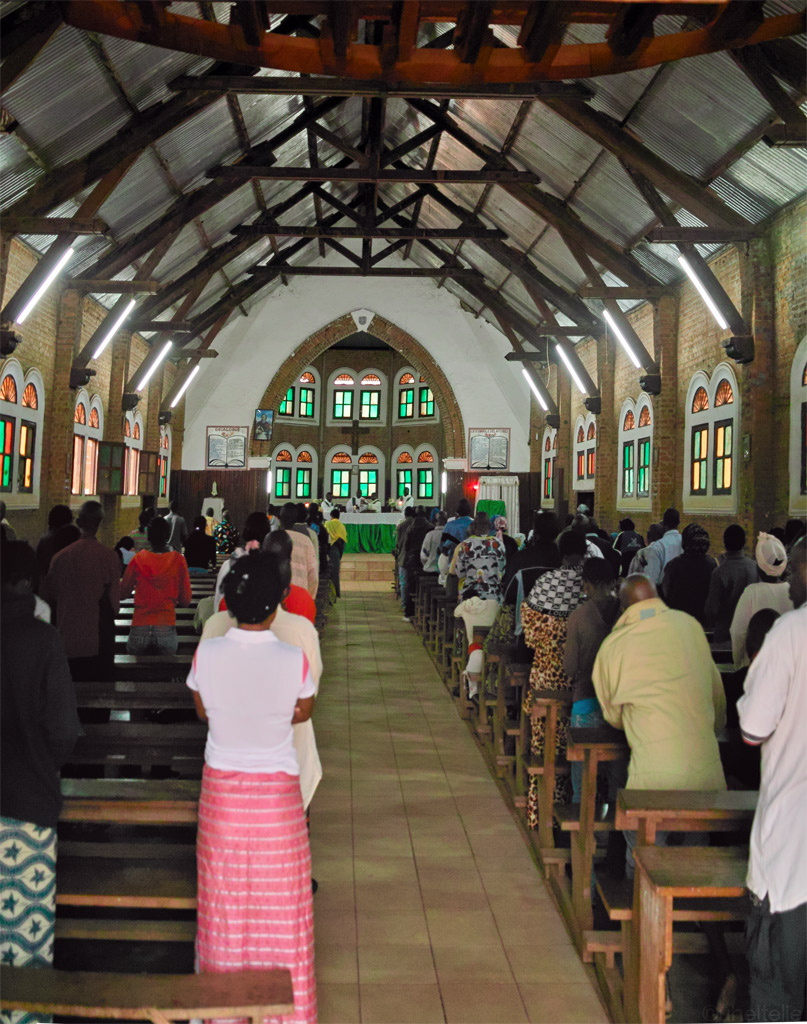
Serving the God - same moment when the sound was recorded.
… and from the rehearsal after the Mass, which was quite extraordinary for us as they also used a synthesizer, a bass guitar and a decent drum set, not just vocals (which were actually pretty professional):
...::: LISTEN live pratice in Dolisie, Congo Republic :::...
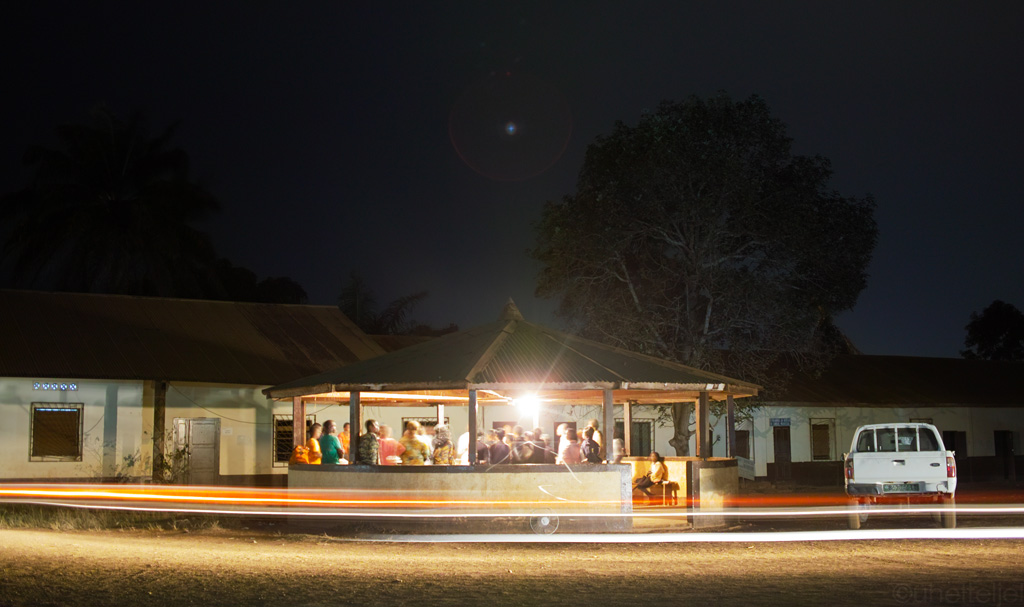
Practice in the dark as seen from our tent.
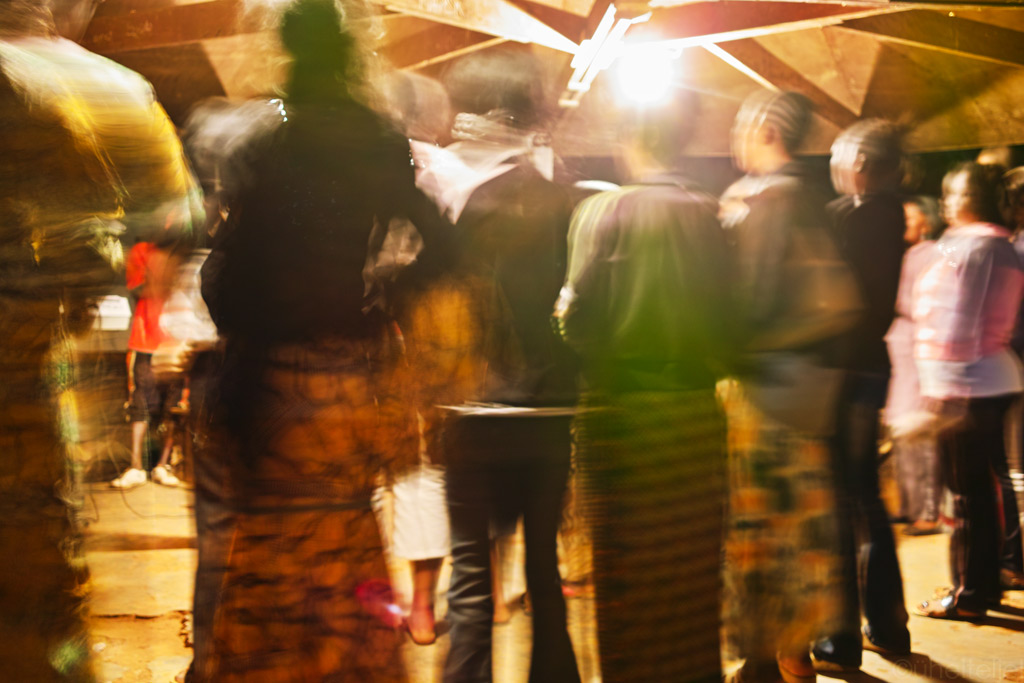
Late night songs.
After the heavy religious charge we could cool down at the more mellow sounds from the local radio which quickly took us to the wavelength of a good sleep - a tough day was behind us.
The next day was even longer and tougher, the road was a lot bumpier, covered in the powdery dust that left it all to the imagination as to what could be underneath - a deep hole, a stumbling stone, or… a nail?
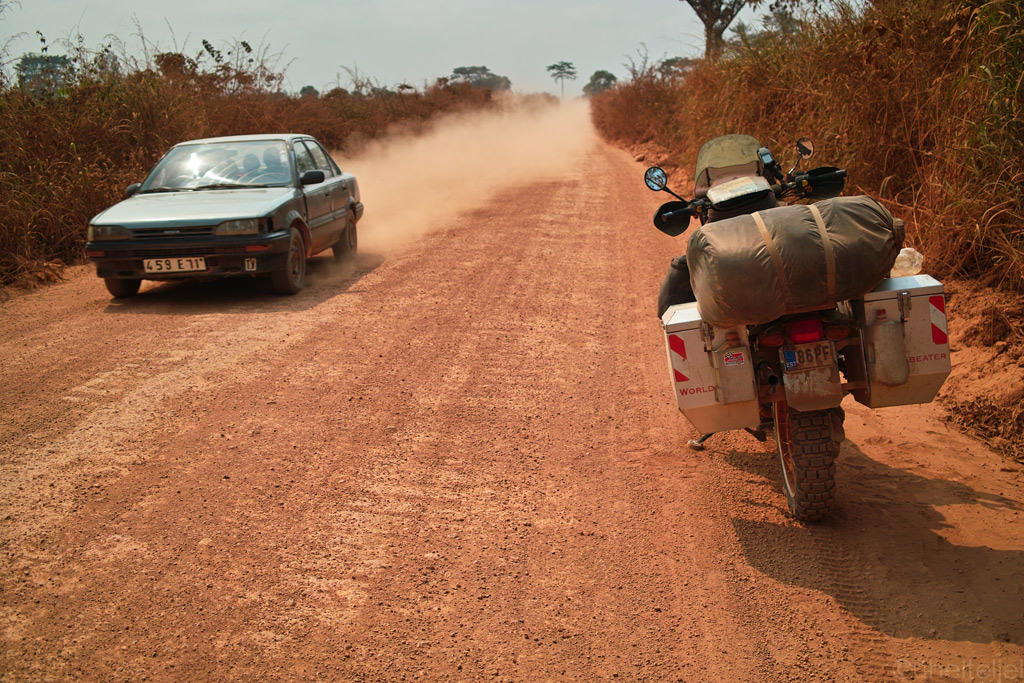
The dusty road to Brazzaville
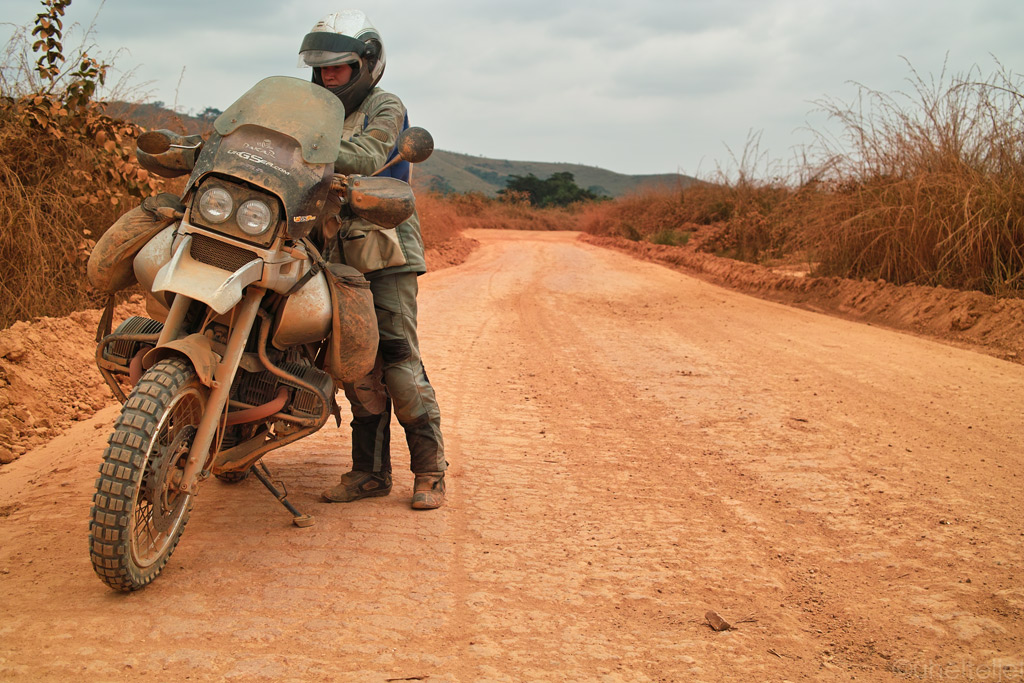
Hard packed dirt.
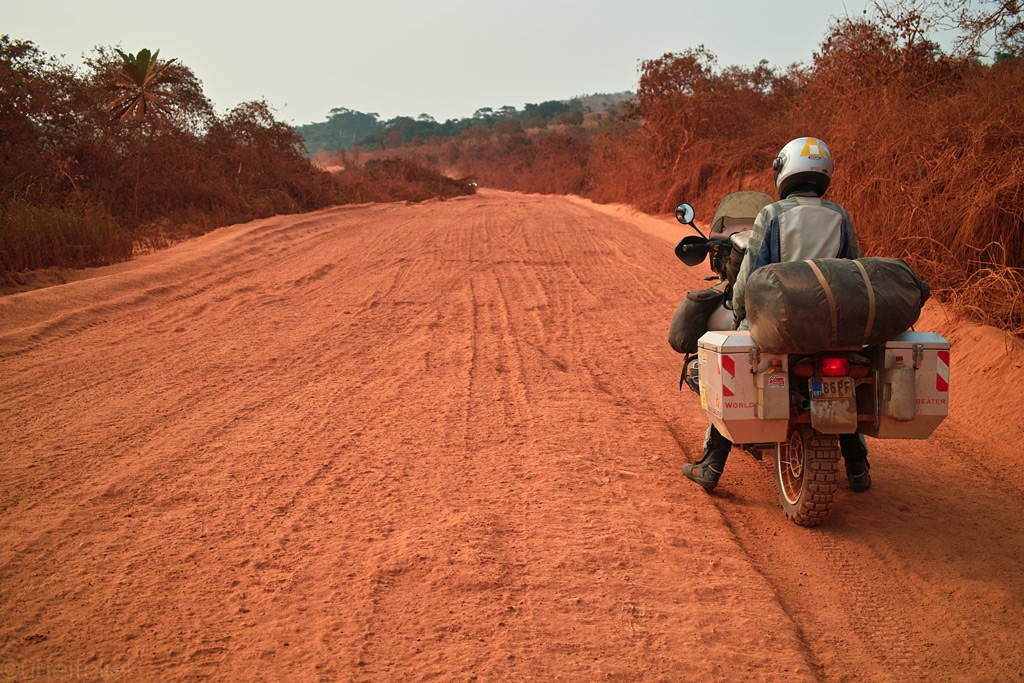
Corrugations in the dust.
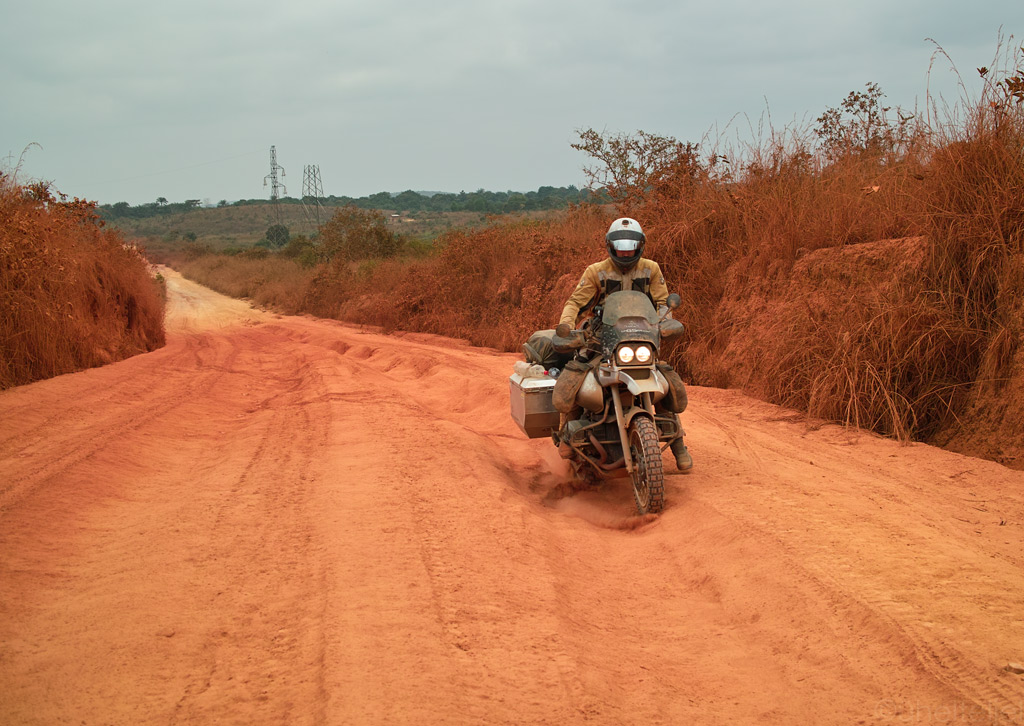
And that is a major road in the Congo?
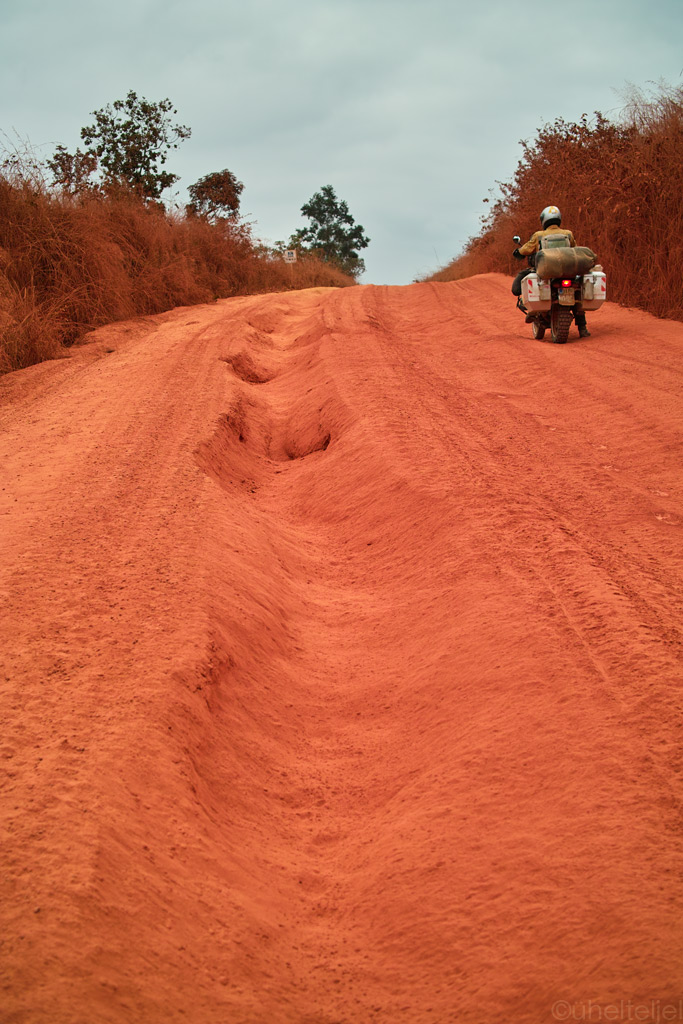
Good luck avoiding those ruts with a truck.
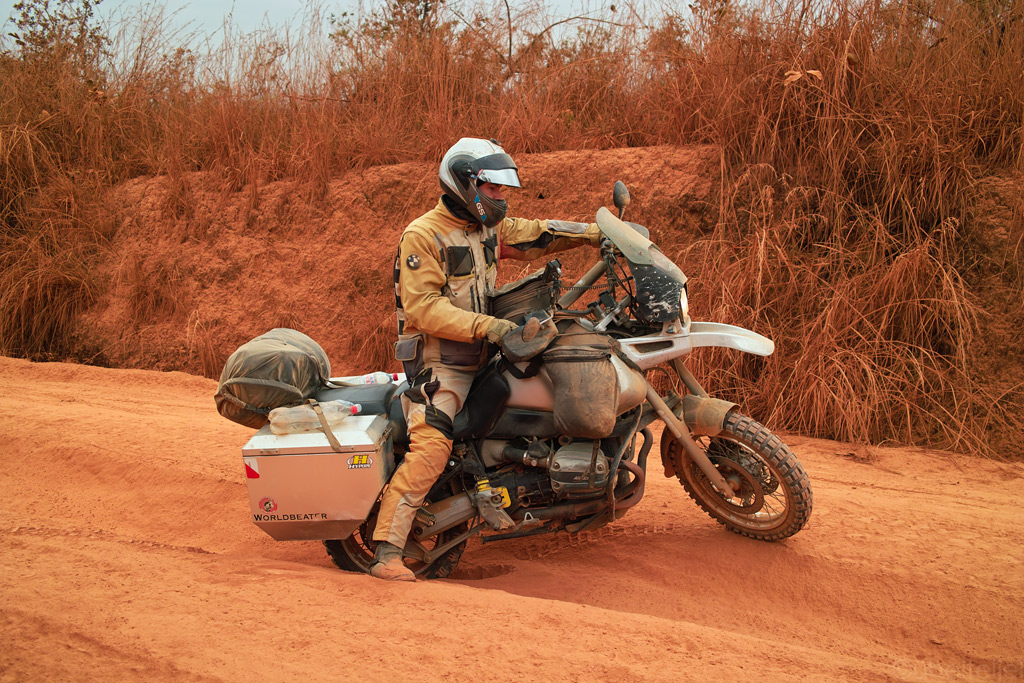
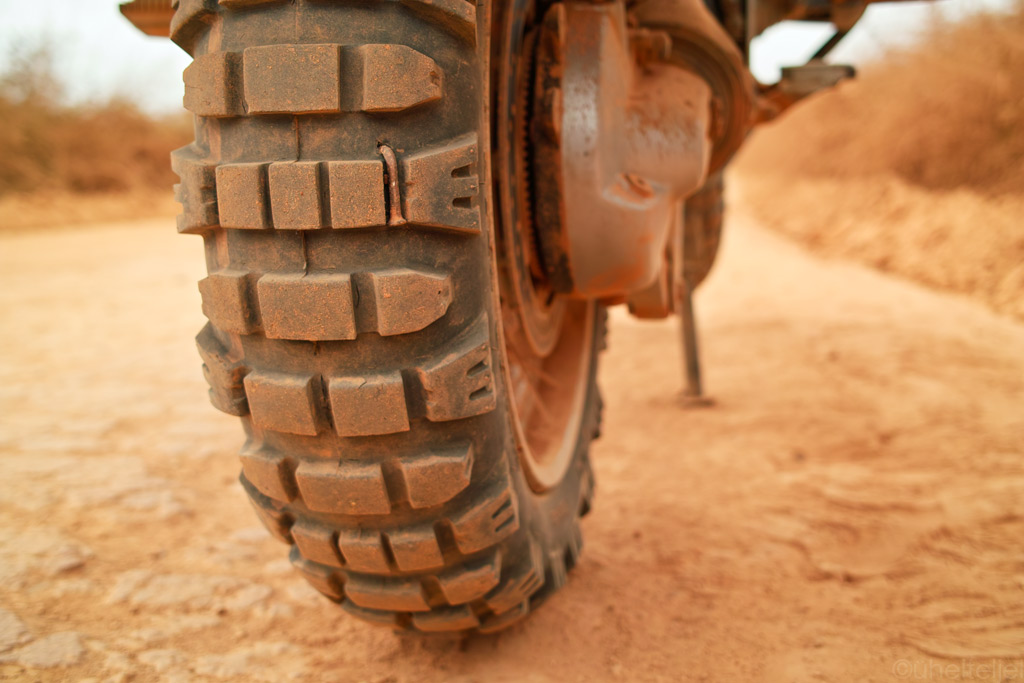
A nail.
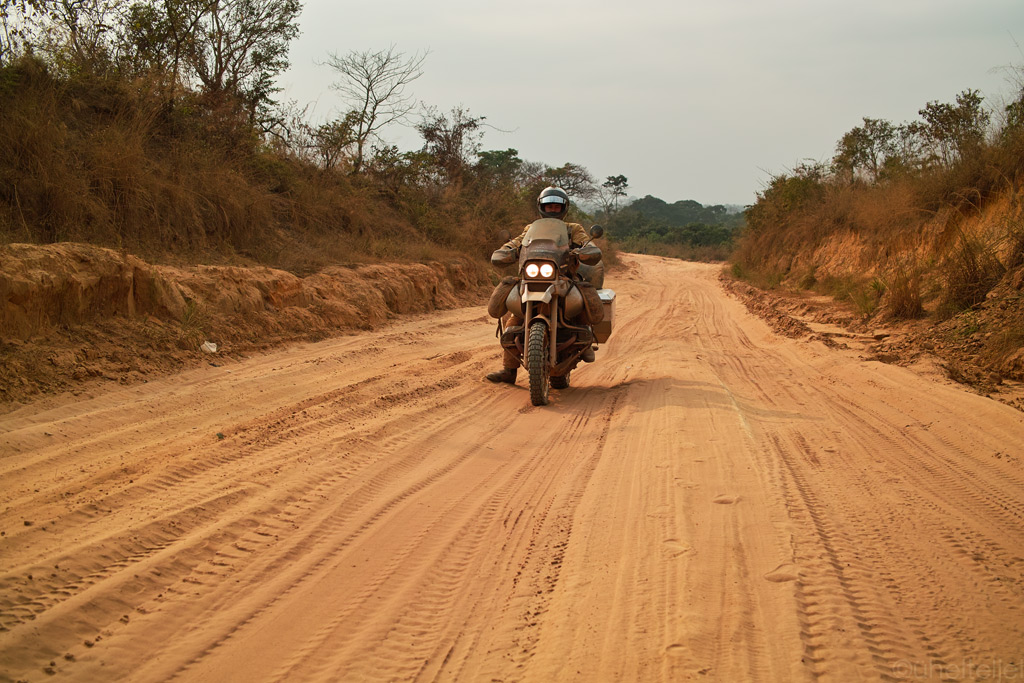
At the very end, some fifty kilometers of deep sand that made it very tiring and slow.
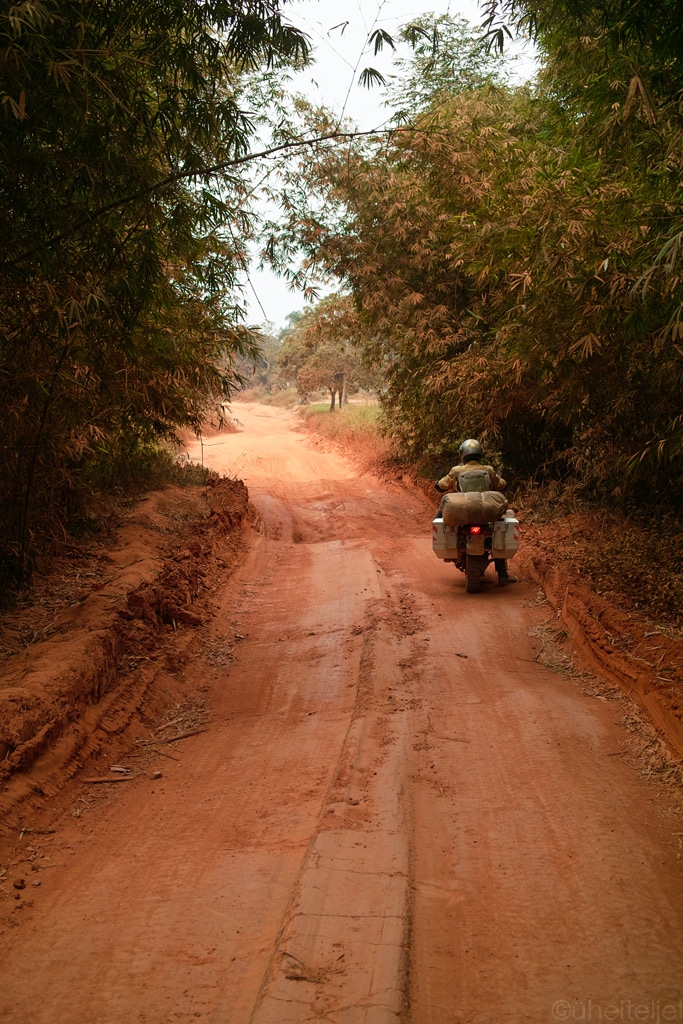
Then some hard packed dirt through the jungle - here supposed to be the infamous Congo bandits, fortunately we didn't see any around.
Exhausted, we arrived in Brazzaville, one of the smallest capitals in Africa. Luckily there is a place for overlanders to stay for free, but we did not want to stay for too long as the city itself is expensive and the air is terribly polluted. But as it goes, we ended up staying a whole week, just to arrange for some visas so that we could skip a few capitals on our way up the West Coast - we haven't yet found a city in Africa that would appeal to us, they all seem just big, dirty and chaotic with not much to see, so if there is a way around them, we shall use it! All in all we acquired visas for Gabon (70 USD), Cameroon (100 USD) and Nigeria (65 USD), which once again reminded us of the extortionate visa costs in West Africa. Luckily, those did not have any absurd requirements, although Gabon wanted to see a "hotel reservation" and Nigeria invited us for an interview:
- How are you planning to cope in Nigeria? Do you know anybody there?
- No, but if we are in trouble we ask the locals for help.
- You ask strangers for help? How can you trust them?
We still believe that the majority of people in the world only have good intentions, and you really have to be unlucky to stumble upon the bad guys.
While doing our embassy runs we had plenty of time to do some things on the bike. Such as washing, for example. The last time I washed it was in Cape Town, I believe, but now that it had been on the sea, it was essential to get the salt off before it would start working on the bike's life support systems.
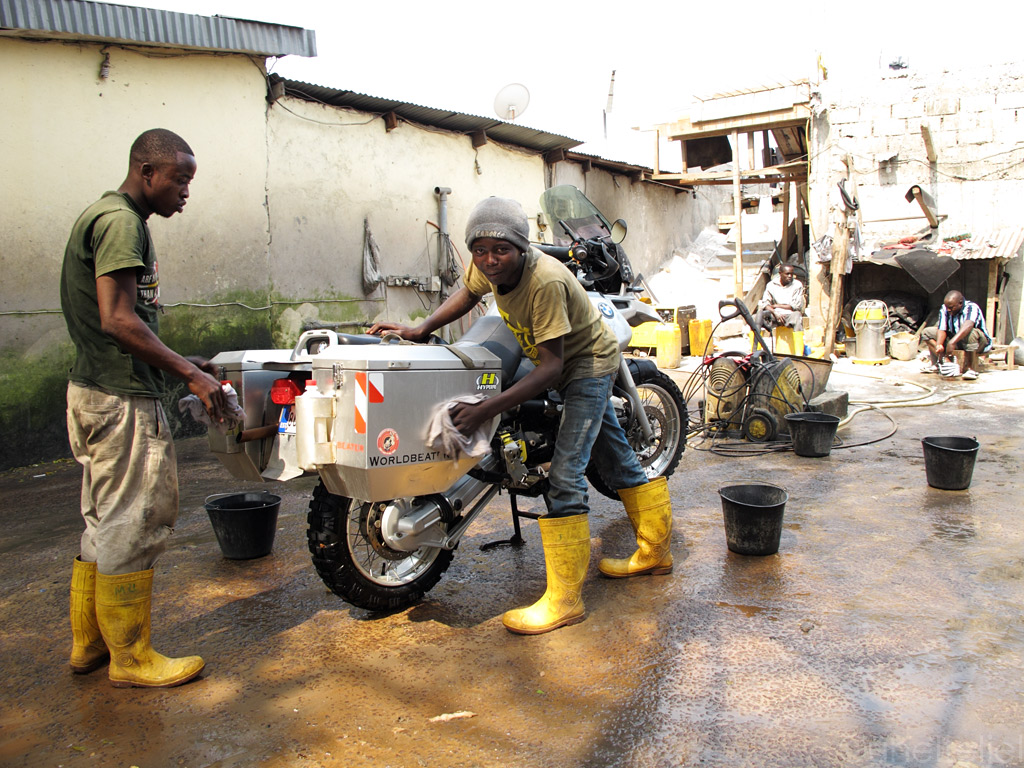
How shiny it became!
Also, we tried fixing the rear brake hose that had been leaking for a thousand of kilometers or so, so we'd been riding without the rear brake. No spares available in Brazzaville, of course, but the president's motorcycle escort mechanic by the name of Elvis came up with a half-solution that allowed us to use the rear brake at least a little, until we could find an original part from somewhere. I suspect it was the same rock that damaged the ABS-cable in Namibia that also finished off the brake hose.
Meanwhile, some good music from Brazzaville radio:
...::: LISTEN Radio in Brazzaville playing Congo music (I) :::...
...::: LISTEN Radio in Brazzaville playing Congo music (II) :::...
By the way, Brazzaville and Kinshasa are two capitals that are the closest to each other in the world, only divided by the Congo river.
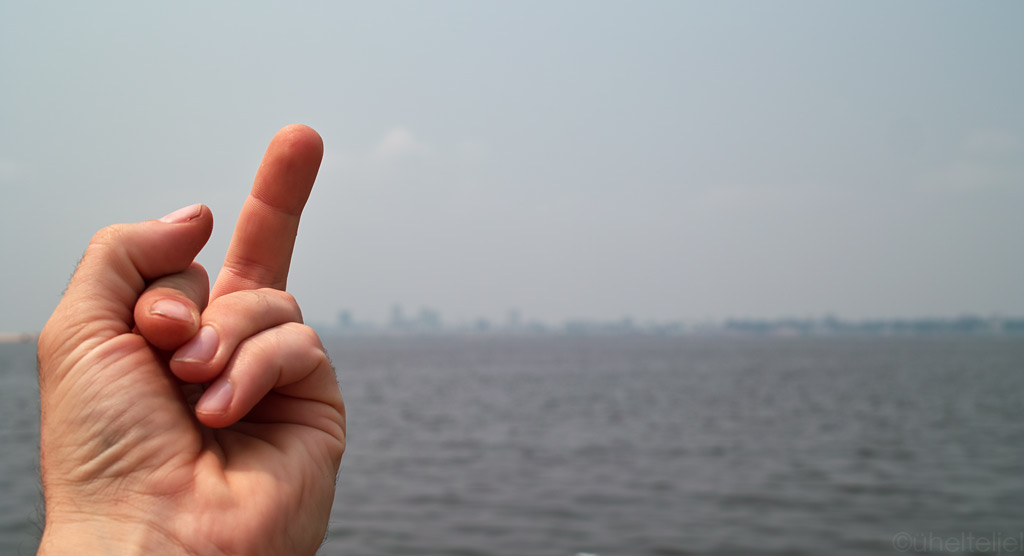
Our opinion on the subject. Kinshasa in the distance.
From Brazzaville we headed north, first for a couple hundred of kilometers on decent tar which just recently only stretched to Oyo, the Congolese president's home town, but that has been extended to as far as Okoyo (very confusing those place names!). From there it is only some hundred kilometers, but those are the kind of kilometers that you'll remember for the rest of your life.
So what ensued was sand, and a lot of it. Although for the first twenty kilometers or so it was quite easy, making statements from other travellers that it would take us a whole day to cover the distance to the border, sound a little exaggerated.
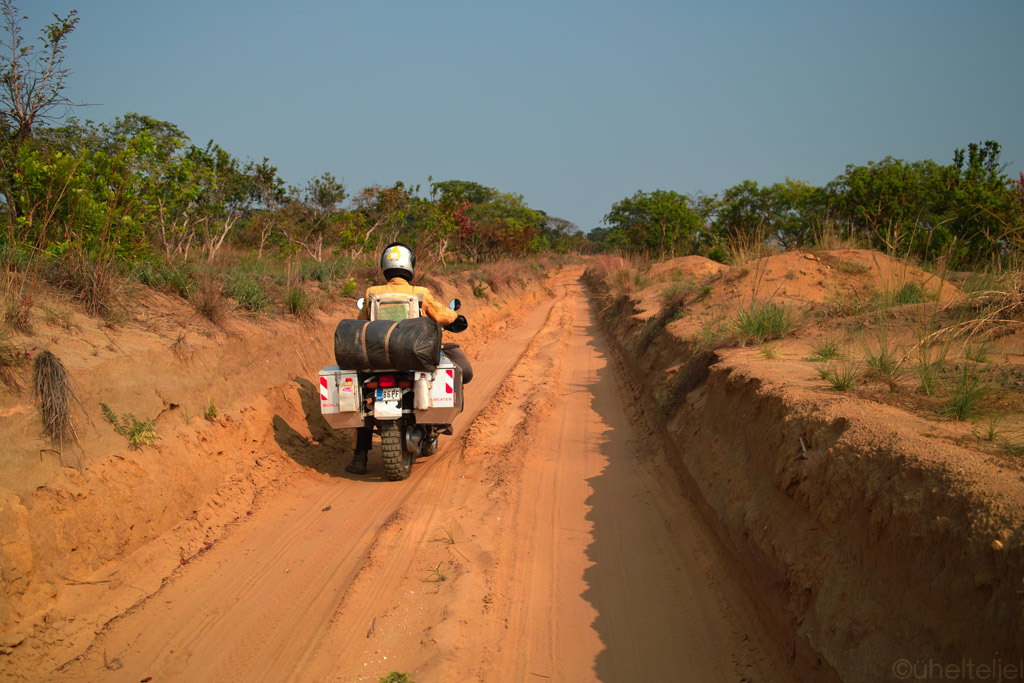
From Okoyo on it was nothing more than a sand track.
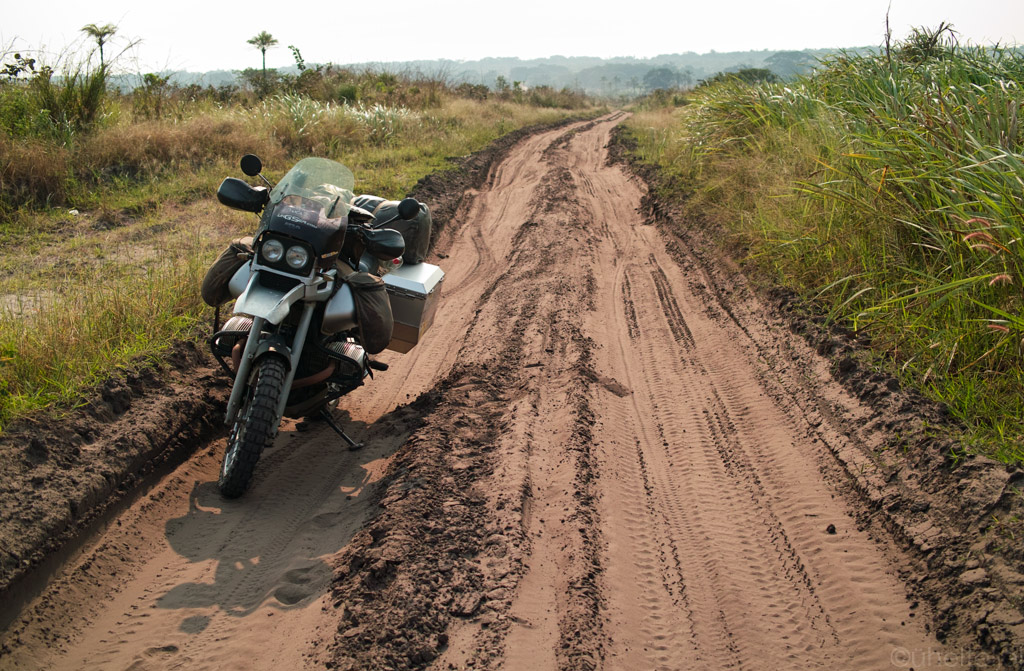
The colour of the sand varies from cream to chocolate.
When we arrived at the customs check point - the first one of four check points on the Congolese side - the extremely talkative customs official insisted that I take a photo of him and his colleague in front of their office. How could I have said no? Afterall, the guys in the uniforms here are normally very skeptical about taking pictures, so it was an opportunity. I guess they don't see many tourists passing through here.
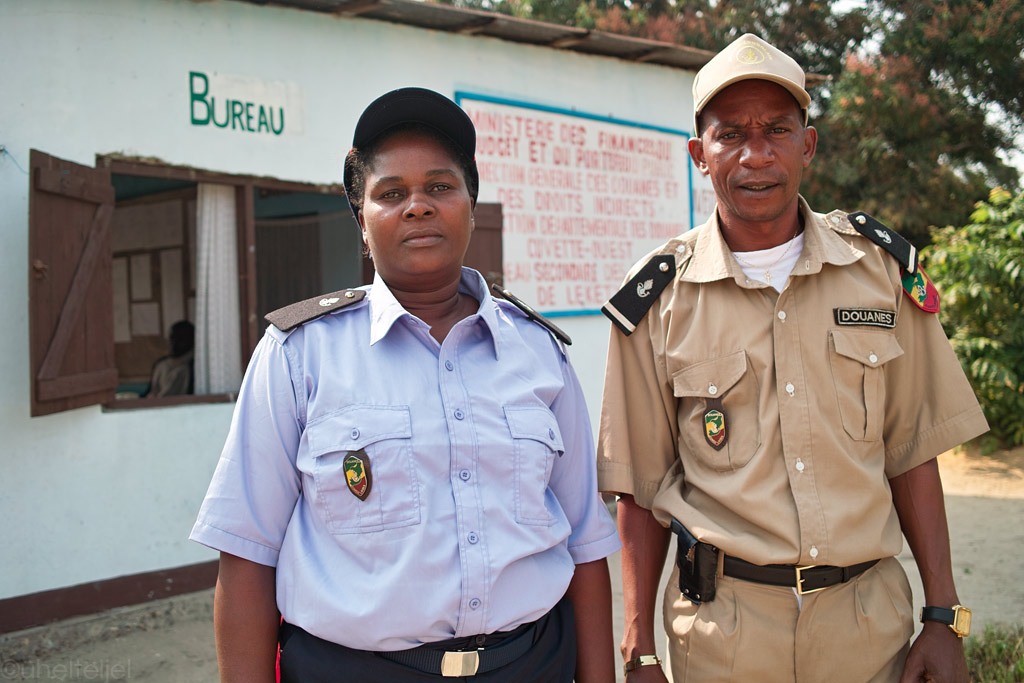
The proud customs officials in front of their bureau.
But after the customs checkpoint and the police checkpoint that came shortly after it, the road became just what we had been warned about - deep, soft sand, sometimes with enormous ruts that would swallow you for good, making it extremely difficult to move on with our heavy load, but did we have another choice? We sweated in the heat, struggled with the sand and pushed on. Sometimes we'd have to ride next to the so-called road, right in the field just to avoid the worst sand pits. Actually, most of that road reminded more of a field than of a road, riding in something barely more than a tractor track…
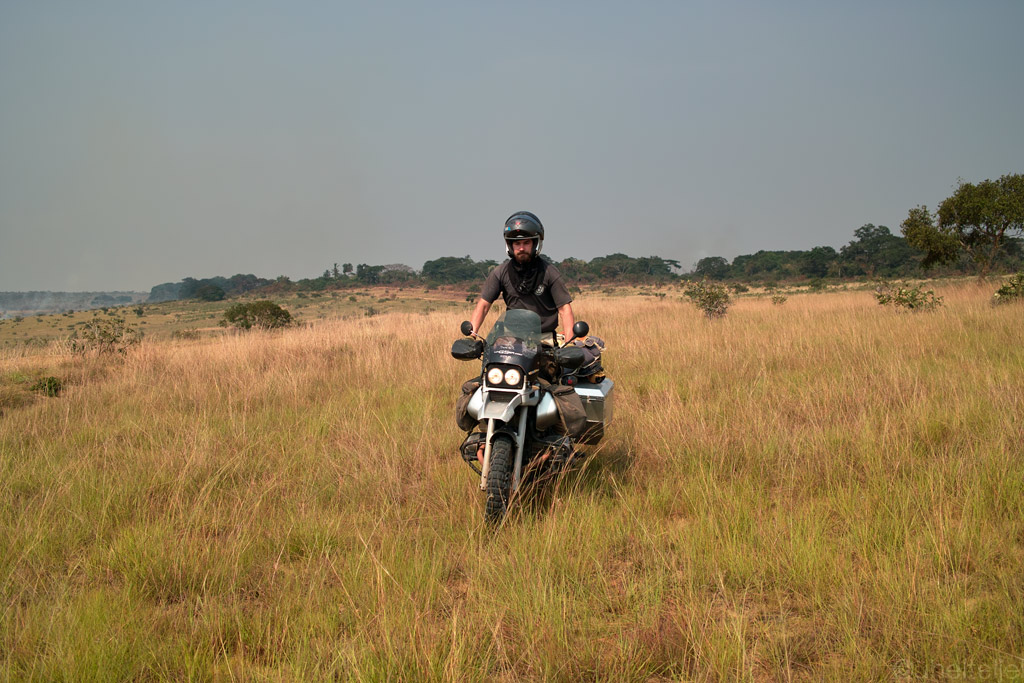
Riding in the field, where the grass roots protruding from the sand made for some unexpected bumps.
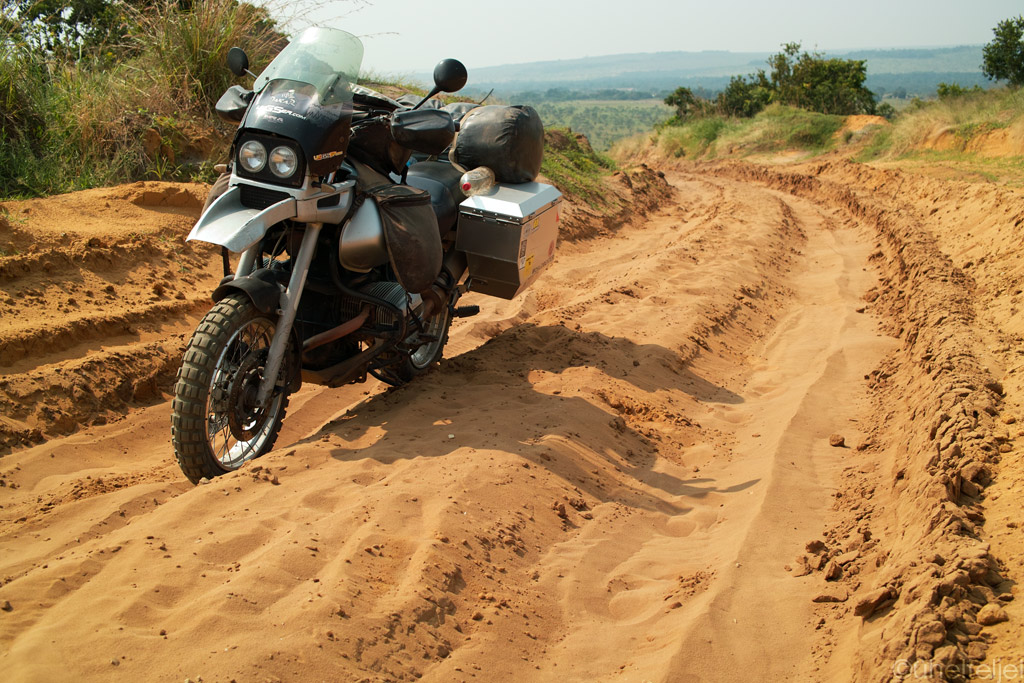
Going uphill was the most difficult.
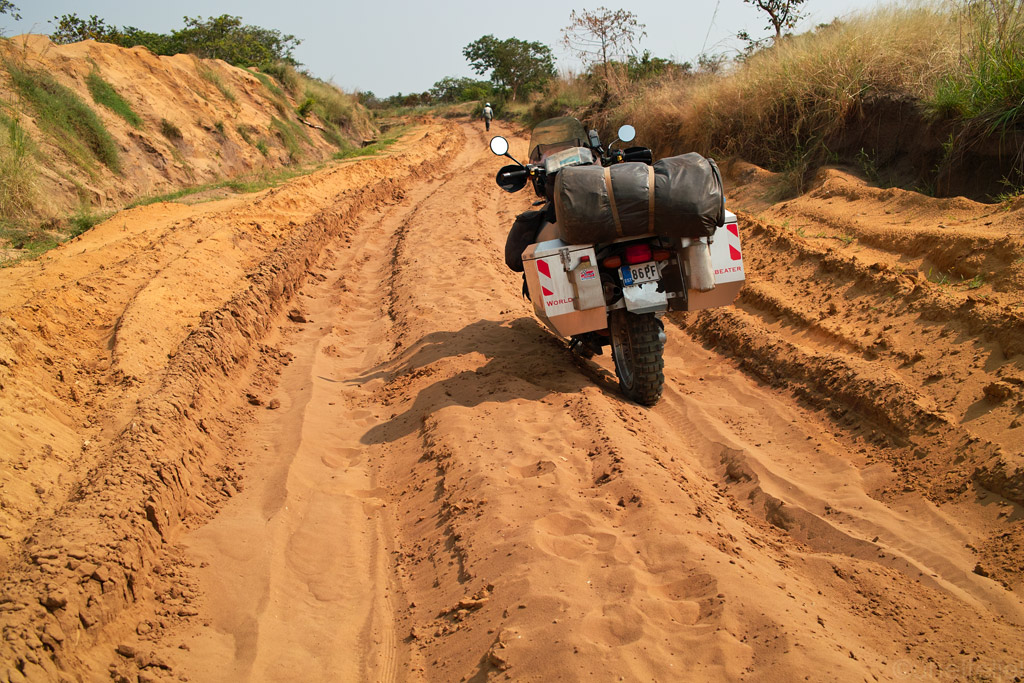
Still tens of kilometers to the immigration check point.
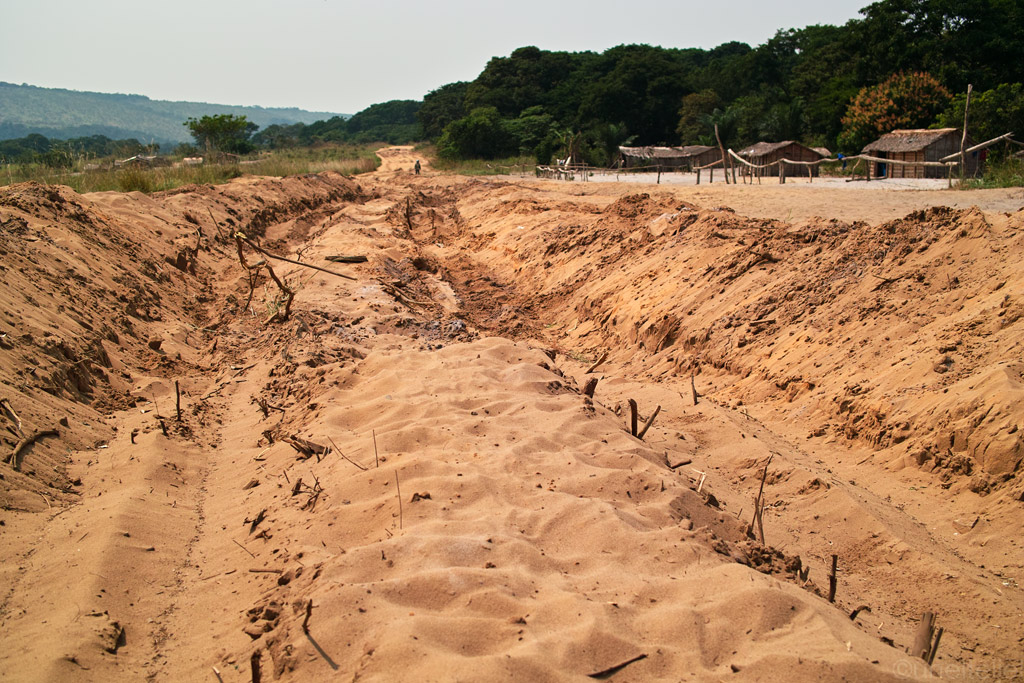
The road conditions were the worst going through villages.
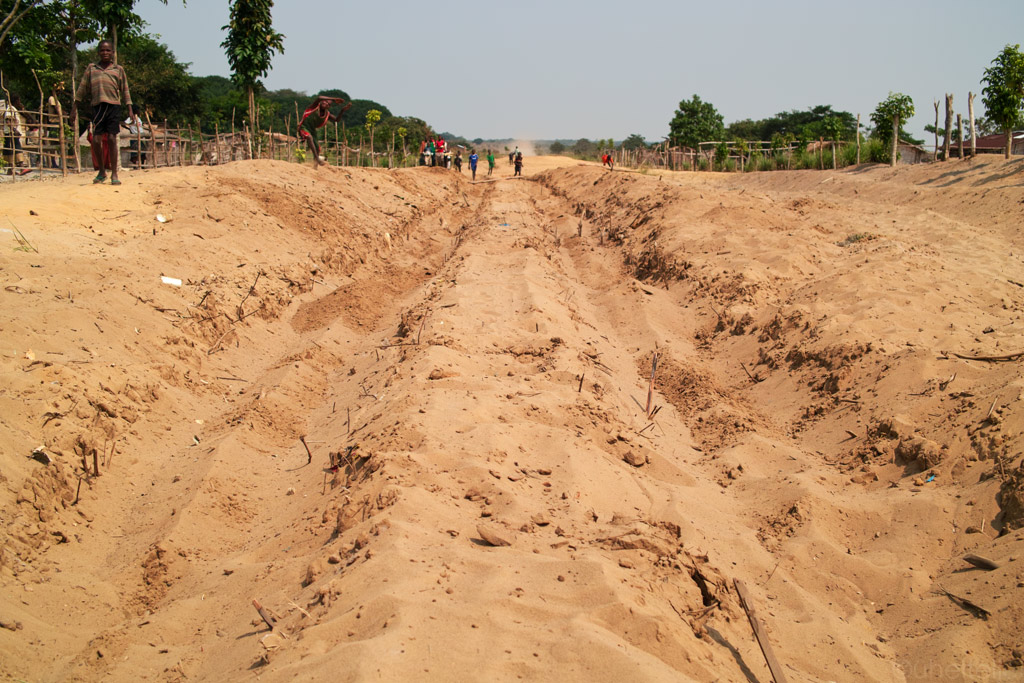
Locals were mused seeing us struggle with the deep sand.
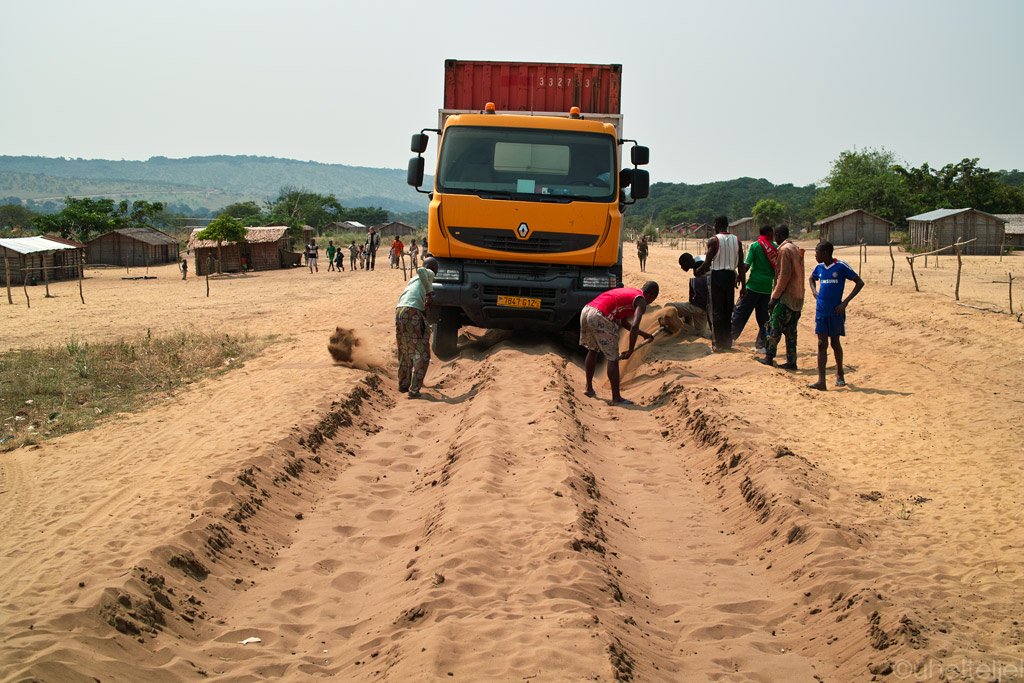
…but we were not the only ones. In fact, this truck was the only vehicle we saw during the hundred kilometers, and it was stuck. i guess you have to travel with a support crew of a couple of shovel guys at least to make it somewhere..
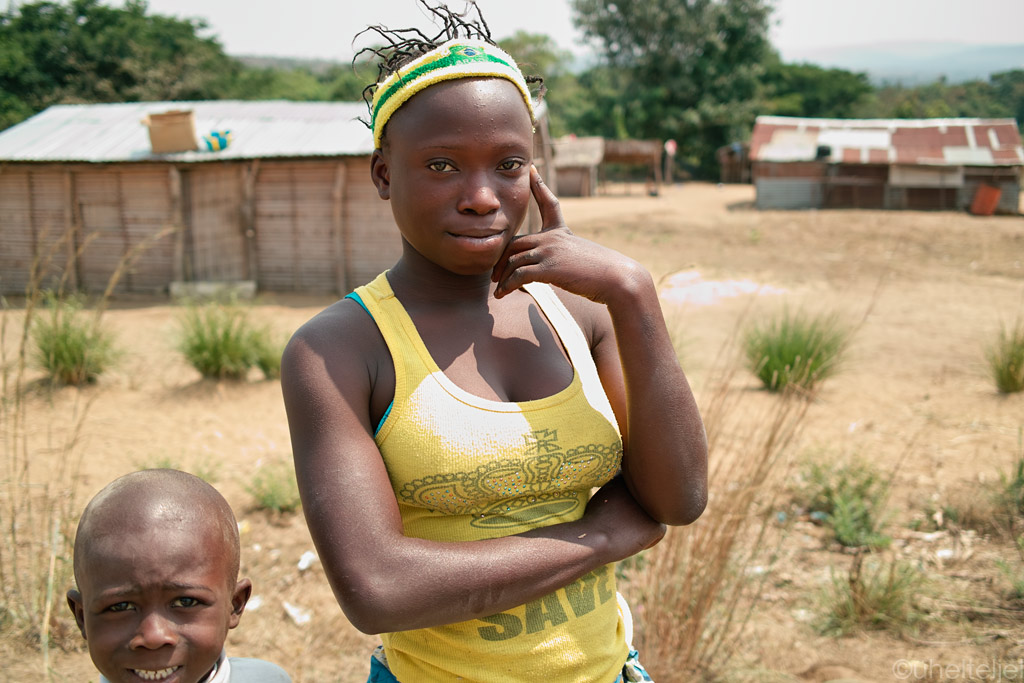
Villagers.
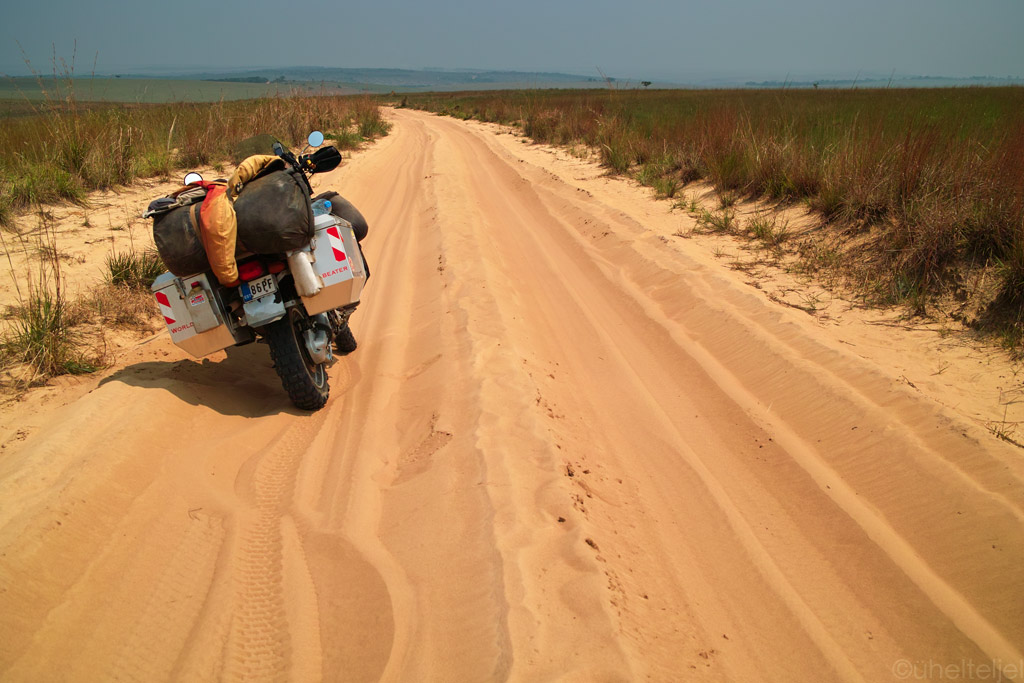
And deeper it got...
Several hours and just 45 kilometers later, when we arrived at the immigration check point, we were so exhausted that we even failed to be sarcastic when it took another half an hour for the official to write down our details. We were just sitting there like zombies, waiting for him to get over with it and meanwhile, contemplating a huge poster of some well-dressed politician (the president, I guess), a nice tarmac road as a backdrop, with the text "Road to Gabon". If I now remember correctly, that poster dated back to 2002. But as I said, we were too tired to be sarcastic.
Then it was the checkpoint of "gendarmerie". They must have been terribly bored as they just kept asking irrelevant questions which I did not understand as I don't speak any french, but Kariina does, and she was really ready to strangle someone. How long have you been married for? Why don't you have any children? Why, why? Well, you've got to make choices - travelling the way we do would be out of the question if we had small kids.
Then it was some more sand and some more falls…
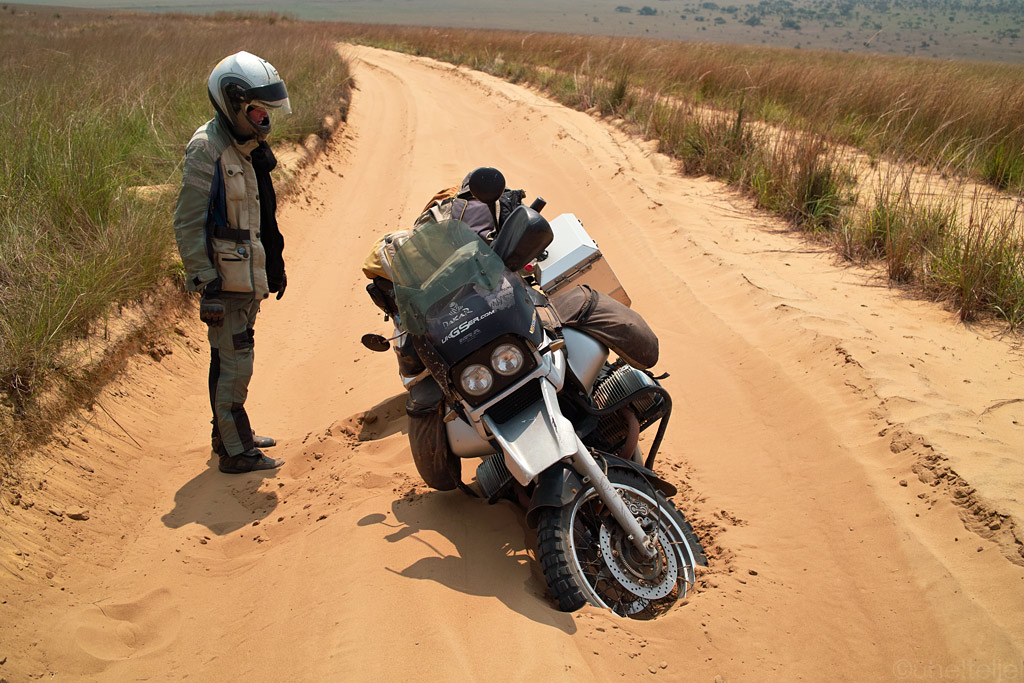
Good it doesn't really hurt when you fall in sand.
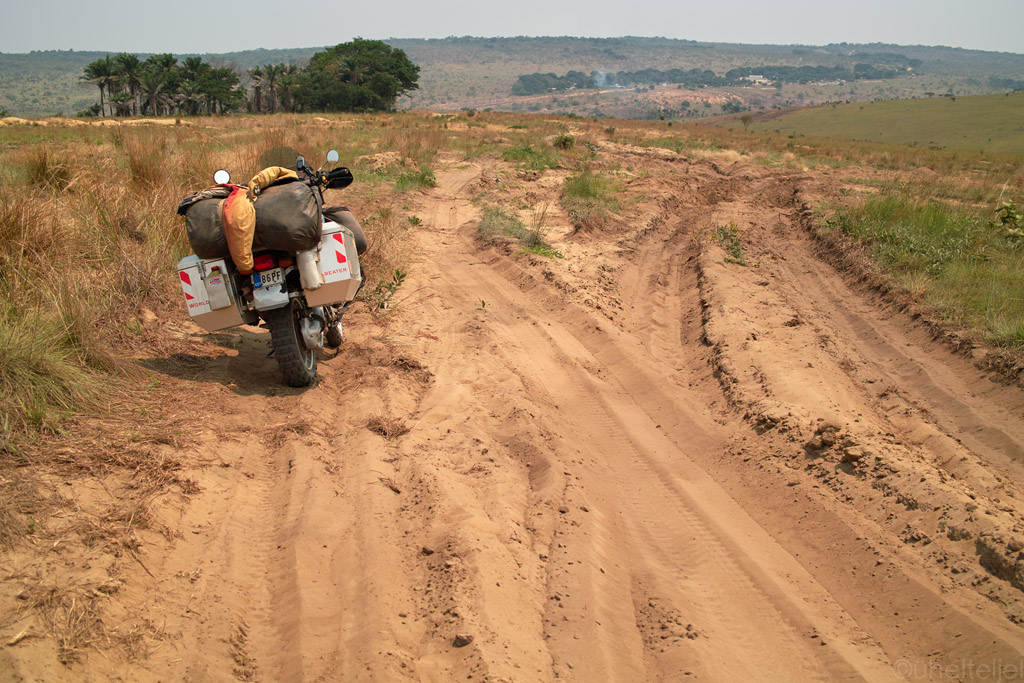
A road or what? Yes, the main road and the only one! The 4x4 guys have created multiple tracks to avoid the deep ruts ridden in by the trucks - both together are a recipe of disaster for bikes.
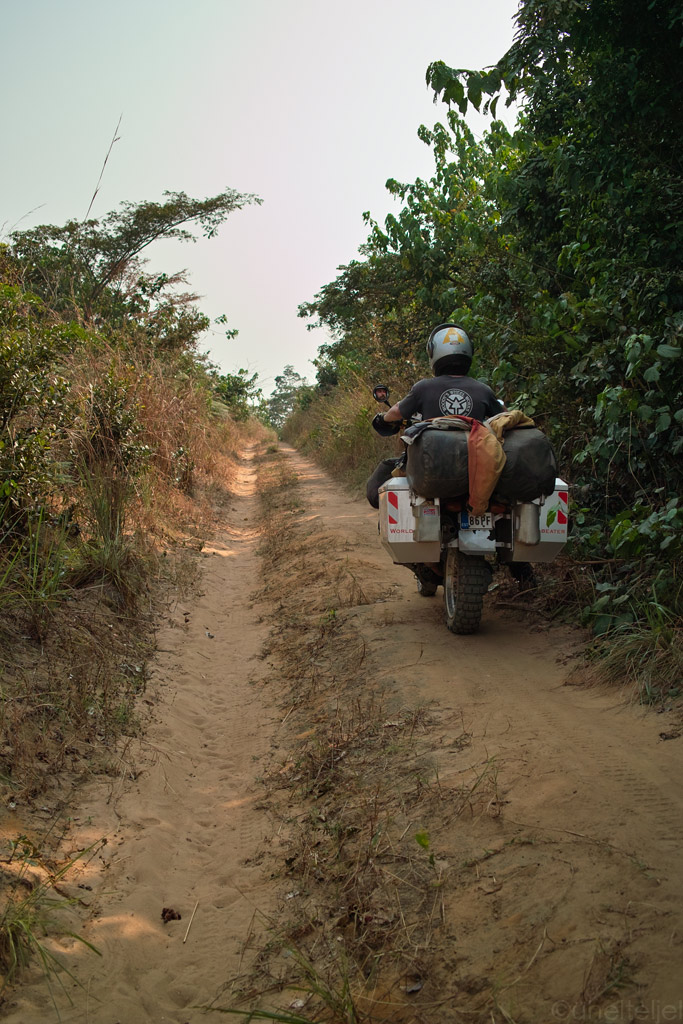
Yes, that's the main road - Congo style!
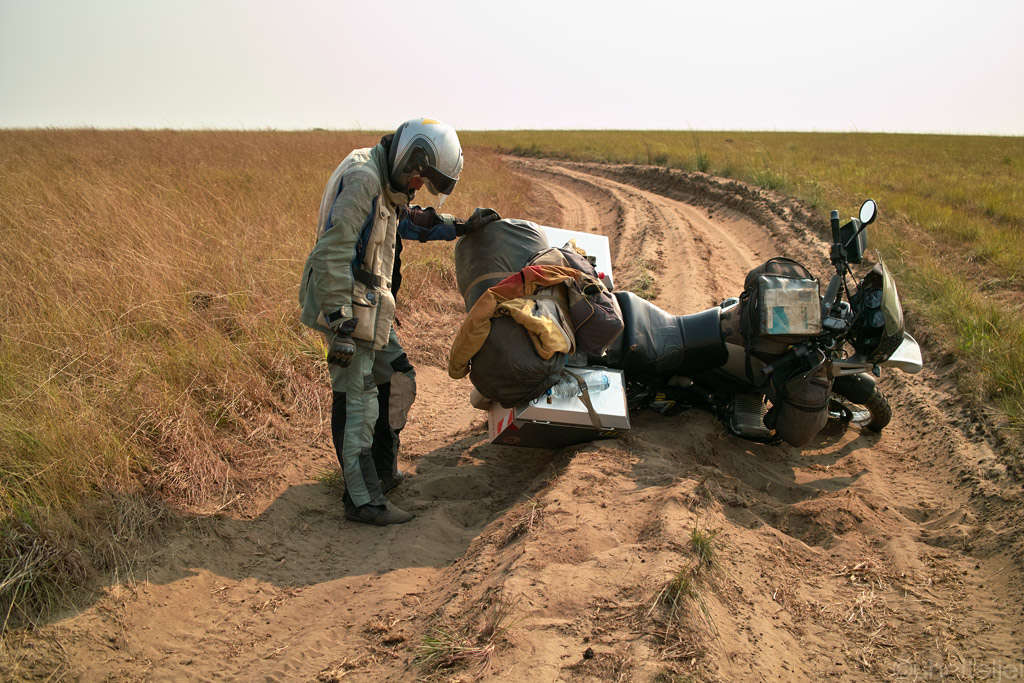
This one took us quite a while to pick up as we were totally exhausted.
Video of Congo to Gabon trail:
<iframe width="640" height="390" src="http://www.youtube.com/embed/tfWBOWS_axg" frameborder="0" allowfullscreen></iframe>
And then came Gabon, with smooth new tarmac that quickly revealed a few problems that we'd developed while struggling in the sand. The rear brake solution we'd come up with in Brazzaville had failed, partly blocking the brake, the friction making it smoke (lucky us it didn't put the bike on fire!), and even more sadly, the clutch was giving us clear signs it wouldn't last much longer - going uphill the revs would go up just as if we had an automatic gearbox. No surprise really that it's finally given up, considering it is more that 150 000 kilometers of dubious stuff it has taken us through on this expedition. But it meant that we had to make an unplanned, expensive detour to Gabon's capital Libreville, order some parts and get it all sorted out as we would absolutely not want to start dealing with it somewhere later on the road, in Nigeria for example.
Some pics from the road to the capital:
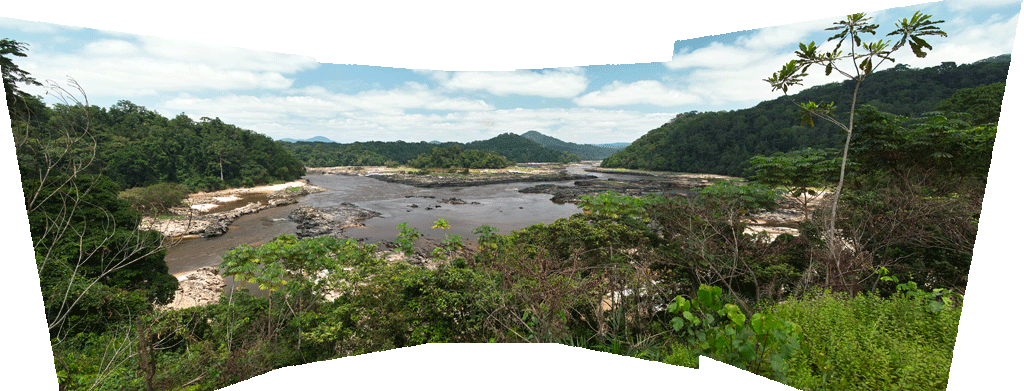
A panorama of Gabon's landscape.
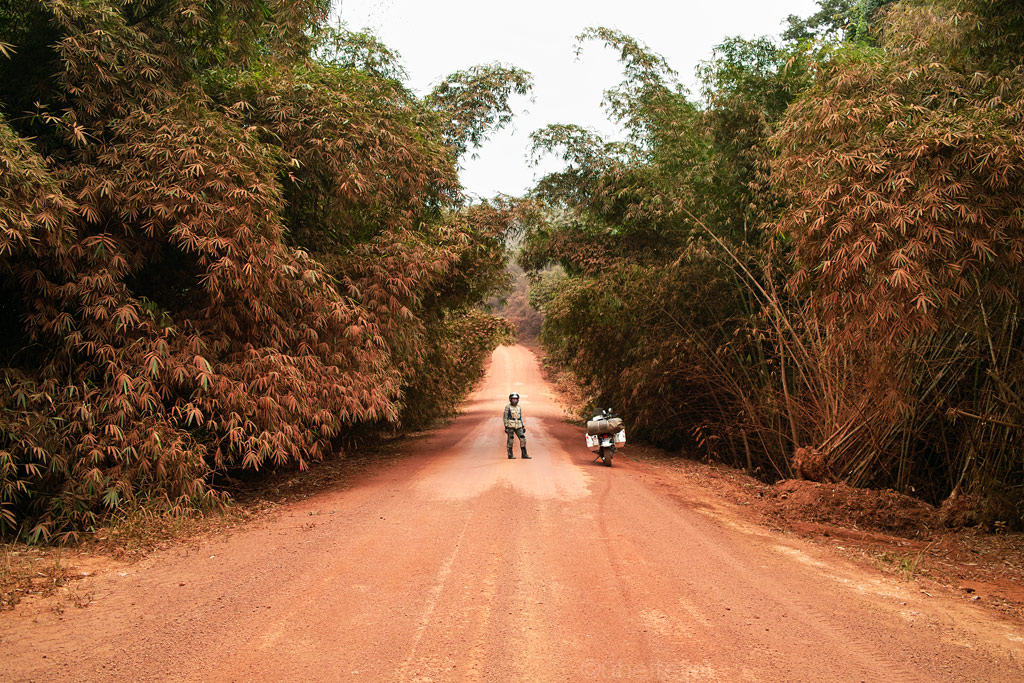
Road through the jungle (as you can see the tarmac did not last too long for us…).
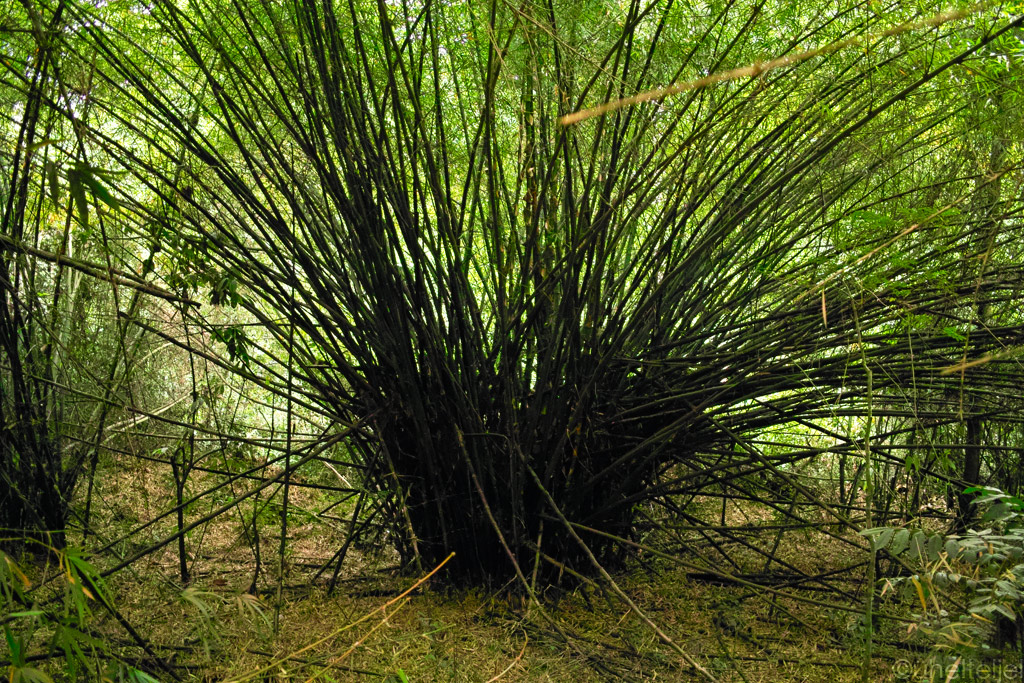
Huge bamboo.
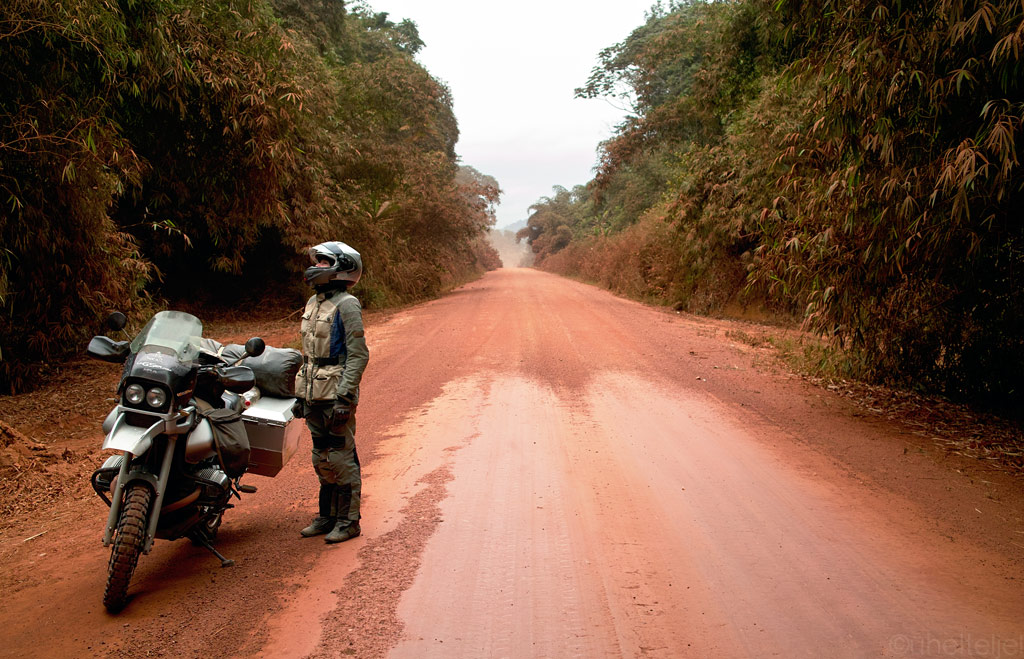
Decent dirt road through rainforest.
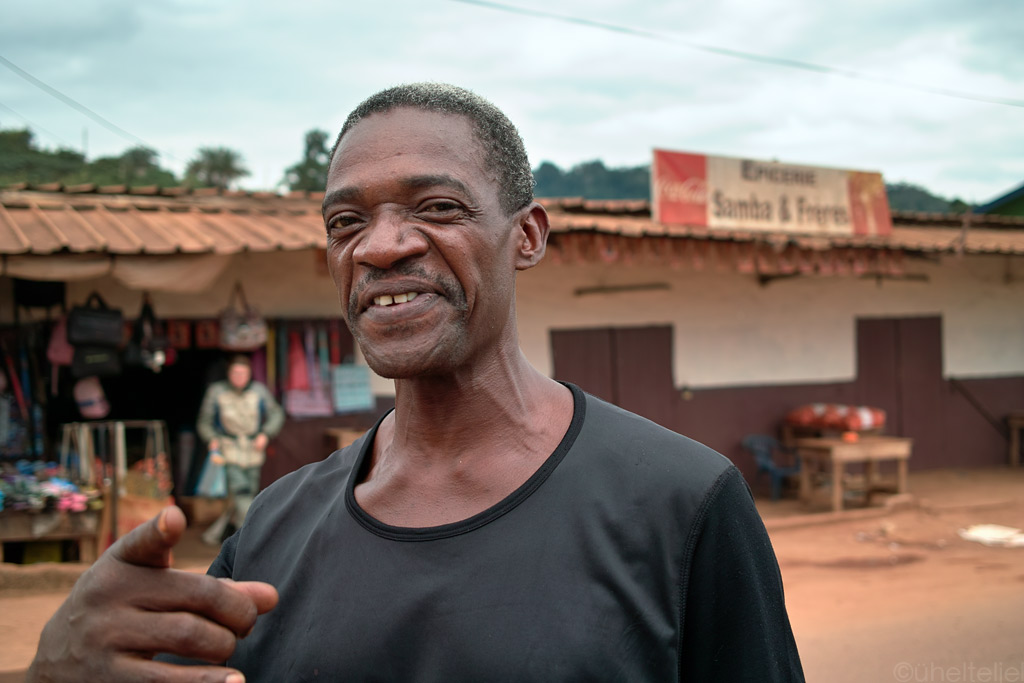
A local who could speak some English (Kariina coming out of a shop with some fresh bread).
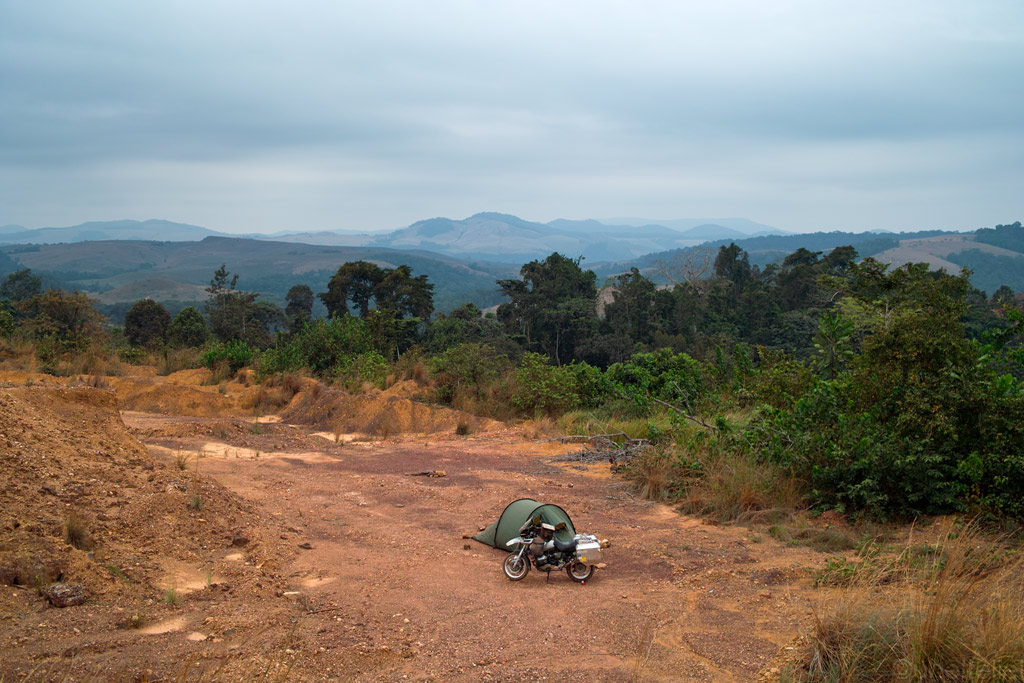
Our bushcamping in Gabon.
So it was another African capital on our route. To think about it, regardless of the fact there is not much to see in most African capital cities, we have somehow ended up paying (if even a short) visit to each one en route, with the exception of Maseru (Lesotho). We only rode through Dodoma (Tanzania) and Maputo (Mozambique), but as for the rest, we've at least overnighted in them, and mostly spent a week or more - remember the one and a half month long pit stop in Nairobi (Kenya), or weeks spent in Djibouti City (Djibouti), Lilongwe (Malawi) and Brazzaville (Congo)waiting for some visas?
We'd gladly have gone around Libreville, capital of Gabon, if not for the problems with the clutch - there was no paperwork to be done as we already had visas for both Cameroon and Nigeria in our passports. And, going to Libreville meant quite a detour from our projected route - a couple hundred kilometers there and back. But we'd made some research and there appeared to be a well equipped Western-style workshop - a rare thing in most of Africa, meaning that we could possibly work on the bike without having to go looking around the city for each tool we needed. Owned by a Swiss guy, of course. So having arrived in Libreville, the first thing we did was to look up that workshop by the name of Nitrojets.
The owner was not there, but the guys said we could work on our bike ourselves no problem, and they would not even ask money, so it was cool. The next thing to do was to find out how we could get some parts shipped to us (as there quite naturally isn't anything available in most of Africa for our bike).
We surfed some web stores, but none of them had all the parts we needed in stock (in addition to the clutch plate and the spring I was intending to replace, we also needed a new rear brake cable, and just in case, some suspension bolts and a spare final drive bearing). Ordering parts from different stores would have meant at least double shipping costs (which in the case of express shipping are steep anyway), so we were trying to think of alternatives.
This is when we realised that we hadn't checked the German web stores (because we don't speak any German), and figured that we should send an e-mail to Siggi and Gerdy from Germany whom we had met on many occasions in Africa, and ask if they knew a good one that would be able to send us all the stuff we need, and quick. Before we knew we had an answer from Siggi who was writing to us from the airport (apparently they were on the way back home at that moment!), and before we knew she had arranged with a store in Germany (Siebenrock) to send us all the stuff express, and with a fake bill stating a smaller amount so that we wouldn't have to pay so much taxes when receiving it. Absolutely ingenious!!!
Whle waiting for the parcel to arrive, not to waste time, we still undertook some paperwork, and got the visas for Benin and Burkina Faso sorted - 40 USD and 100 USD respectively each, no hassle whatsoever. The visas here may be expensive but at least they don't give you nonsense if you want one. Also, we got some stuff fixed, such as a fallen off side bag (yeah that good old sandy track), the tank bag and the riding boots that just keep falling apart.
A few pics from the city, and for accompaniement, some parts of a voodoo themed radio program - probably due to a malfunctioning FM emitter or some faulty grounding, there is this buzzing sound for the unique station, but doesn't it add something to the voodoo magic?
...::: LISTEN Voodoo music playing in Gabon radio I :::...
...::: LISTEN Voodoo music playing in Gabon radio II :::...
...::: LISTEN Voodoo music playing in Gabon radio III :::...
...::: LISTEN Voodoo music playing in Gabon radio IV :::...
...::: LISTEN Voodoo music playing in Gabon radio V :::...
...::: LISTEN Voodoo music playing in Gabon radio VI :::...
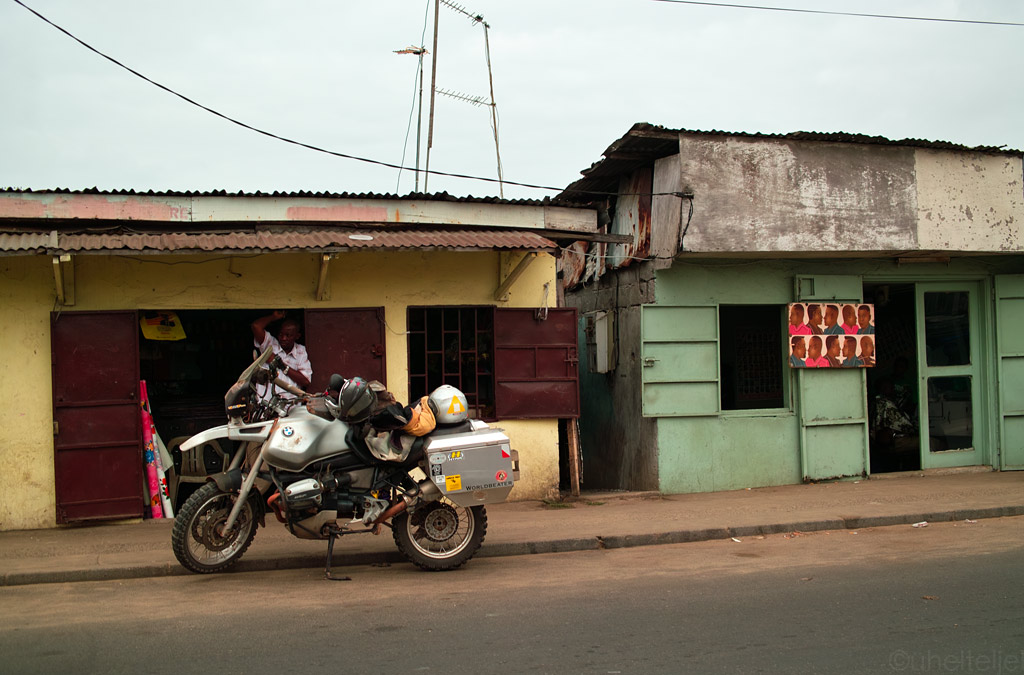
On Libreville's street.

Panorama from Libreville's street (click to enlarge)
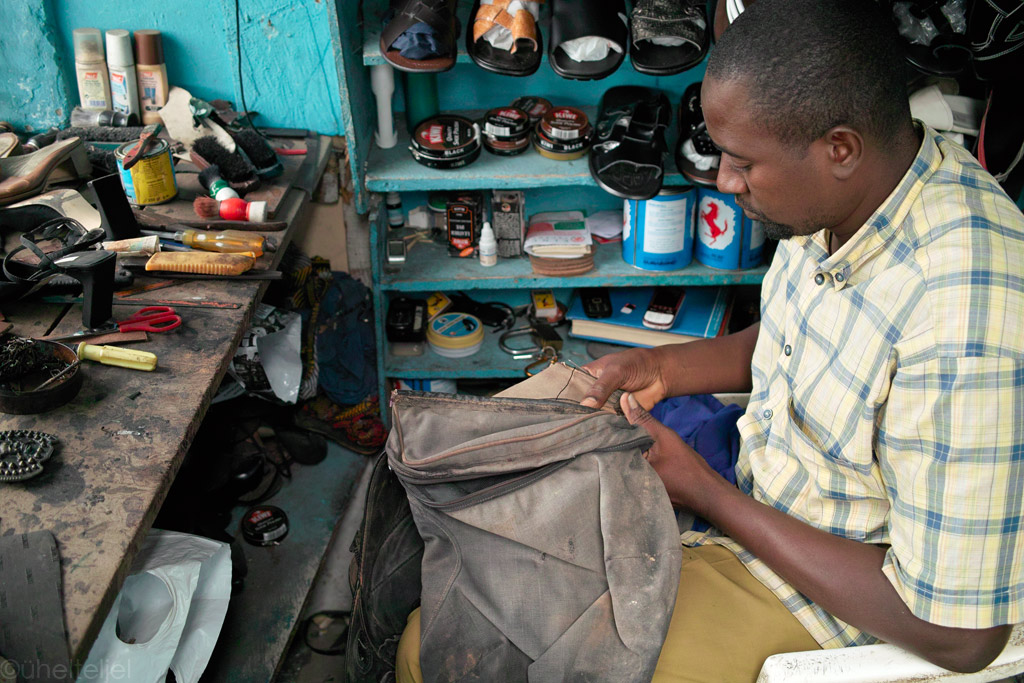
Repairing our tank bag for some tenth time or so that's almost completely disintegrated through wear.
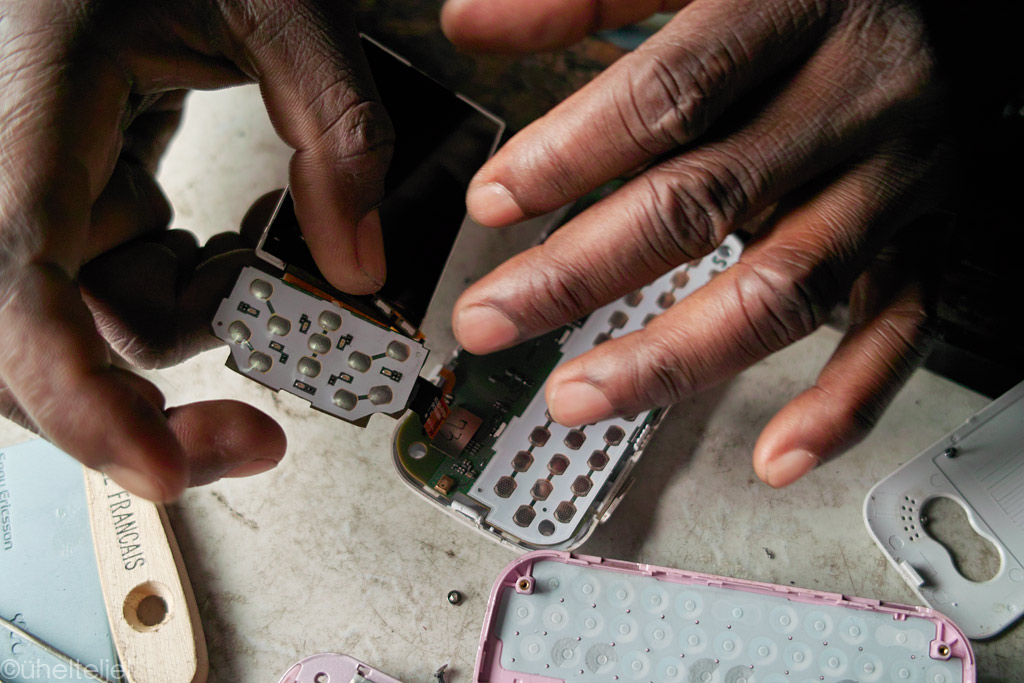
This is what we love about Africa and Asia - on the street you find highly specialized jobs on electronics and micromechanics - someting you don't see in developed world. If something is broken there it'll be returned to warranty or if void then just thrown away.
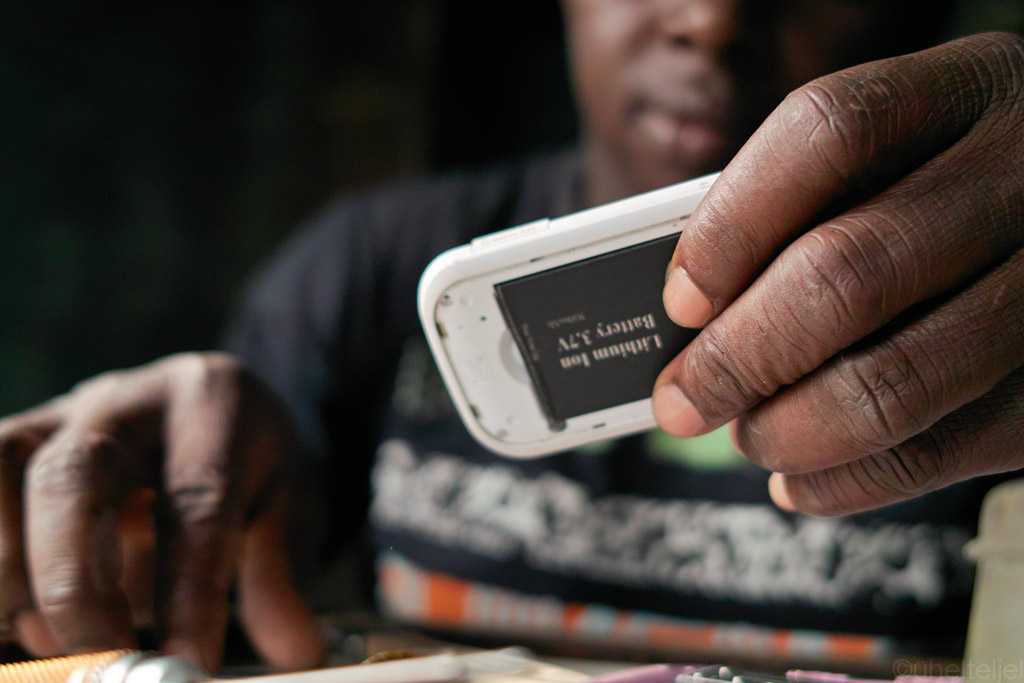
Voodoo magic, but it works.
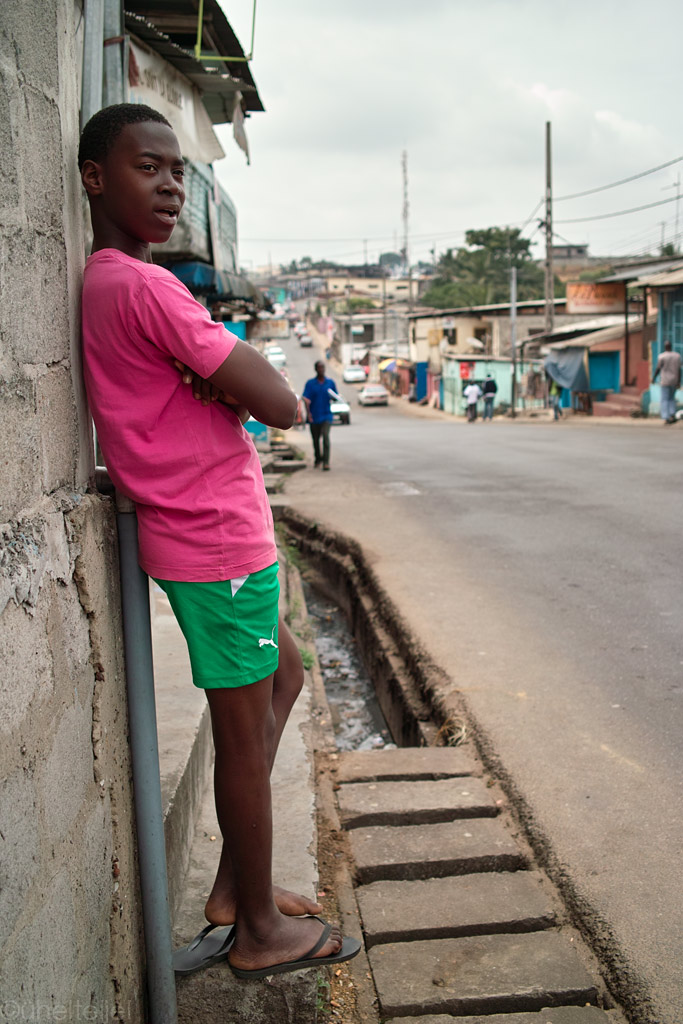
On typical Libreville's street.
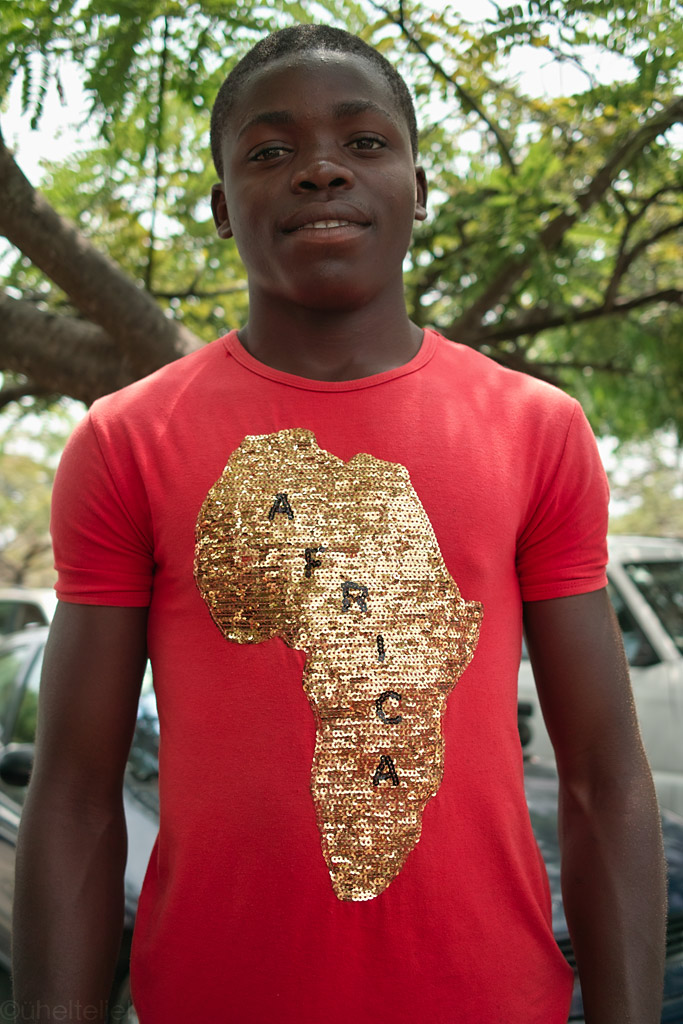
A Gabonese artist we met in Libreville had a very nice t-shirt.
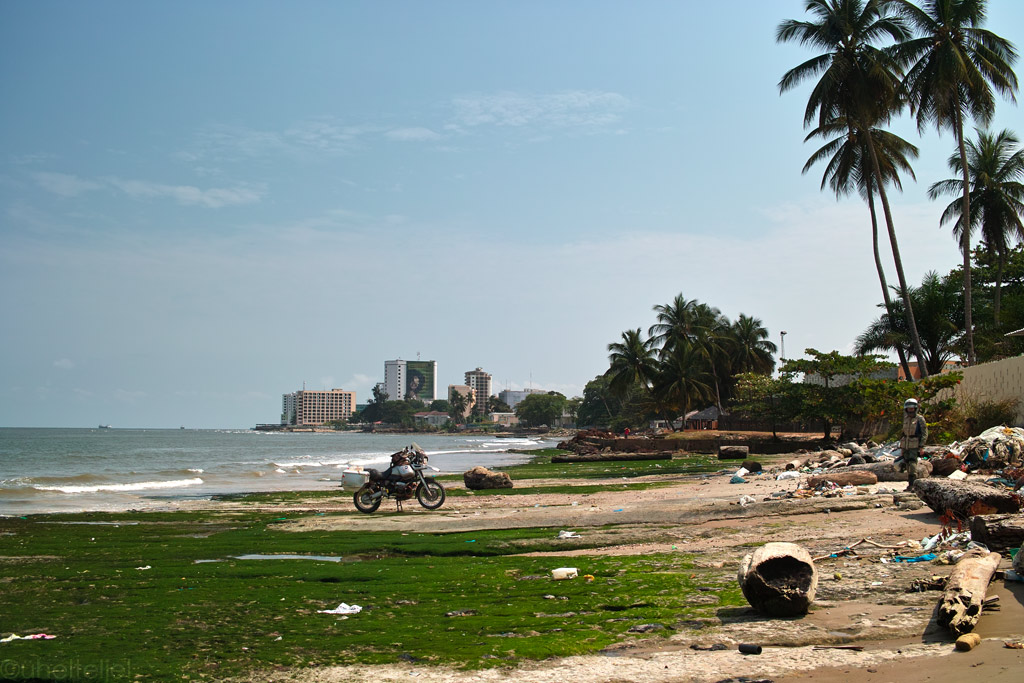
On Libreville's promenade (see all the rubbish).
A few days later, the parts were there - we were once again amazed by German efficiency! We did not waste any time either, but went to the workshop and took the bike apart.
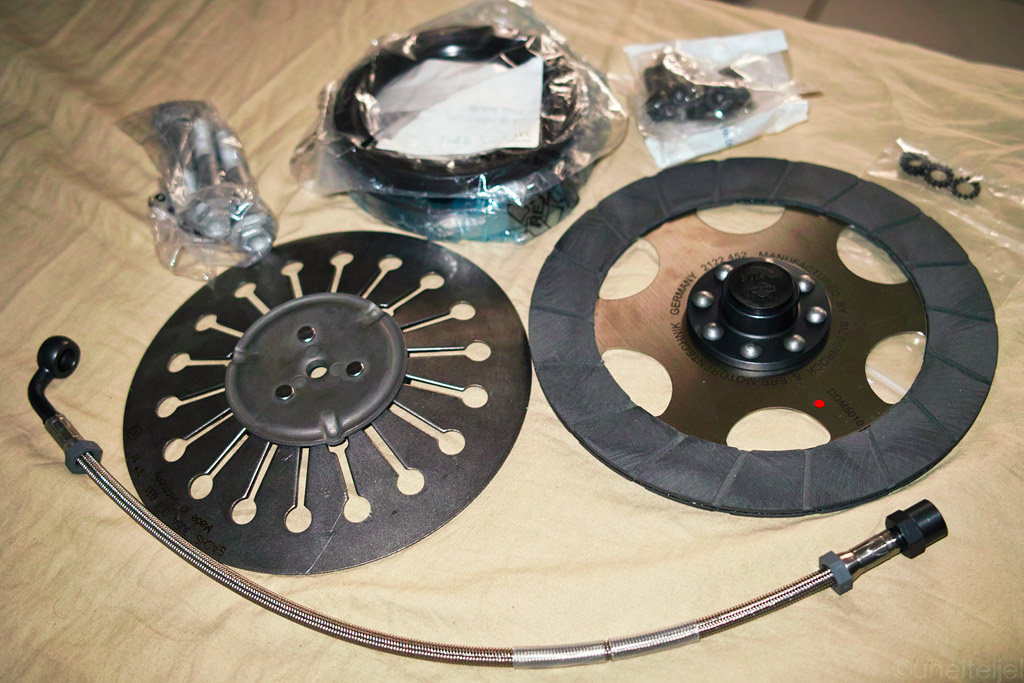
Parts arrived.
To cut the long story short, we got it over with in one full day. I won't be going into details here as I've described the process somewhere under Preparations, but one thing that was different this time is that I've installed a clutch that is oil proof, due to my paranoia that it might have been an oil leak from the engine or the gearbox into the clutch chamber. But as I disassembled the clutch, it appeared to be perfectly dry, and it wasn't even too worn - according to BMW, a clutch plate is worn when its thickness is about 4,5 mm, but ours was just slightly under 5 mm. I guess the spring was simply tired and under a torquey bike that is loaded bomb heavy, slipping appears earlier. In any case, this new Siebenrock clutch should, in theory, last longer than the original, although I'm afraid I'll have to reopen the bike once we get back home since I got the splines greased with some random grease that is unlikely to last the lifetime of the clutch. The right stuff just isn't available here - it's Africa afterall.
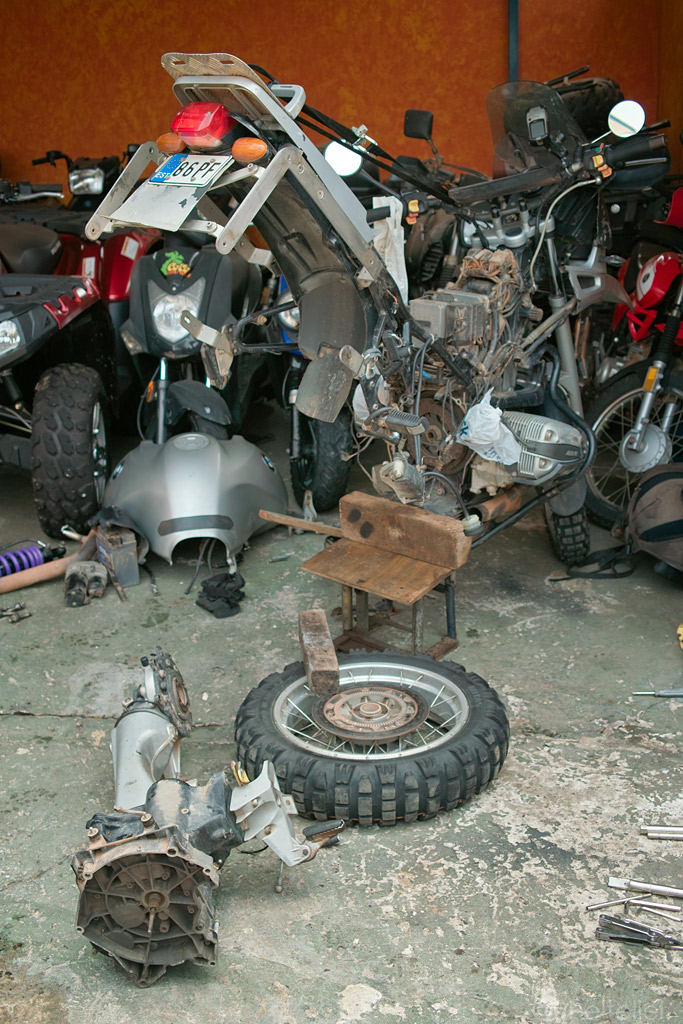
Worn clutch replacing in Libreville. One day job.
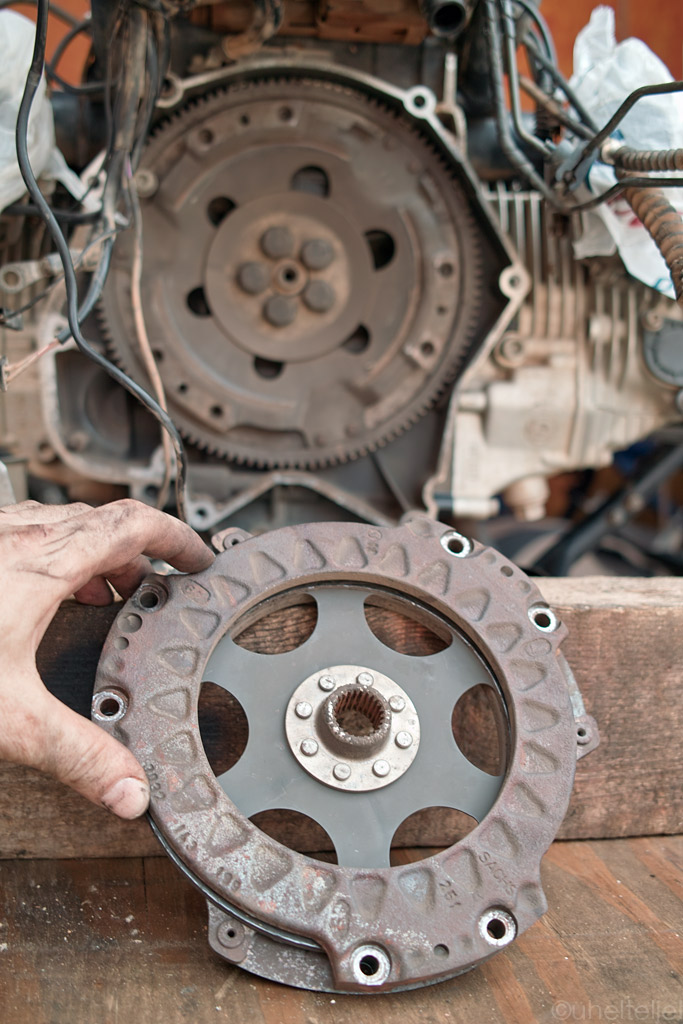
Old clutch was dry and nice, but better replace it.
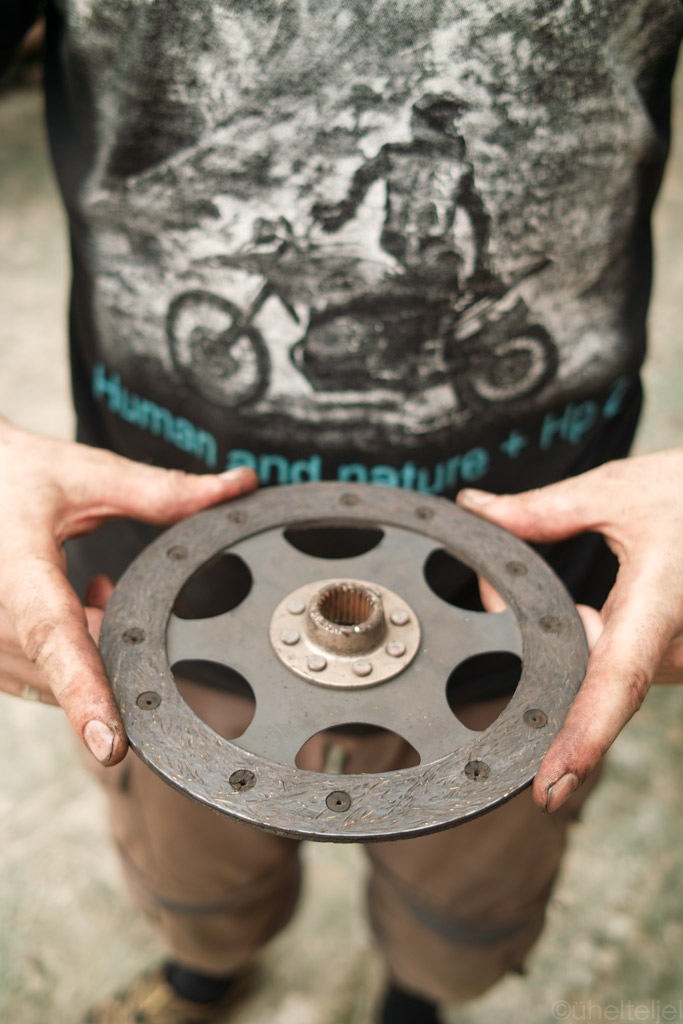
Old plate was still within wear spec...
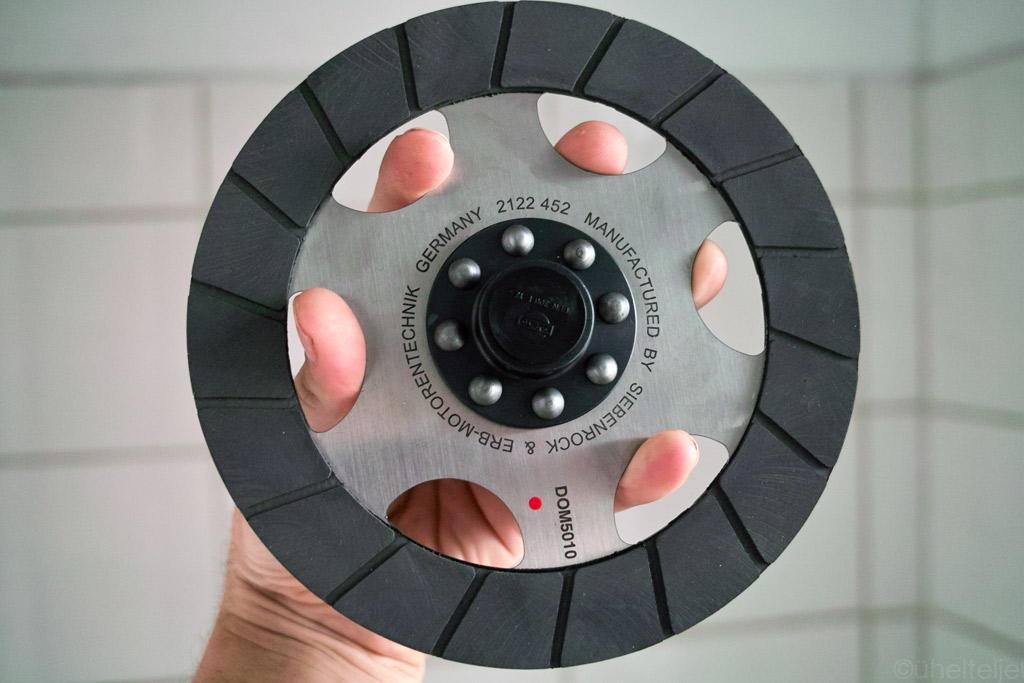
But the new fancy oil proof special coated Siebenrock version was all too tempting to be installed along with the heavy duty spring...
With the new spring, the new clutch is very "grabby" and I don't like it - it feels like a racing version of wet clutch, way too "sharp biting" for my liking. Hopefully it'll get more "neutral", like a dry clutch is supposed to be, when it wears in.
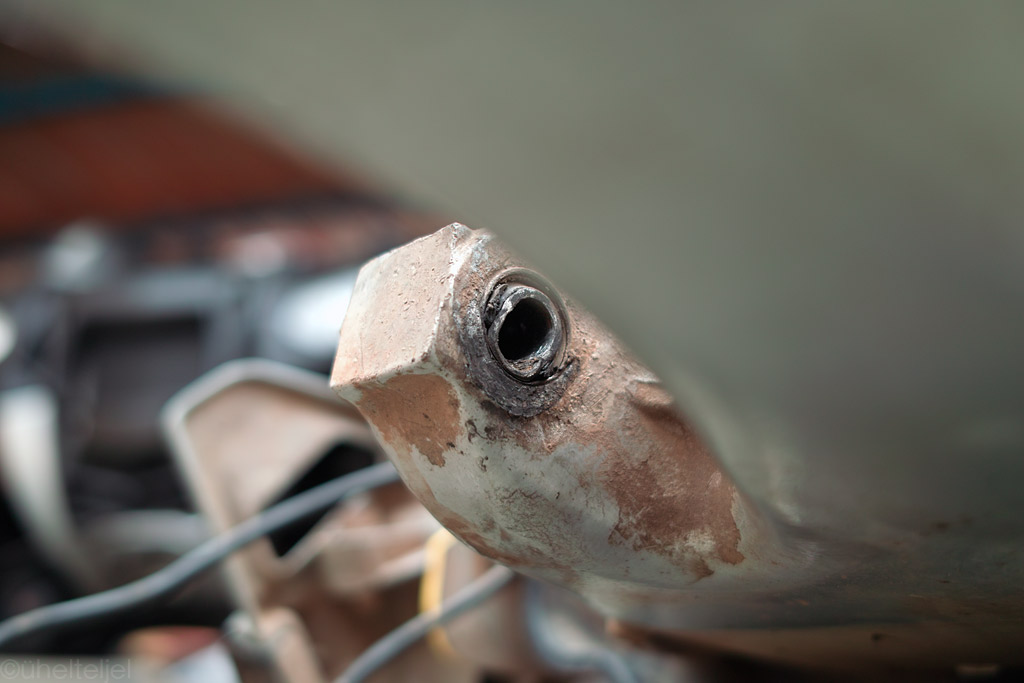
Some twisted voodoo magic has been done on our swingarm bush - that's why it eats all the suspension bolts on bad roads!
Also we found the cause why our suspension bolts break - on dismantling the swingarm I saw the bushing completely damaged. So a question to any of the knowledgeable BMW guys - do you know where we could buy a new bushing and have it shipped to Africa??? It seems to be very hard part to find in any of the stocks!?
BMW part number supposed to be: 33172312147
Going through the northern part of Gabon it was the fourth, or the last time for us on this trip to cross the equator. It is, of course, nothing more than an imaginary line, but somehow it is that imaginary things (such as all sorts of rules and definitions) seem so important in our civilization. So for us, too, and we could not help but to stop to celebrate our arrival to our home hemisphere, laid out under the skies that we're so acquainted to. Also, looking from our home, it meant the end of us walking (and riding) "upside down".
By the way, due to the centrifugal force created by the Earth's revolution, the gravity is not so strong on the equator, so things weigh less
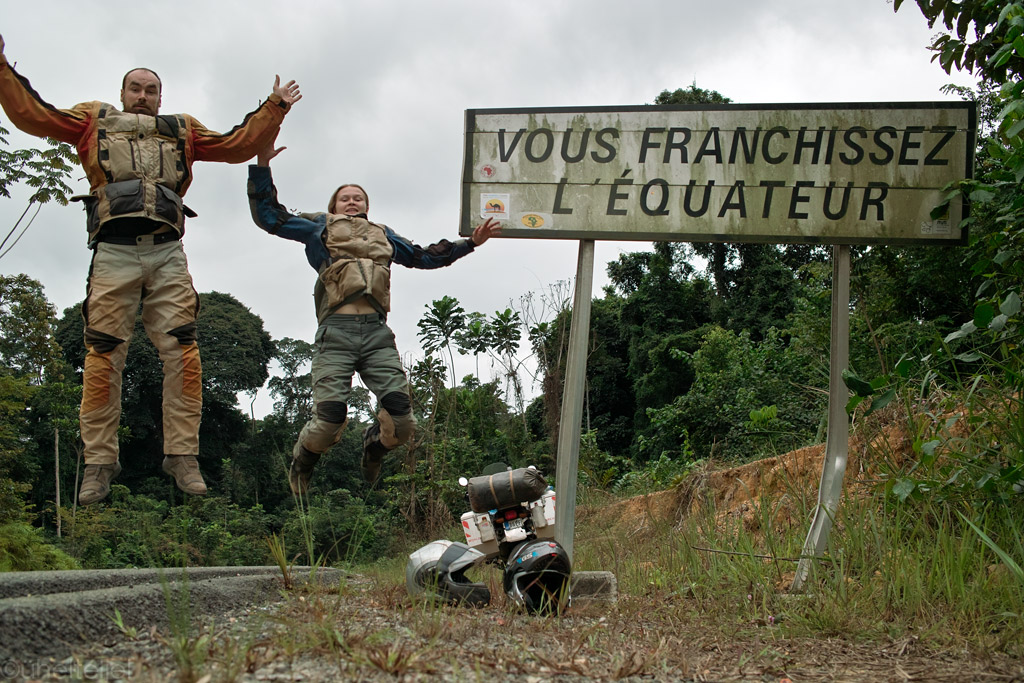
Loss of weight on the equator is obvious
Passing a village on the road, we happened to witness some sort of a ritual dance around a bunch of plaintains, a carton of table wine and bottles of cooking oil and whisky. The boys behind the big drums carved out of tree trunks were whipping up beats quite far from our Western sense of rhythm (although if you spend a while in the subsaharan Africa, you might start to see a pattern in that apparent chaos), and girls were swaying their hips far quicker than Shakira.
...::: LISTEN voodoo drums and music played and danced live in Gabon :::...
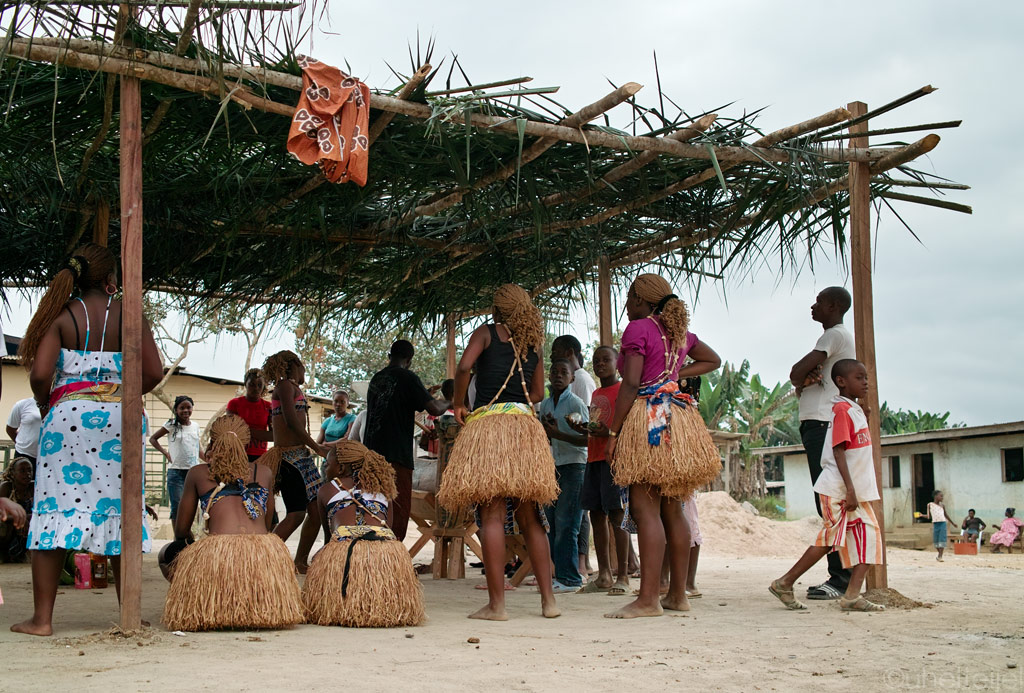
Voodoo dances in Mitzic.
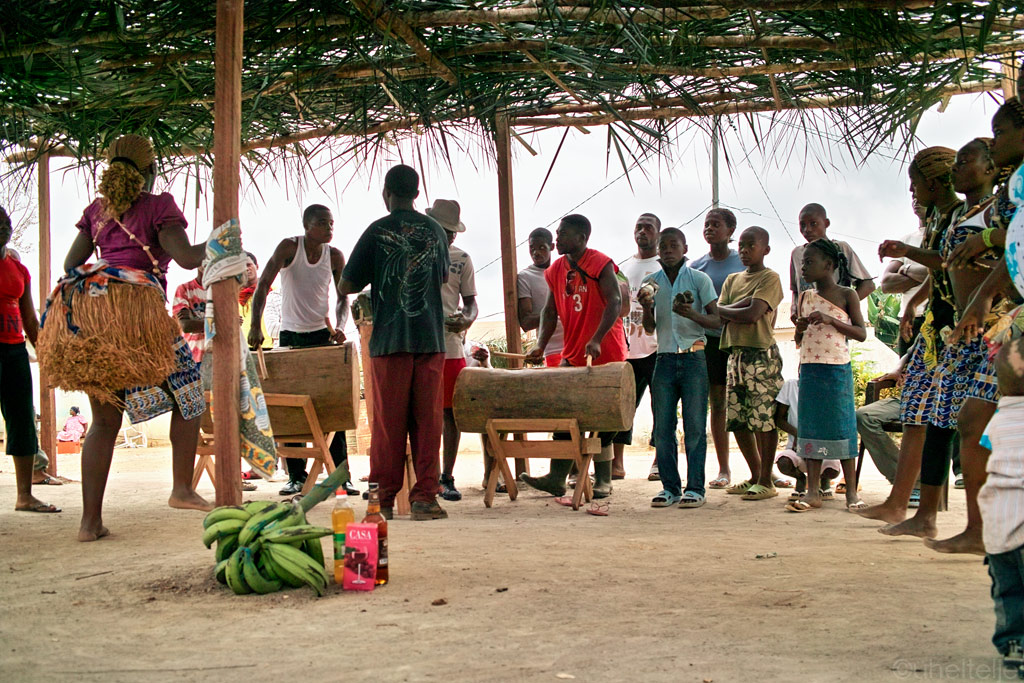
Music and dances around food.
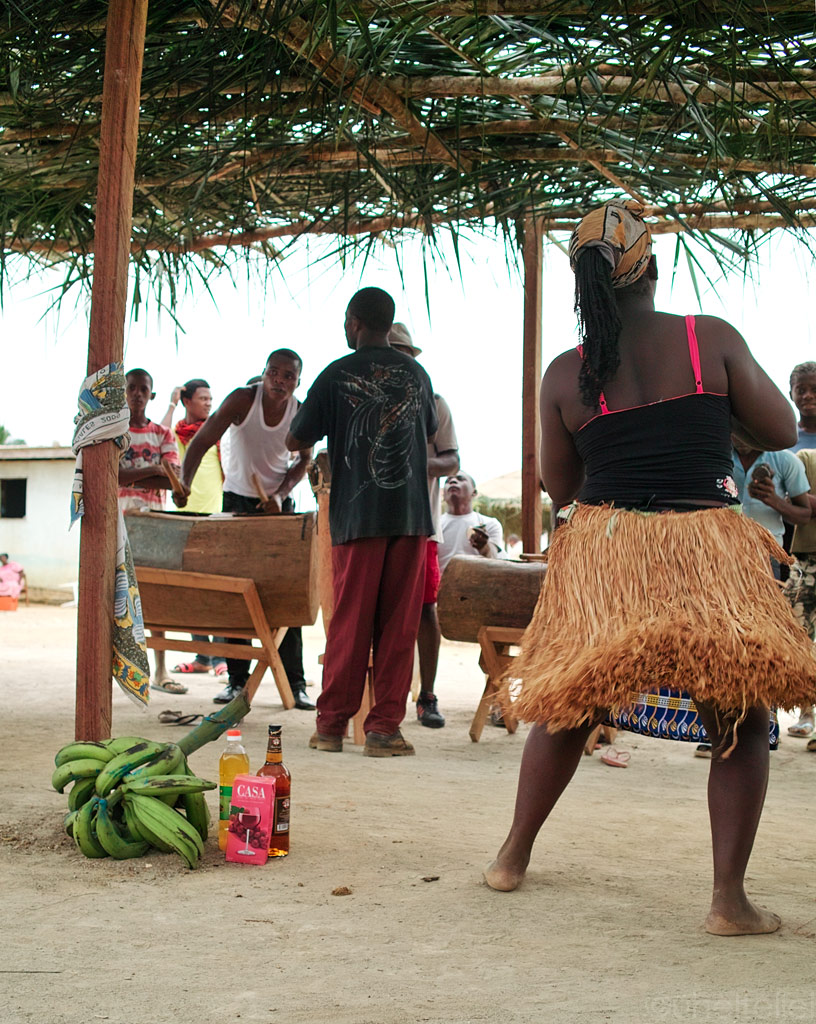
Food seemed to be the centerpiece.
To think of it, our way of thinking is actually quite similar to that of different other peoples and tribes. Back in Estonia we still have a sort of trick-or-treat games (going around your village or town dressed up like a junkie, singing and dancing and begging for sweets, and cursing those that give you nothing) and we do try to leave twelve dishes on the table on the first night of a year for the souls of the deceased ones to come and eat. We might go to church on Sundays, or to mosque on Fridays, but deep inside we all seem to have some animist or ancestral beliefs.
After the chaos of the voodoo rhythms we could enjoy quite a similar chaos of natural sounds of the Gabonese rain forest - Gabon's population is just as small as that of Estonia, but its area is three times bigger, so there is plenty of space to get away from the people. Finding a decent spot to camp can be a little tricky though, as the forest is so dense it is even difficult to walk, let alone slip a tent in, but every now and then there is an opening allowing you to get in with a bike and have the jungle for yourself.
So we fell asleep, accompanied by the pure natural audiophilism - the life itself happening around us, with the diurnal species concluding their talks, the nocturnal species waking up, and everything going in the reverse in the first fresh morning light. The soundscape of the rain forest does have different faces, as you can hear from the recordings at dusk, night and dawn:
...::: LISTEN Gabon's equatorial jungle during twilight :::...
...::: LISTEN Gabon's equatorial jungle during 1AM at night :::...
...::: LISTEN Gabon's equatorial jungle during new day's sunrise :::...
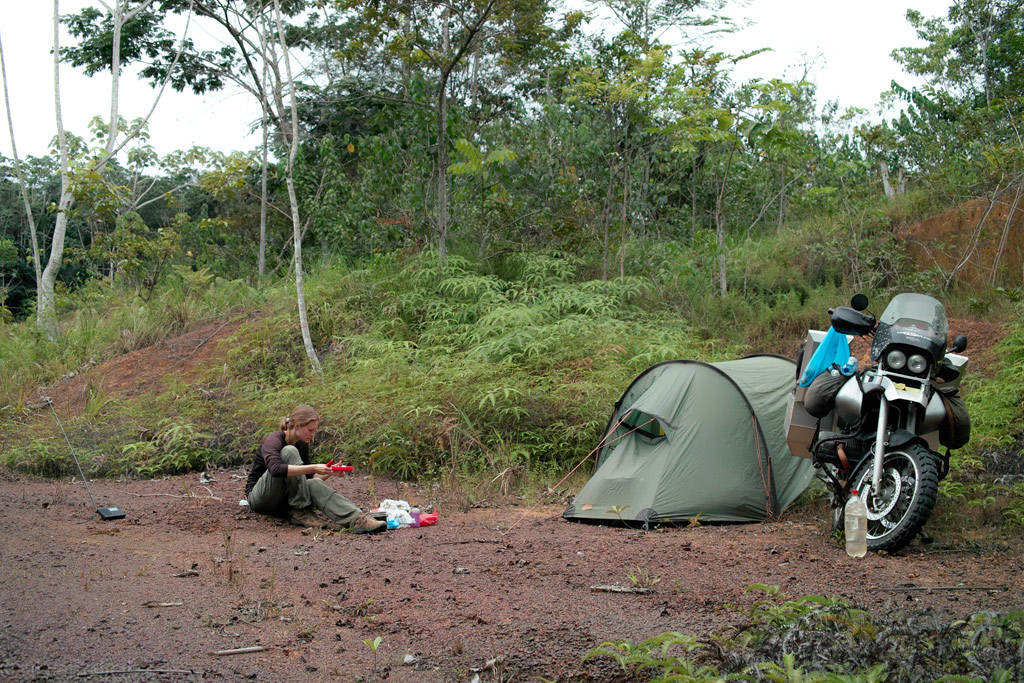
Our bushcamp in the jungle.

Jungle flora.
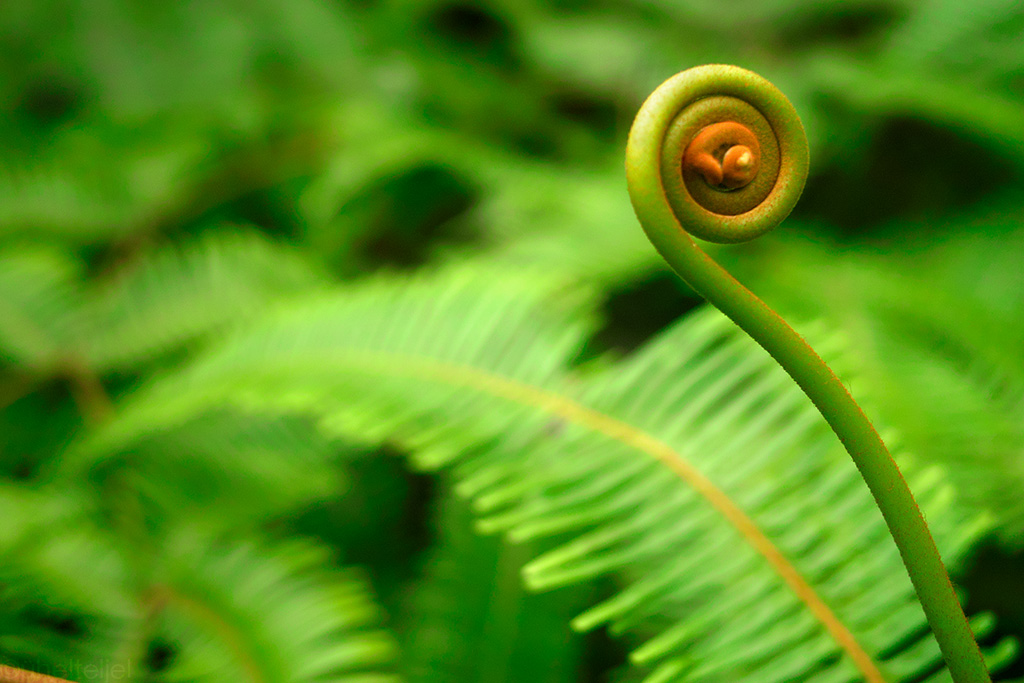
Gracious plants.
After thousands of kilometers on dry, open lanscapes, it was truly refreshing to ride through the jungle - so green and so abundant. Probably it is also due to the fact that together with crossing the equator we also crossed into the rainy season, which means, at least for a while now, riding under overcast skies, or in the worse case, in torrential rains. But the good thing is that it should be mostly tar roads from here.
<img src="http://yhelteljel.ee/wp-content/uploads/2011/08/Kamerun-3s.jpg" width="1024" height="724" >
Nice smooth road through the south of Cameroon.
In Cameroon, our plan was to ride to the town of Kribi on the shores of the Atlantic Ocean. Coming from the south, there are two possible approaches to Kribi - one is via the main tarmac road through the capital Yaounde, and the other, via a direct dirt road through the jungle. Surely the second option sounded more appealing.
But the problem with dirt roads is that although quite acceptable in dry conditions, they can become terrible, if not impassable during the wet, just as if you were riding in butter. And currently it is the rainy season here… But the weather was telling us something else, with even sun peeking out from behind the clouds just as if it was trying to encourage us to try and get the wheels muddy. And this is what we did.
It all began pretty well, the road being dry and hard as rock, so we could not have slipped if we wanted to. All we had to do was keep the fingers crossed for it to stay that way, because if it was going to rain on the other end of the road - which is 170 kilometers long - it would have been a terribly long way to come back. But it started off nice, with thick jungle and atmospheric villages.
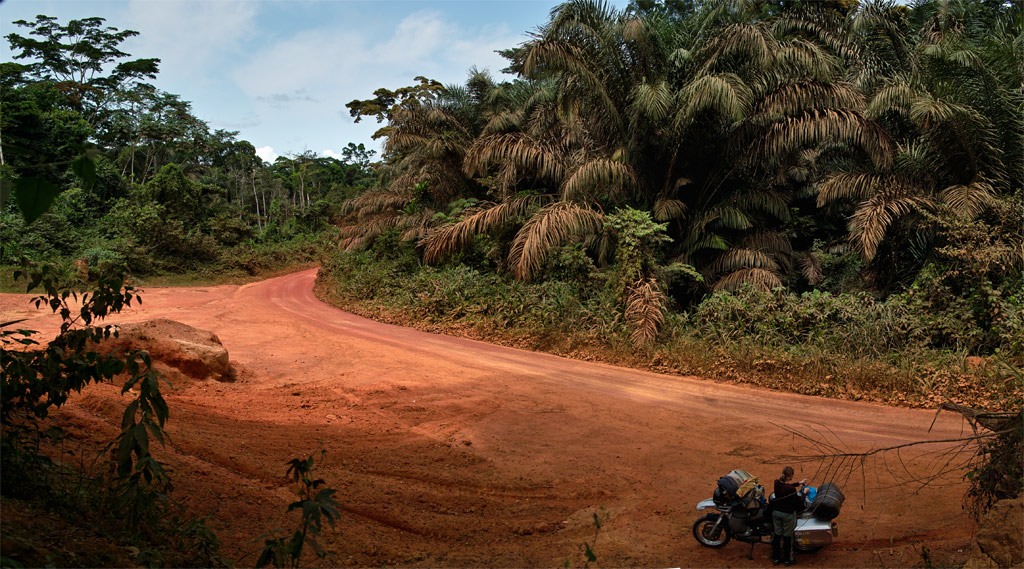
A lunch stop on the way to the Atlantic Ocean.
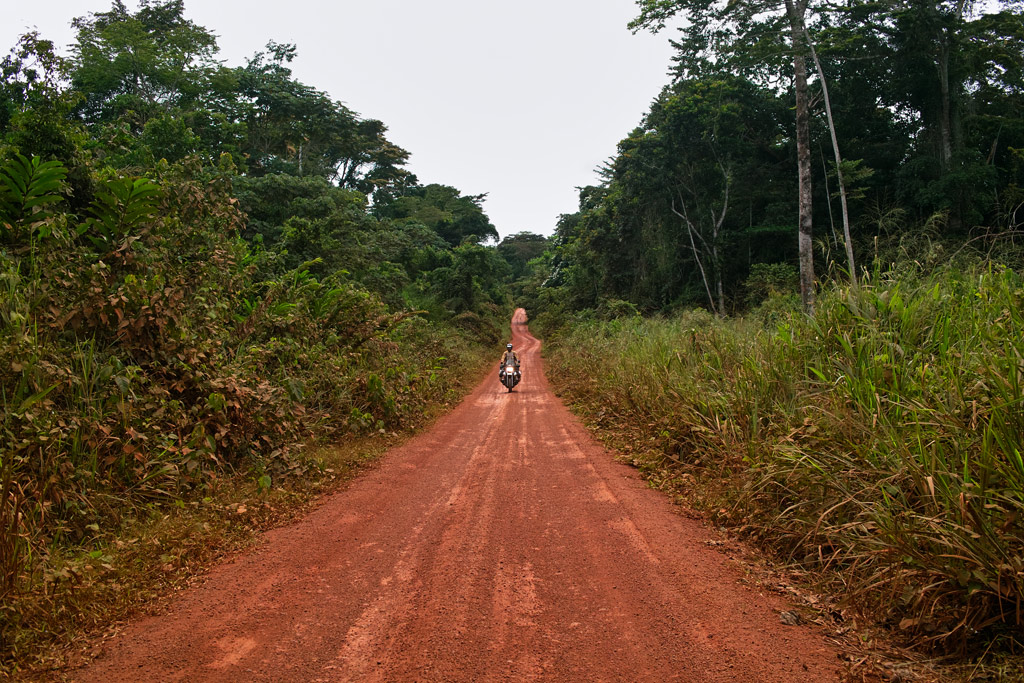
Through the jungle…
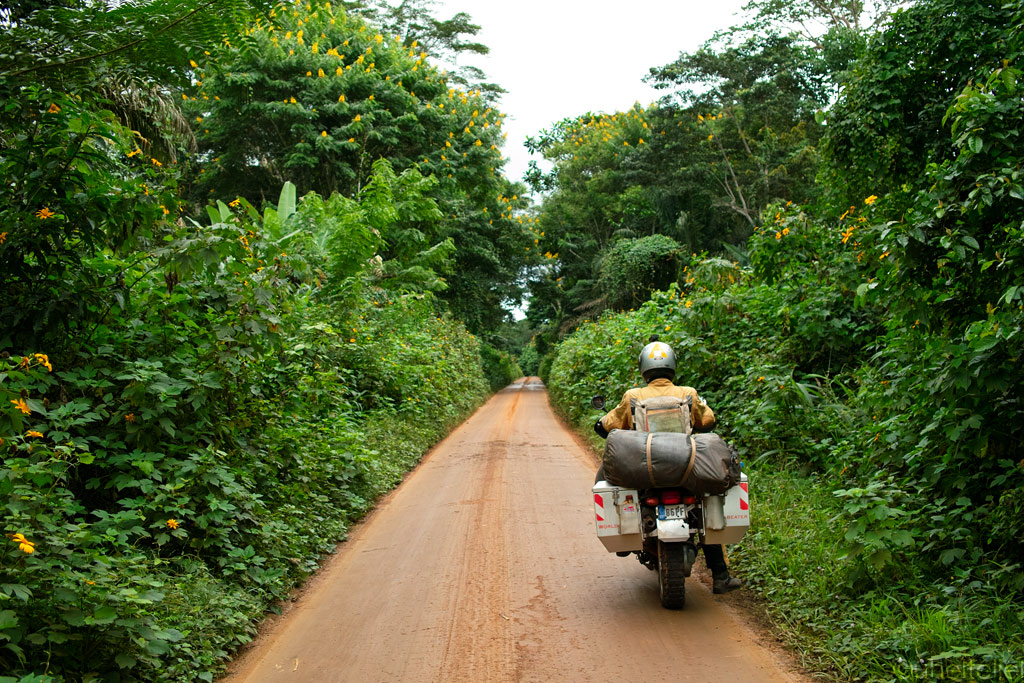
Lush and green.
But then something happened that we'd half expected to happen - there was a thin layer of moisture on the ground in the shade of some trees, and as we rolled onto it, the bike started to wobble and voila! there we were lying on one side. At the same moment, another bike coming our way crashed in the very same spot but on the other side of the road. We all just laughed as it seemed purely absurd.
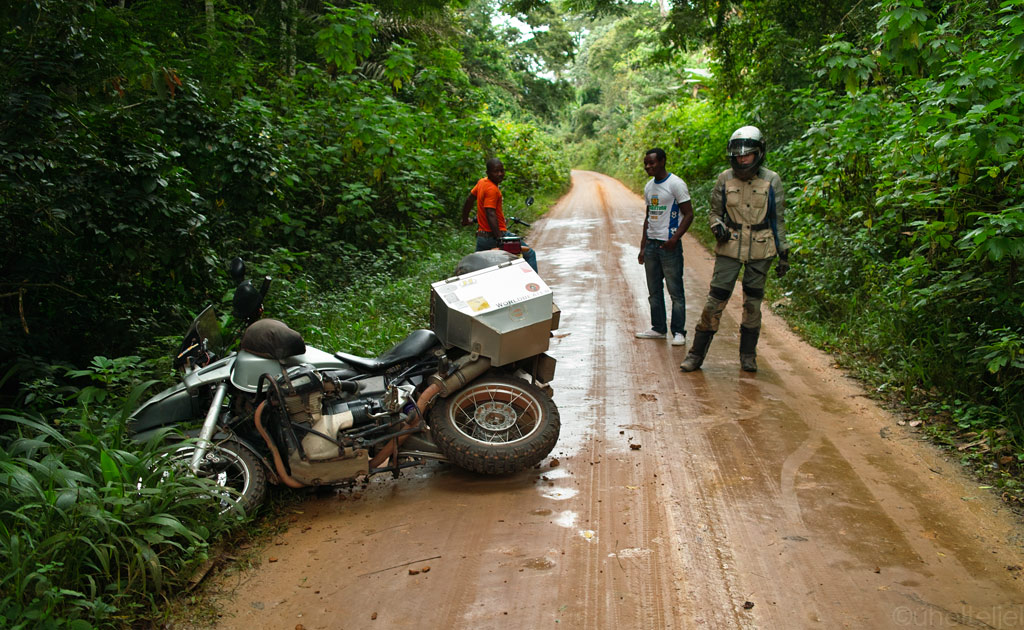
Before I could get the camera out, the locals had already picked their bike up.
We should not have to though, because this incident wasn't without casualties - the right side pannier on which we had fallen with the full weight of the bike had bent so that there was now a clearance of around a centimeter between the pannier and the lid. With this setup, we had to keep our toes crossed too that there would be no rain as the pannier was very far from being waterproof now.
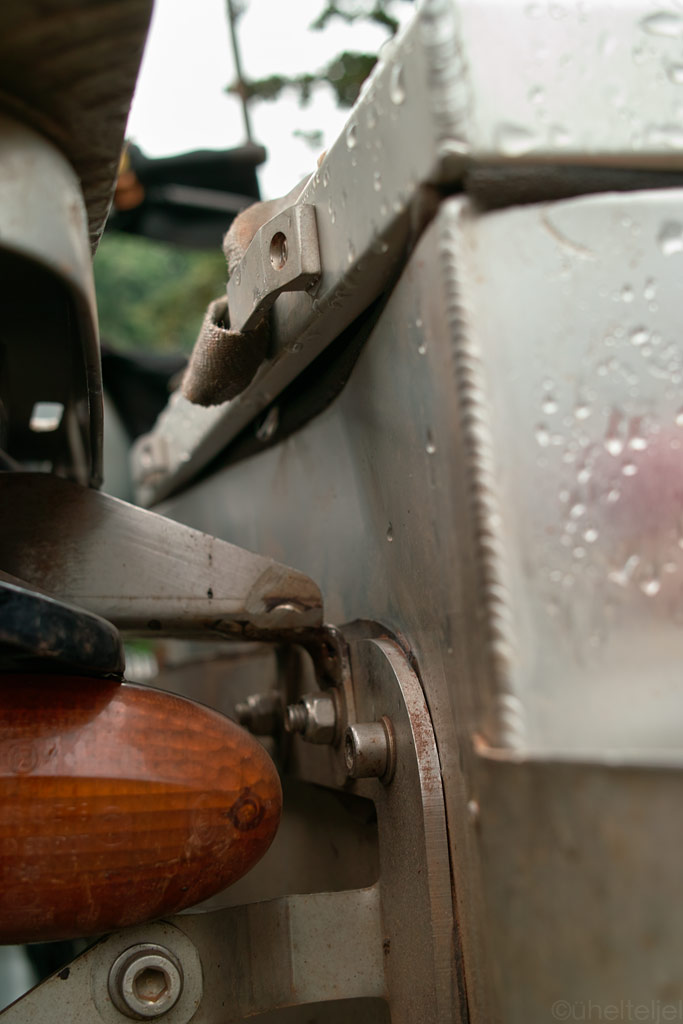
Not the way to travel in the rainy season - and as you can see, it is drizzling...
But the villages alongside the road were all cute and the jungle was truly mysterious.
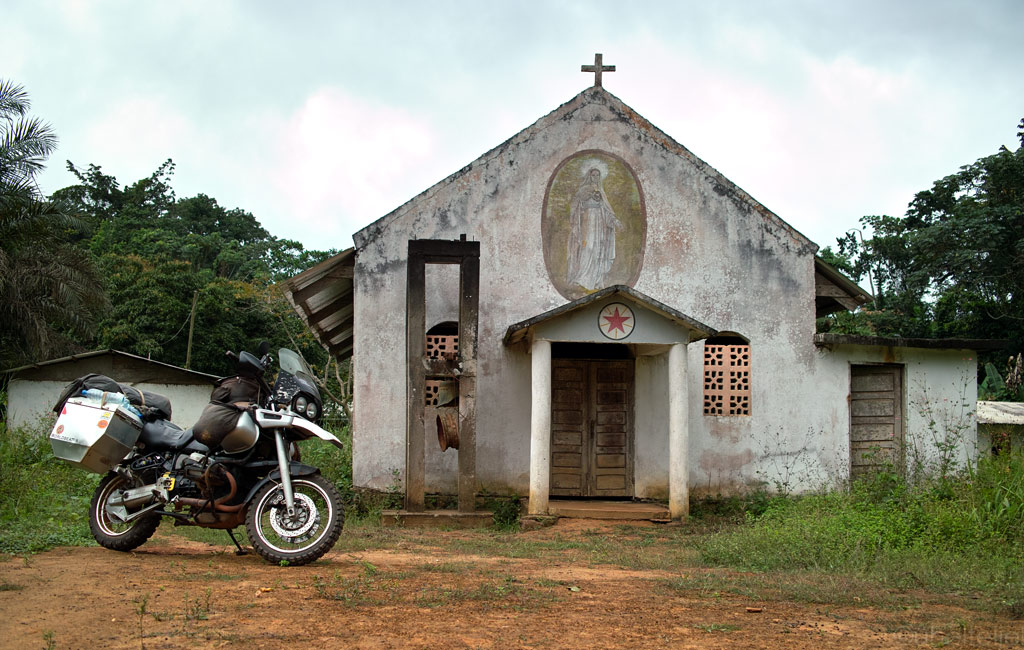
A church in a roadside village.
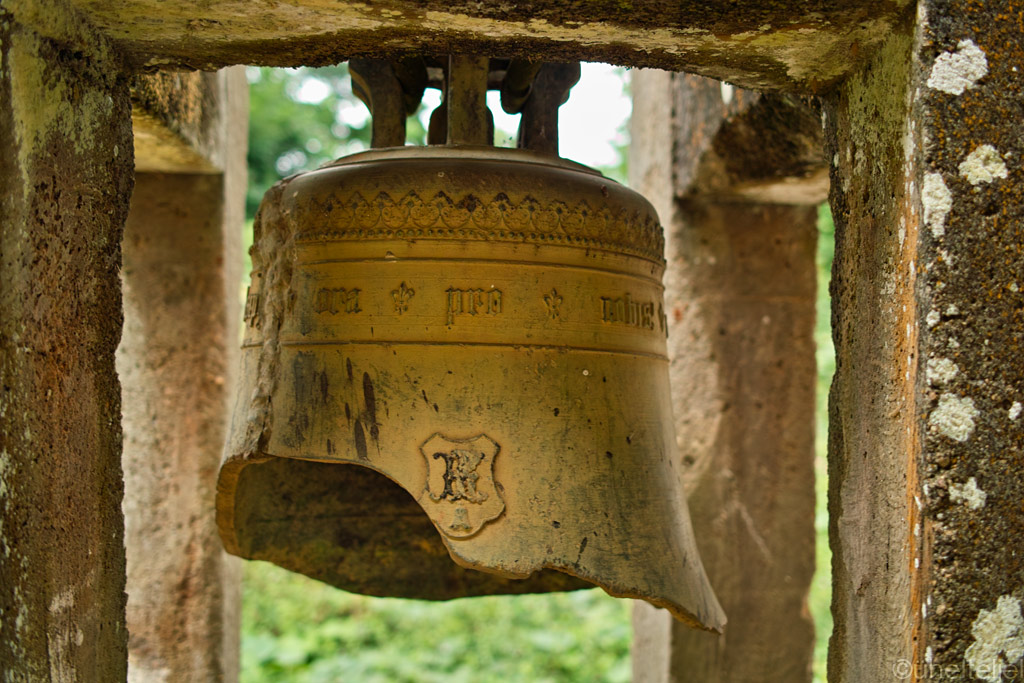
An old bell - broken, but still operational.
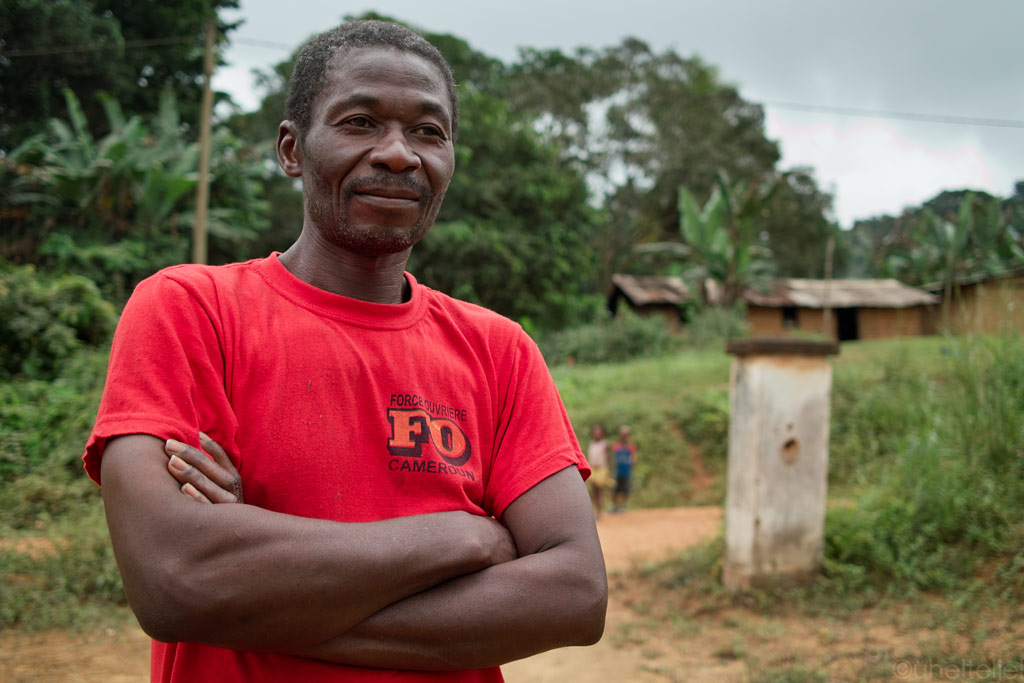
Jean-Paul - a local who came to chat to us.
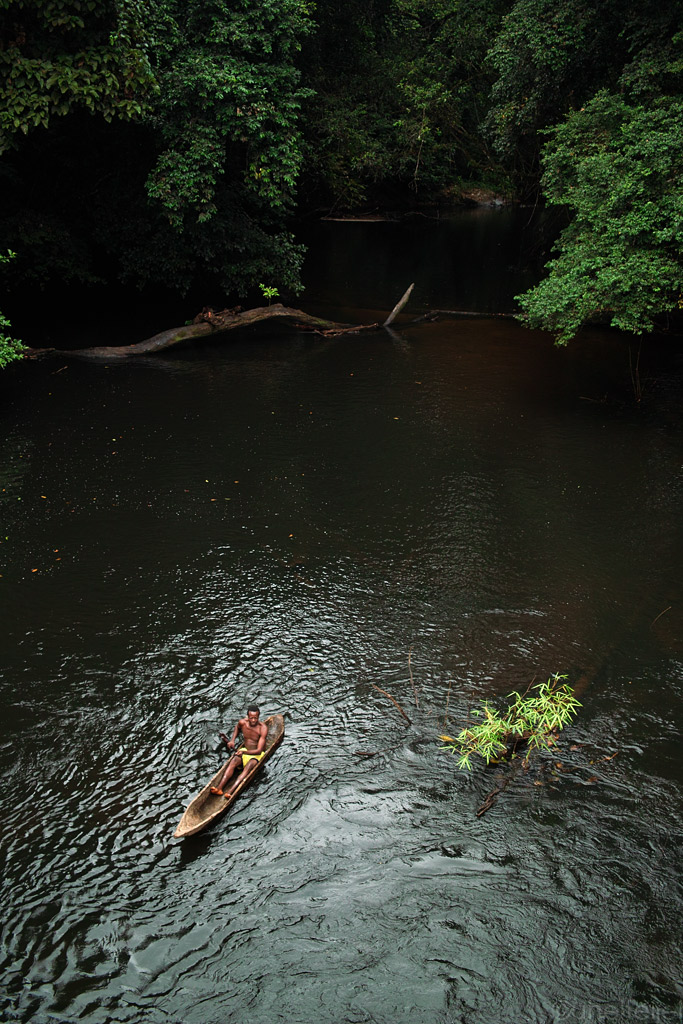
A local rowing his boat on the dark waters flowing through the thick jungle.
When we had covered around 110 kilometers the clutch lever suddenly became loose, and as we stopped to determine the reason, I discovered the clutch arm had broken in two. We were still 60 kilometers from our destination, and we could not change gears, so we had to ride without. Somehow, through a miracle we made it, bumping into, across and through numerous holes in mostly 2nd gear, wondering if at current pace of disintegration we'd ever make it home.
But Kribi is the kind of place where it would be quite OK to live - the palm trees, the ocean…

A panorama from the beach at dusk.
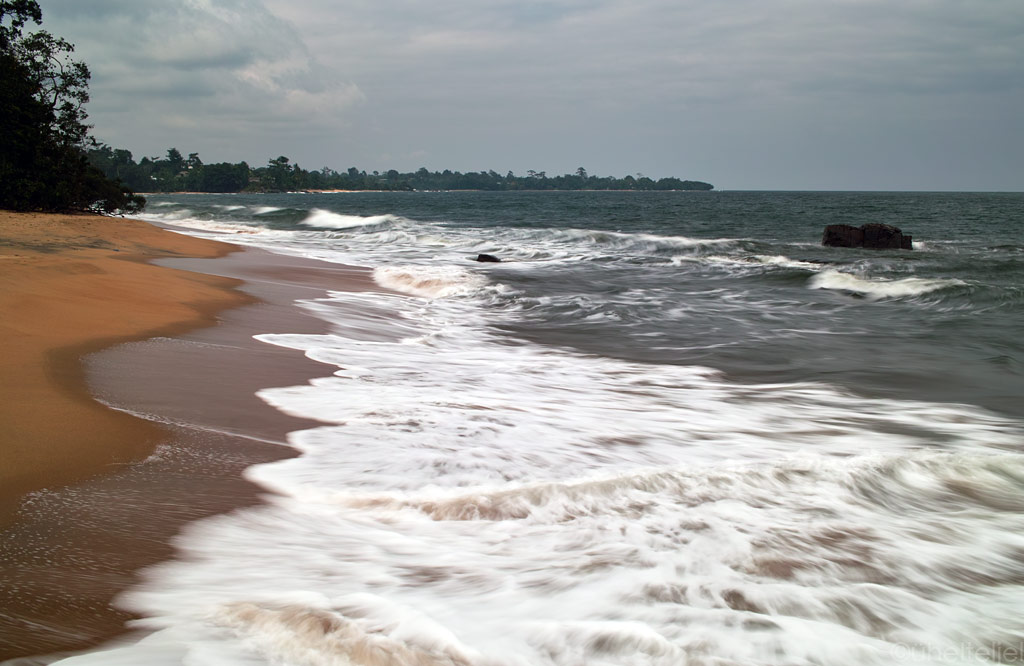
The beach of Kribi.
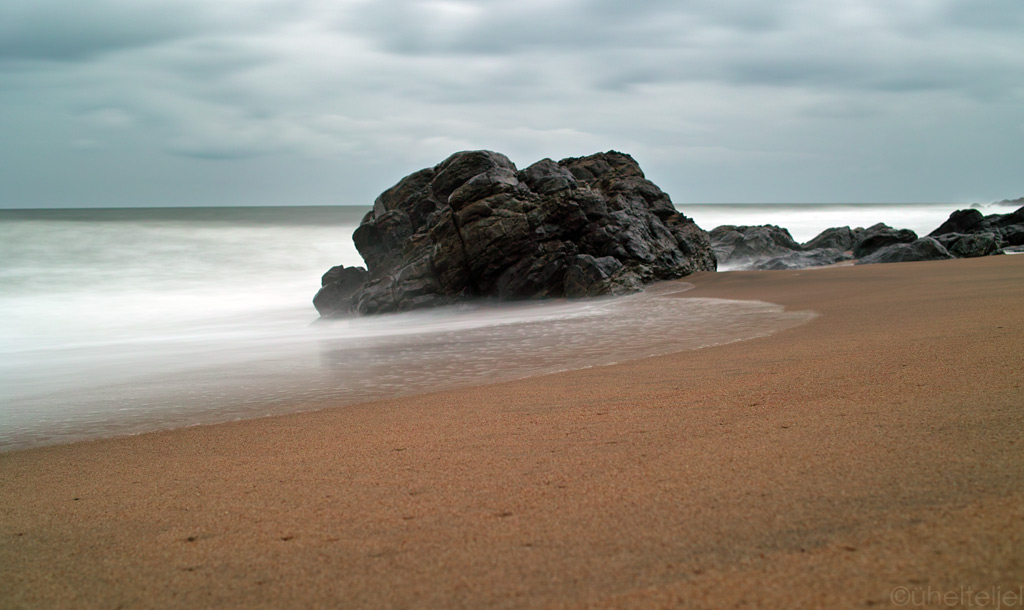
Rocks on the beach.
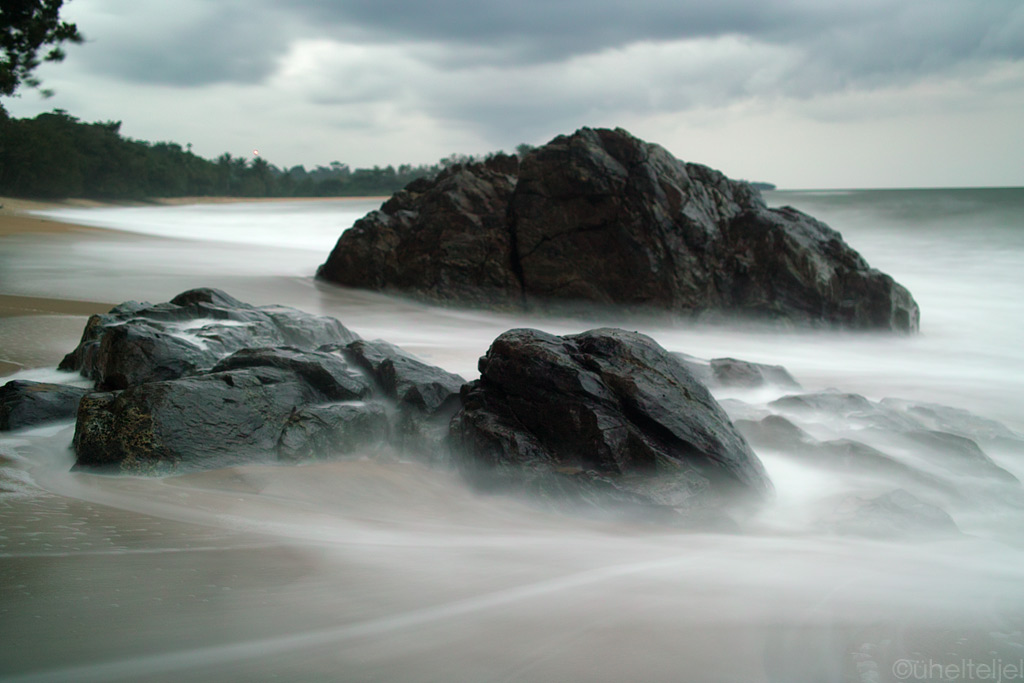
Washed by the waves…
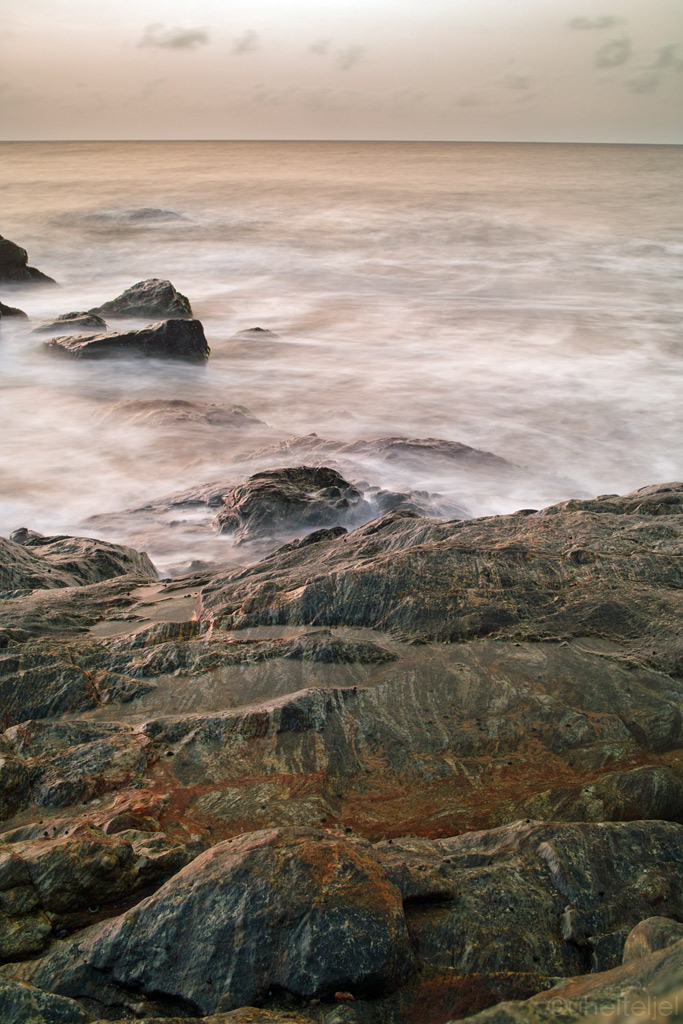
The Atlantic Ocean.
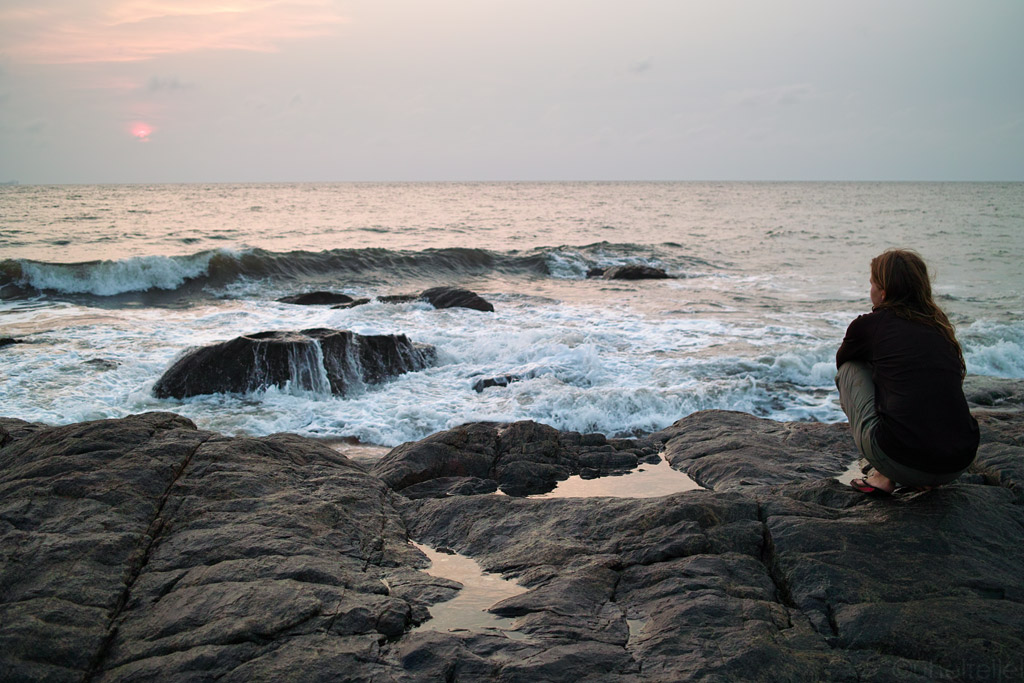
Embracing the sunset.
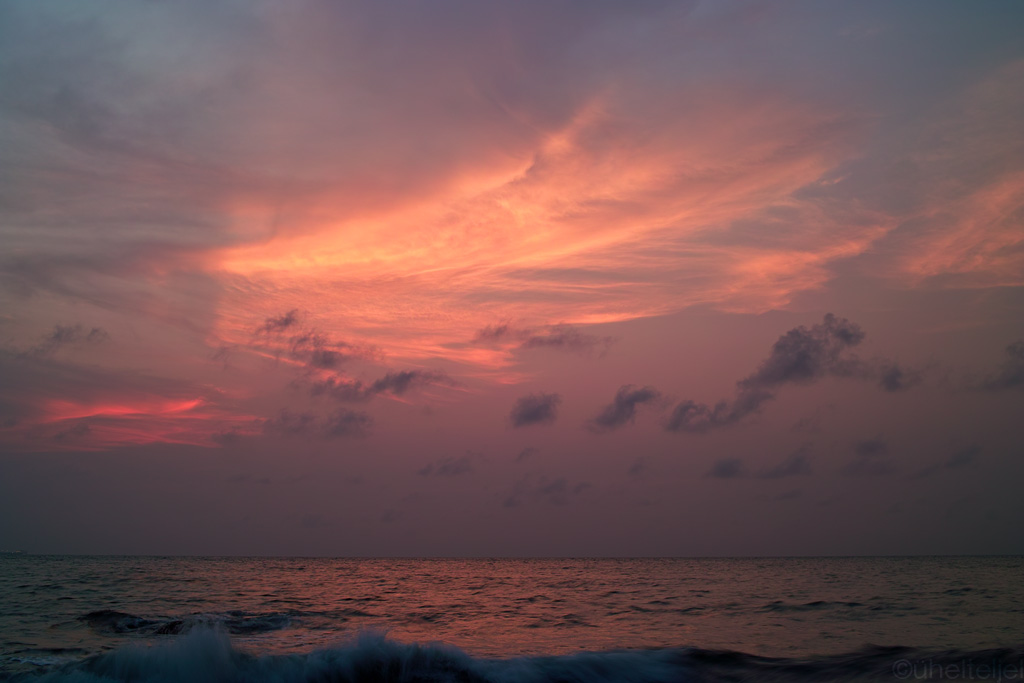
Hypnotizing skies above the ocean at dusk.
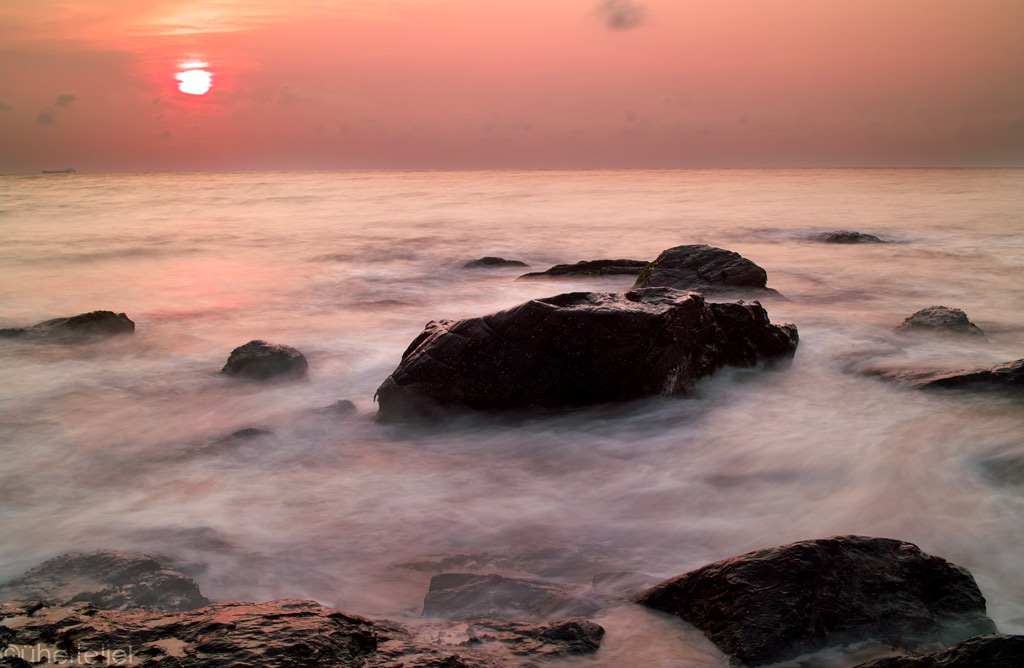
Sunset.
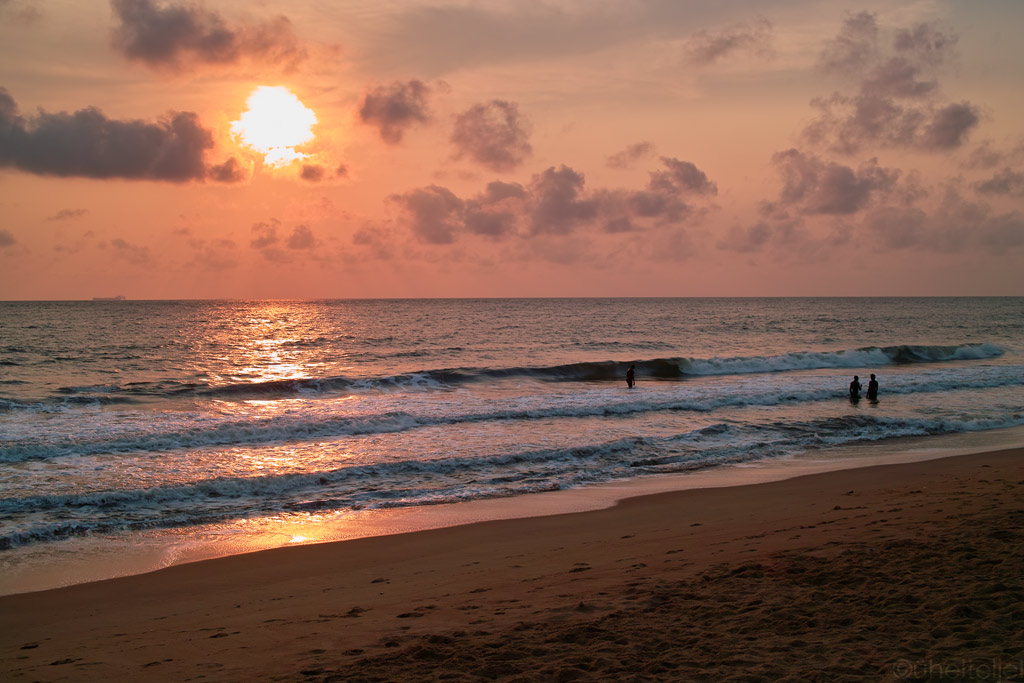
On Kribi beach.

Panorama of one of the lagoons on the beach (click to enlarge each panorama)

Panorama of boats on the beach.

A panorama from the beach during sunset.

A panorama from the beach after the sunset.

The night is approaching.
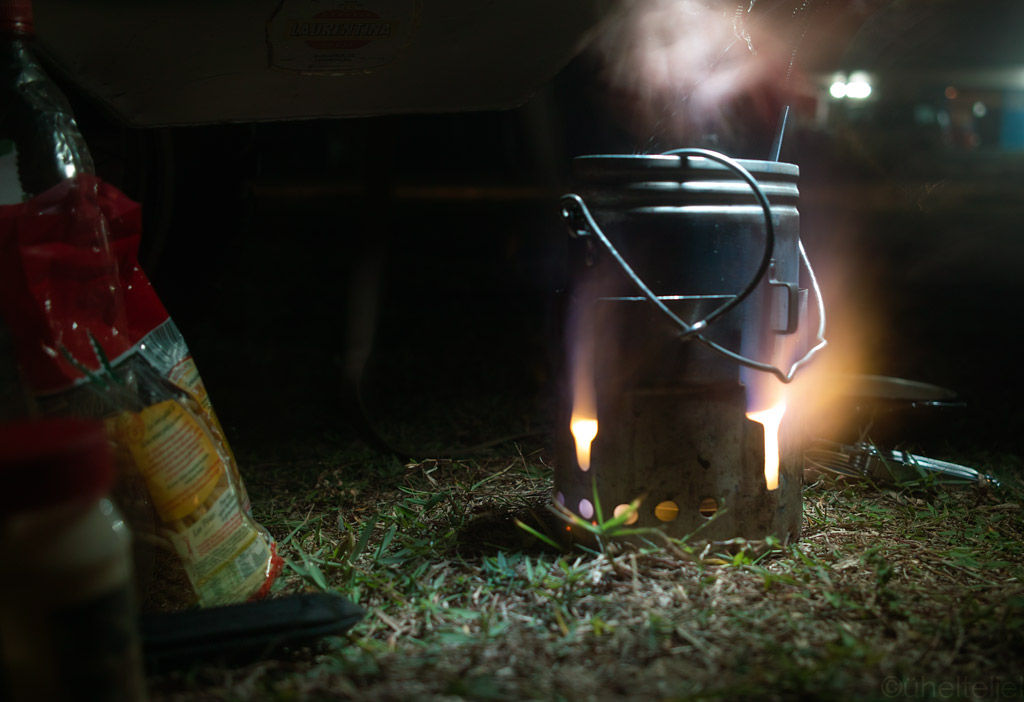
Cooking in the dark.
It wasn't all relaxing and fun in the sun though as we had to start dismantling the bike again - somehow, we had to get the broken clutch arm off the bike, have it welded and try to reinstall it, but without taking off the swingarm (and we were not going to do that unless absolutely necessary) it was going to be a mission. Getting it off was realtively easy, but getting it back in place was so tough we'd though it would be impossible - working in a very confined space (barely enough space for one hand), trying to screw it in at a right angle without dropping it into the swingarm took us countless attempts, but after long hours we managed. Now we only have to hope the African welding holds.
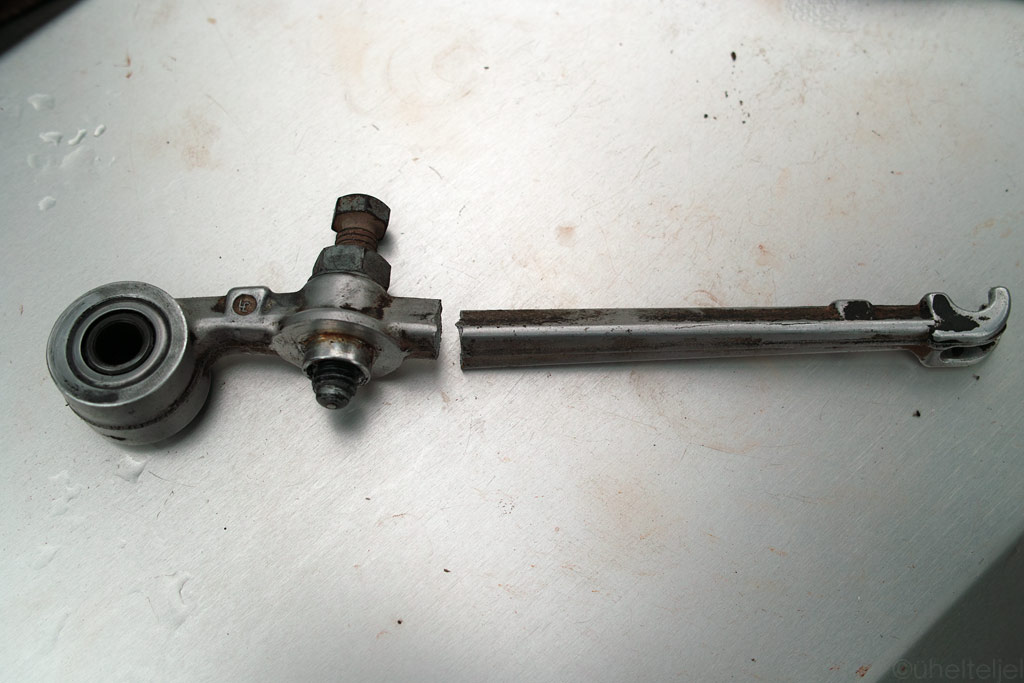
The broken clutch arm.
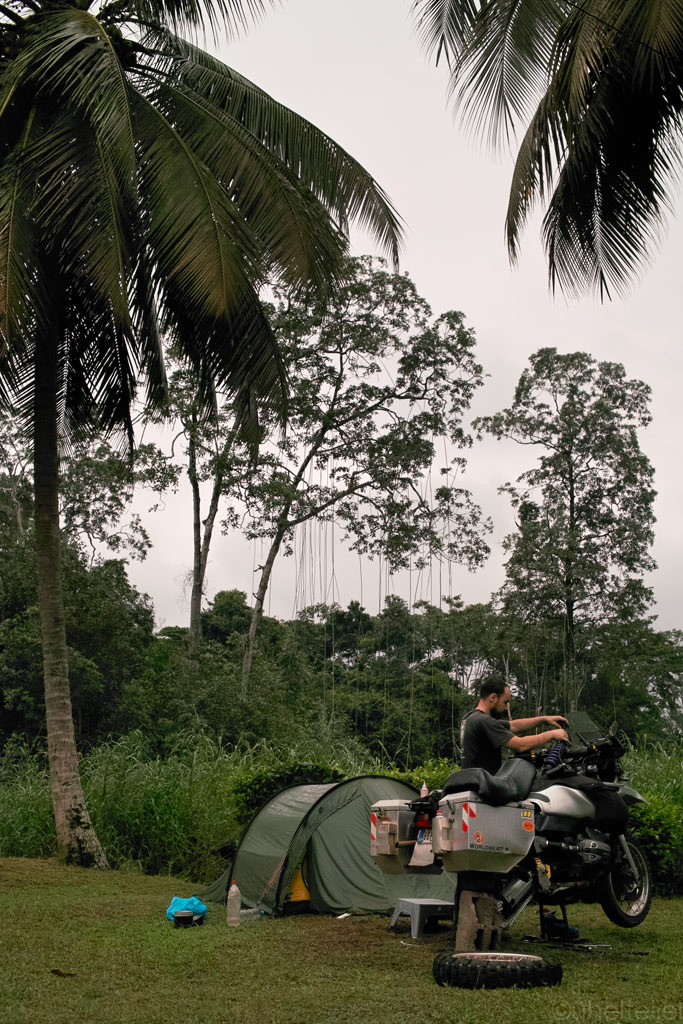
Working on the bike at our campsite at the beach.
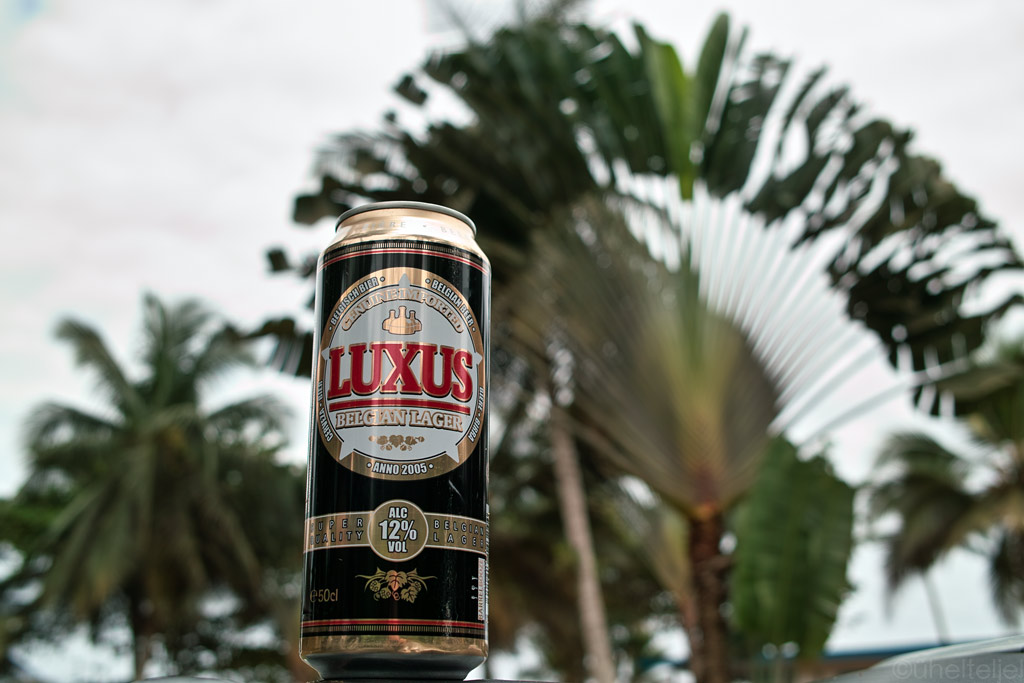
Some rediculously strong beer to calm us down during the stressy times of technical problems...
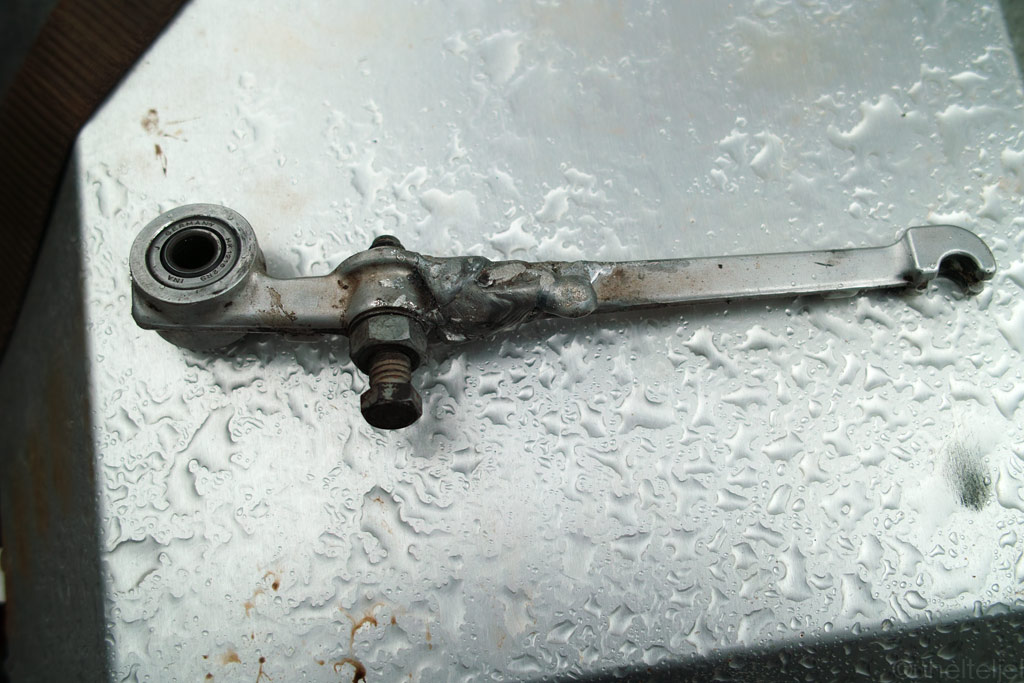
Welded.
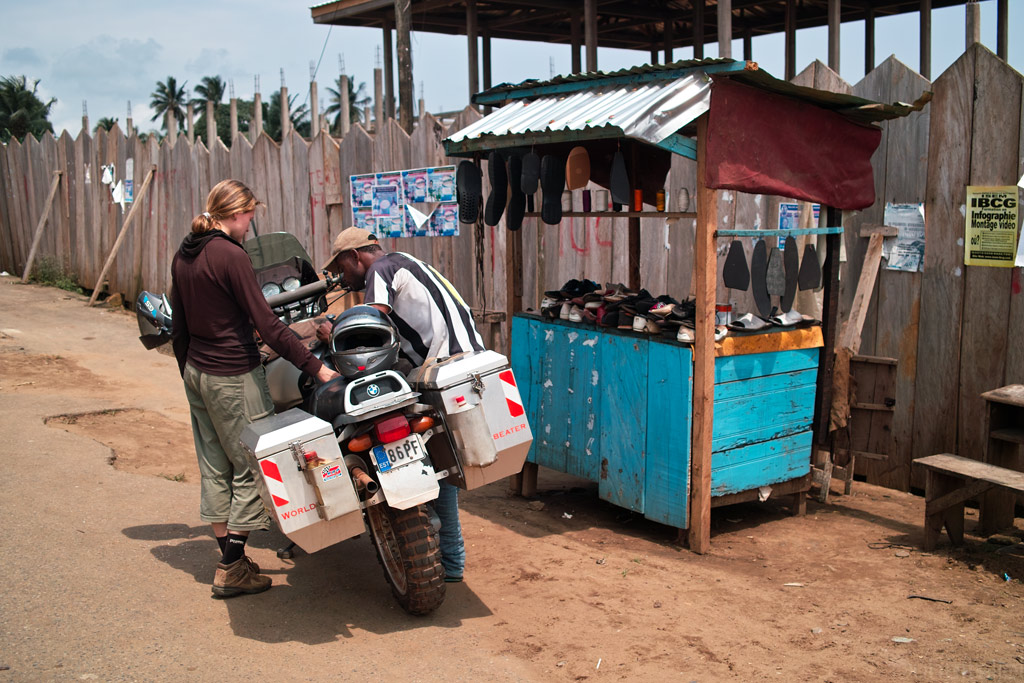
Also, we had to stitch back the tank bag fasteners. Streetside shoe repair.
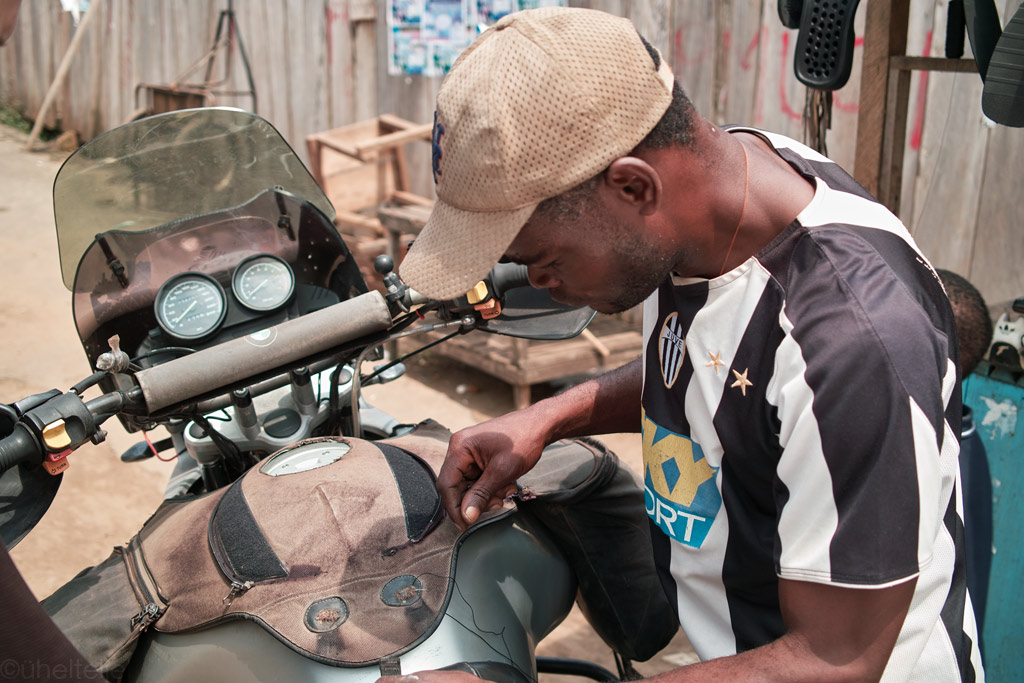
Stitching the tankbag's fasteners, again. And it's a heavy duty tankbag - all the zippers are replaced and it's been repaired almost from everywhere by now. To look things positively - thank God we don't have soft-luggage panniers - they'd have completely disintegreted by now.
And to beat the pannier straight. There were some tiny cracks in the pannier too, but welding them here could have made things worse, so we'll have to hope they don't become bigger before we can find a decent spot to weld - they're good as they are.
After Kribi we headed straight to Limbe which too is situated on the coast, but the idyllic beaches we'd seen in Kribi were nowhere to be found, and it was pouring rain, all the time, every day. According to some, it is one of the rainiest places on Earth - and even if it happens to be not true, it is definitely the rainiest place in the whole subsaharan Africa - the city of Douala that is just a stone's throw away has a climate chart uncomparable to any other cities in the region, with rainfall averaging more than 400 mm a month from June to September.
So obviously it wasn't for a beach holiday that we went there, but for serious business. The thing is that from Cameroon there are basically two options for continuing north - either to Nigeria, or through Central African Republic and Chad to Niger. And although the second option sounded far more appealing, our recent experience with sand (and on the route around Lake Chad there is A LOT of sand, take or leave it) told us to steer clear of that one and opt for Nigeria. To be honest, we were not particularly excited, or at least not in a positive way, but it was our best bet.
But it wasn't going to be as simple as that. The main bordercrossing from Cameroon to Nigeria is currently very difficult to access due to constant rain, the road leading there, with loads and loads of sticky, slippery mud, deemed very difficult even for fourwheelers. We decided to give the muddy ballet a skip and get onto a ferry to Calabar, Nigeria instead. The ferry leaves from Limbe to Calabar once a week, so we had to endure a few days of rain while waiting.
We were lucky to be allocated some space under the roof of a hotel's open air bar for camping - otherwise we would have been washed away by the massive downpours. But it still felt terribly damp and grey, and Kariina couldn't help herself but to stare at the map we have about North Africa, focussing on the area around Mauritania, and going over and over again that she had a nostalgia for the desert.
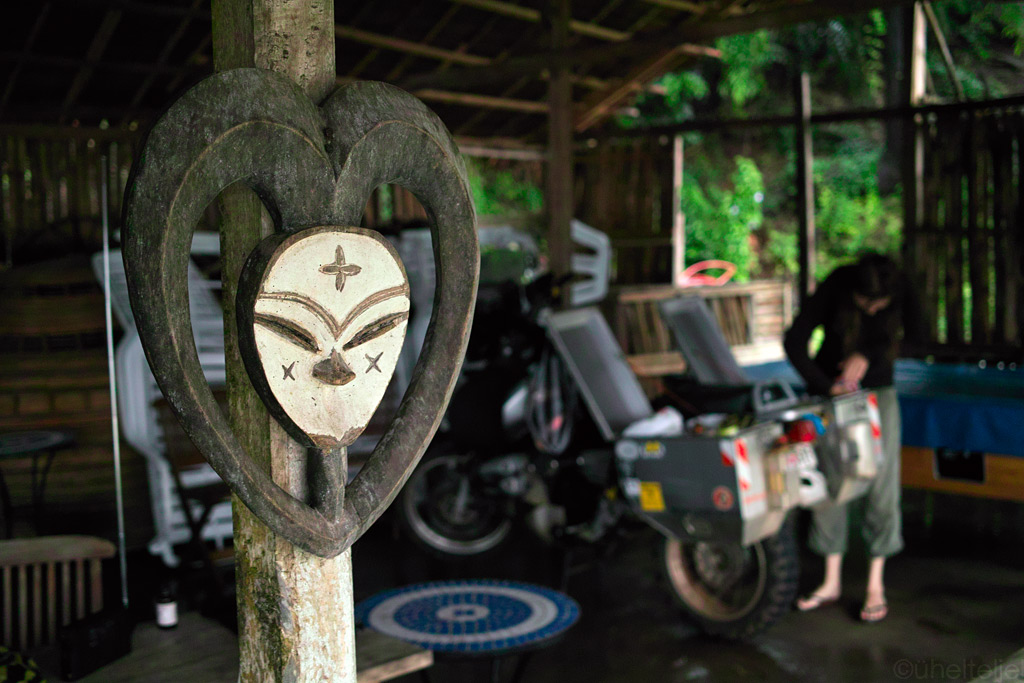
Traditional paraphernalia decorating our temporary home.
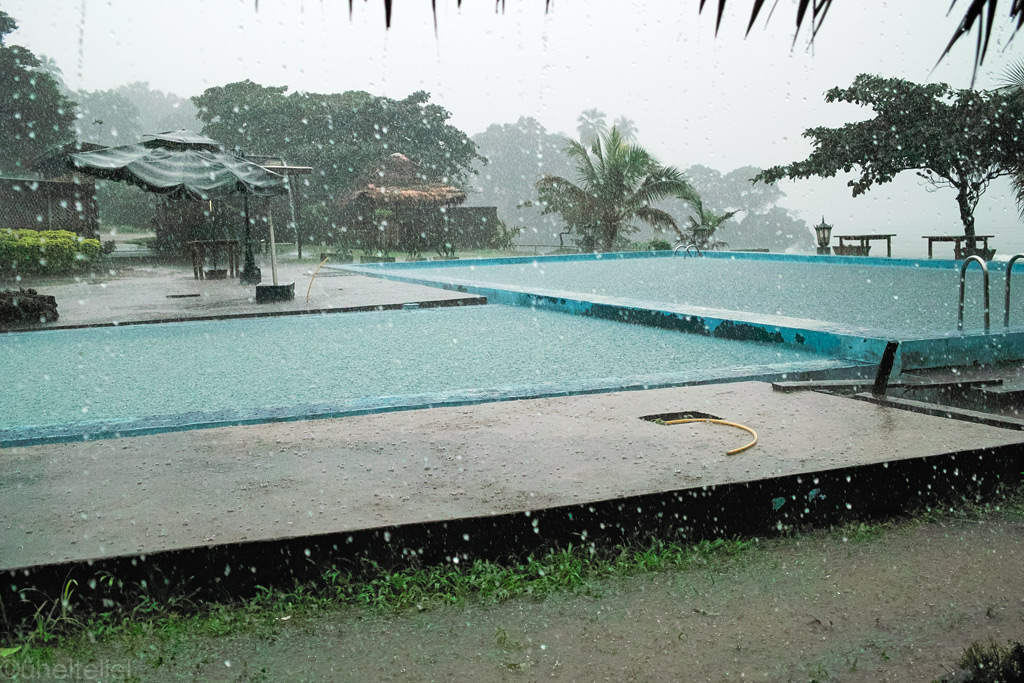
View from our camping spot - it was simply pouring!
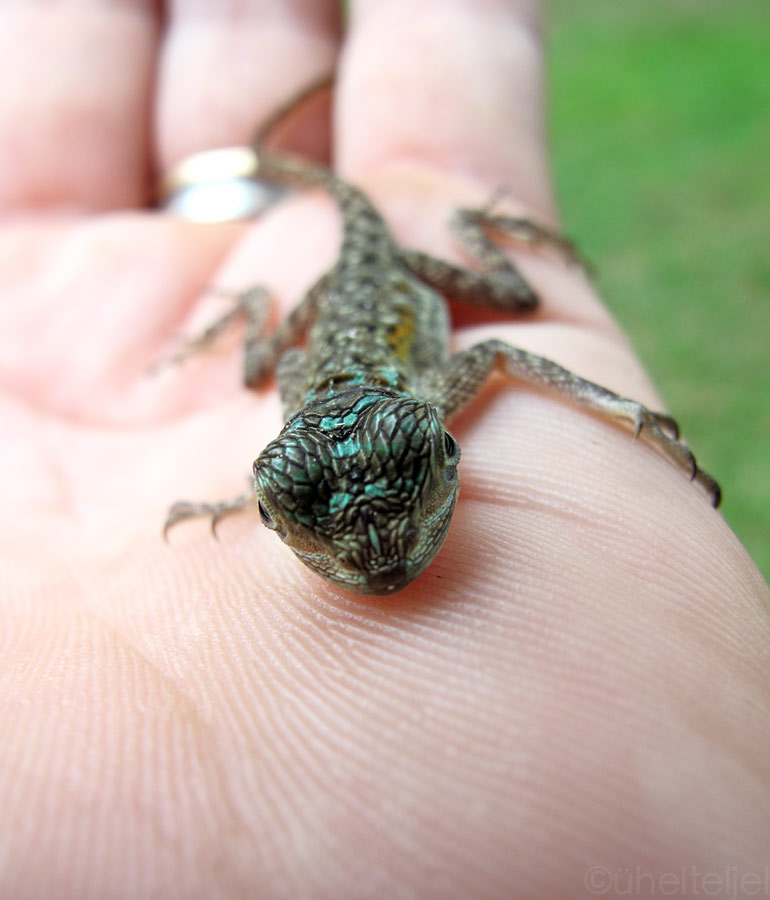
A small lizard.
One afternoon, the skies cleared up a little, and we decided to check out the town of Limbe that we hadn't had chance to get acquainted to yet due to the rain. We found a nice fish market teeming with activity - men sorting their nets while women were grilling the fresh catch, and all the rest of the people enjoying themselves with a couple of beers.

A panorama of the bay as seen from our camping spot (click to enlarge).
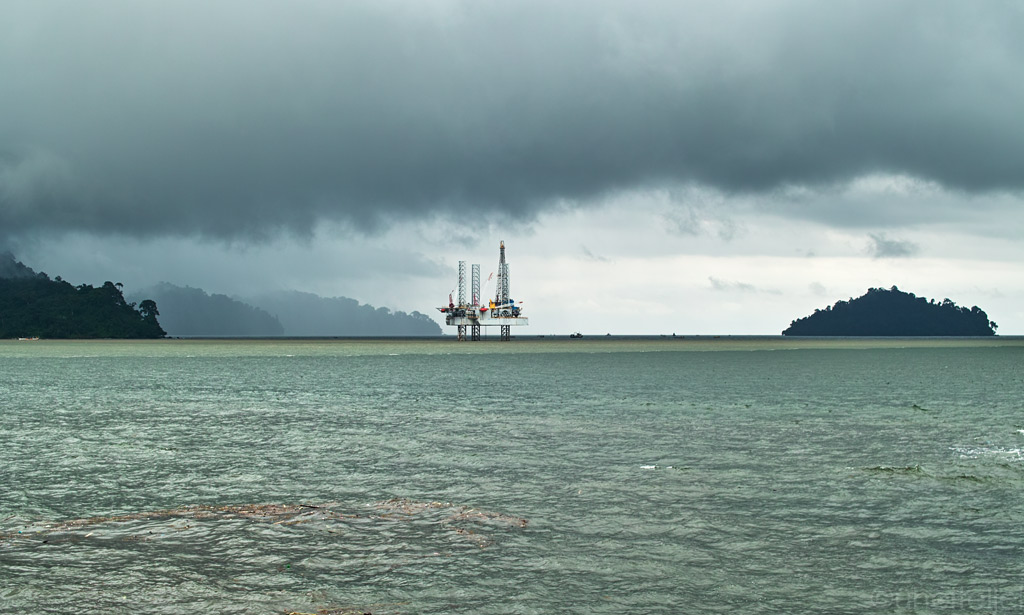
…with a drill tower in the middle.

Fishing boats ashore (click to enlarge)
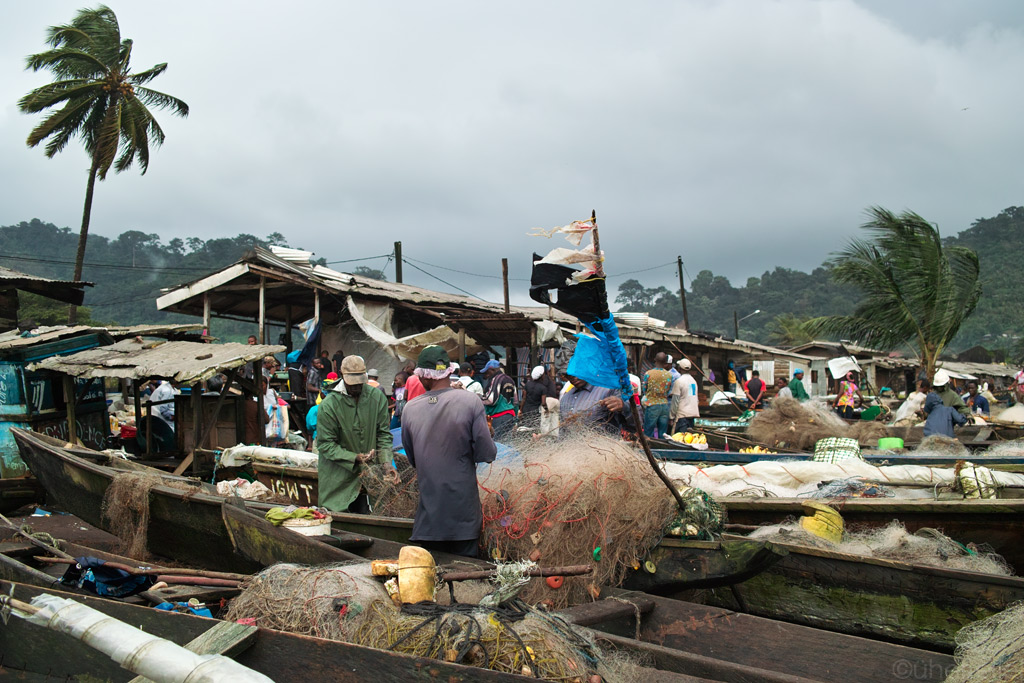
Fishermen working under the stormy skies.
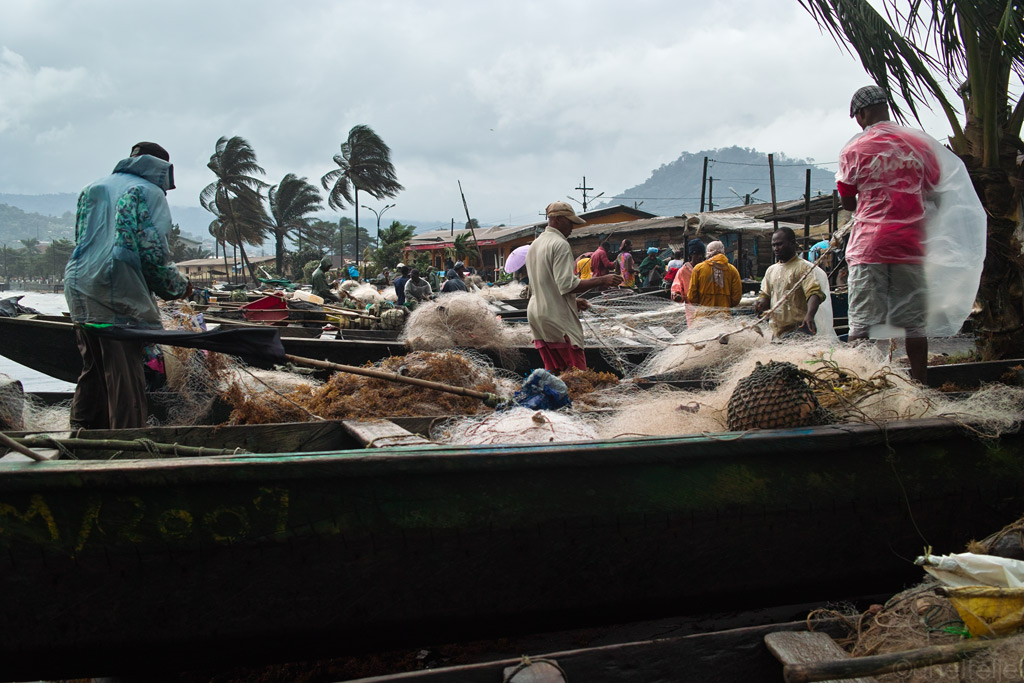
Sorting the nets.
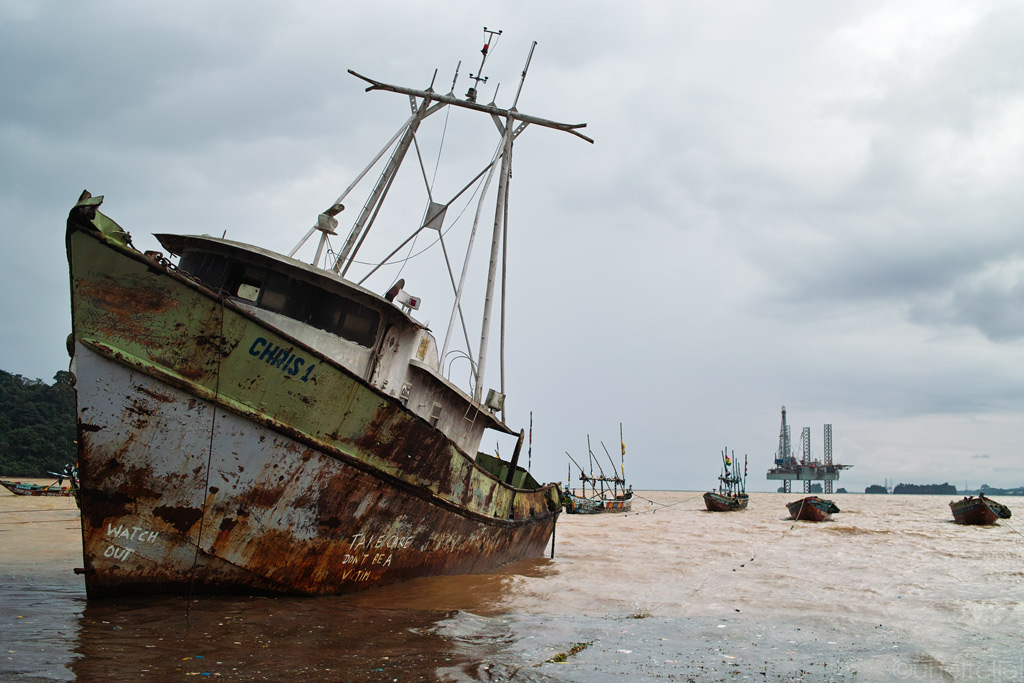
A sunken ship.
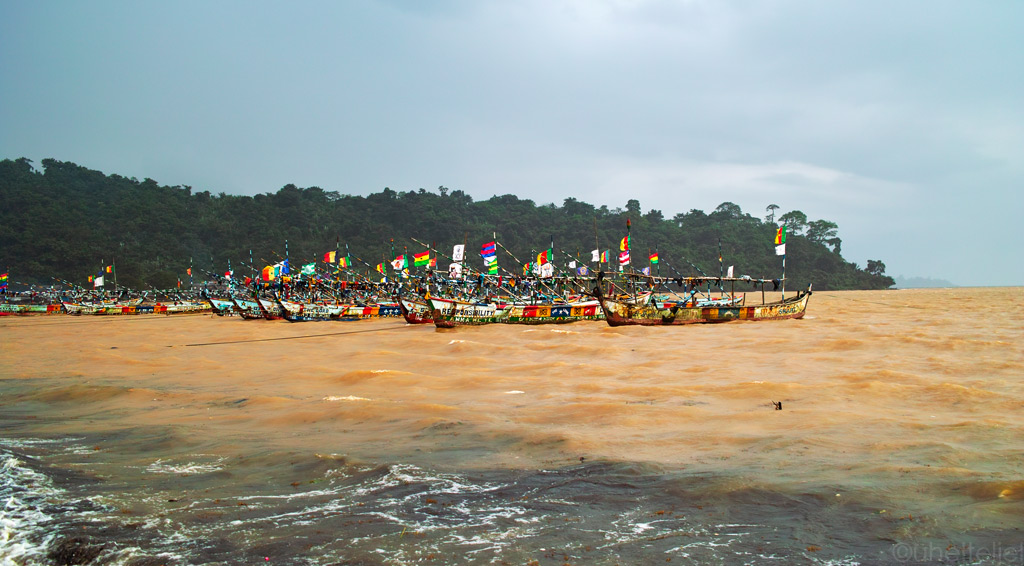
Boats with flags in the bay.
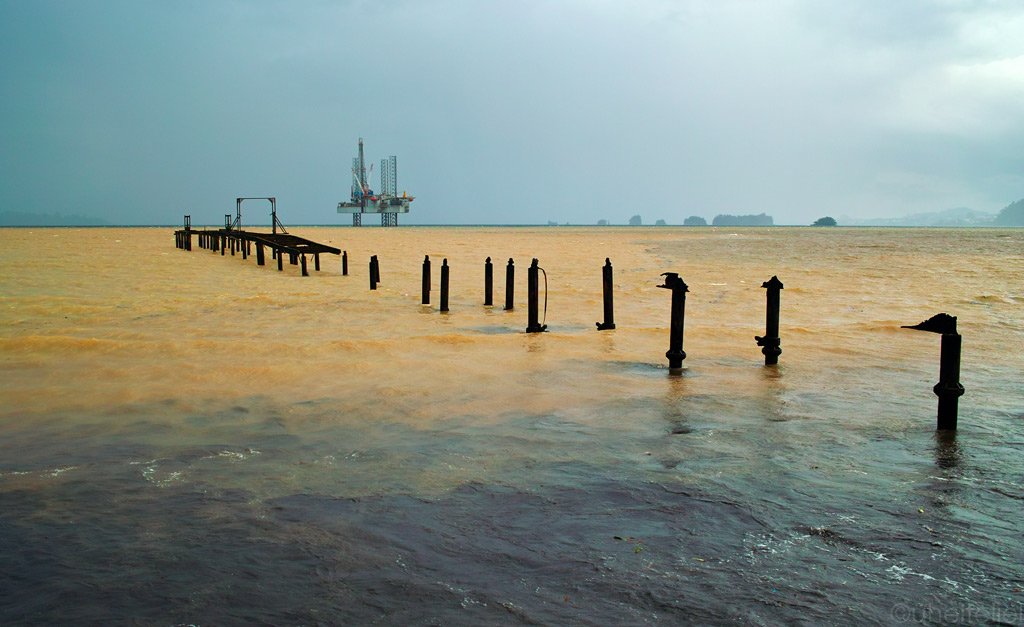
The bay as seen from the town.
Then finally the day arrived when the ferry was scheduled to depart. We got to the port by noon to get the bike loaded onto the ferry (best done during the high tide that almost levels the ferry and the dock so that it is relatively easy to squeeze the bike in through a narrow door), and to get over with the formalities. The latter ones were easy, but loading was another story. Well, not so much the loading, but agreeing on the price to get it loaded. After having listened to the talk about the "volatile markets in Europe and the US" that were supposed to justify the ridiculously high cost of it (to be more concrete, it was around USD 40 for a one-minute job of maximum three guys) we bargained hard and finally had it down to half less. Still a lot of money for what was to be done, but who were we to argue? Soon after the bike was loaded, the cargo hold was filled to the brim with boxes of bananas and other stuff so that the bike absolutely disappeared under them. All we could do was to cross our fingers and hope nothing would break under the load.
The ferry was scheduled to leave at 11.30 PM. At around 1 AM they finally let us aboard and we could start the ten-hour journey.
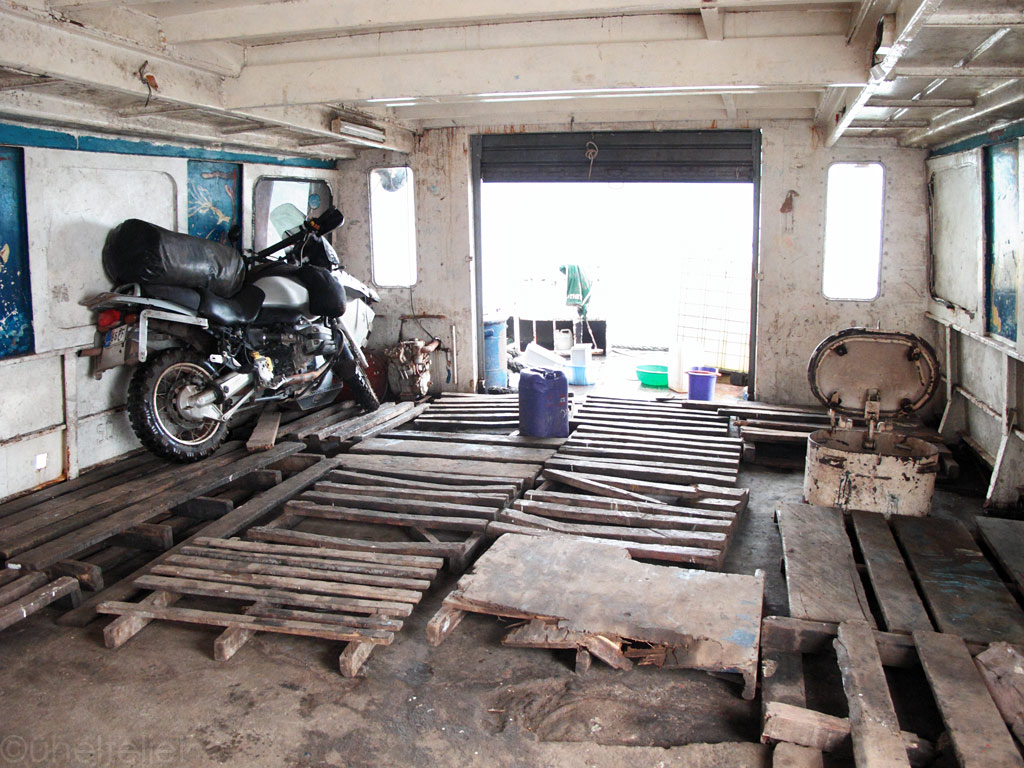
The bike was the first piece of cargo on the ferry - later on you couln't see it from under the rest.
We've been surprised many times over how easily and in which positions the locals here in Africa are able to sleep - while sitting on a bike, or in the back of a truck bouncing on a bumpy road, for example. Also on this ferry - as soon as they'd sit down they'd be asleep, only a few singing along to the Christian songs on the TV, half asleep. Most probably we were the only ones who could not relax on this overloaded ferry making its way across the stormy sea, and duly so as quite soon a young gentleman descended into the cabin, with a Bible in his hand, and started preaching. His first message was that the mobile phones should be kept switched off as the waters we were going to sail in were not safe. His second message was that we all should try and not move around too much in order to maintain the vessel's balance. His third message was mainly addressed to us, the only white people on board, and it was about us not attempting to ascend to the deck "to contemplate the nature" while in Nigerian waters. Not very encouraging, to say the least, but there was no turning back as the ferry was going towards the open water at full throttle. To conclude, the young preacher explained to the sleepy audience that we had nothing to worry about since God would watch over us. Amen!
In the morning we felt the ferry slowing down for a few minutes before continuing at high speed. It is only later, talking to the captain, that we learned that it was because of the pirates that had circled the ferry. This is being exactly the reason for not letting us go to the deck - white people on board could have meant big trouble.
As we arrived in the port of Calabar, it took once again some time to wait for the hight tide to unload the bike (big haggling again!). Meanwhile we were interviewed by the SSS (State Security Service) who asked us questions like how much did the fuel cost in Cameroon etc, just as if there was a reason to believe that we were not who we were pretending to be. It certainly was ironic, as it was us who came there with doubts and preconceptions, and instead we were the ones that were interrogated.
About those doubts and preconceptions - Nigeria really isn't as bad as it is often being depicted, world famous for scammers and in travel literature, for countless checkpoints along the roads manned with greedy officials (or unofficials). But just as many a traveller would tell you, the Nigerians are some of the most friendly and helpful people, and as for the checkpoints - we were only stopped twice, nobody asking for money. The only nuisance was constant pointing of fingers and yelling at us "White man! White man!", and of course, the suicidal traffic. And the roads had a few surprises for us - such as some bottomless mud holes stretching across the whole road that managed to swallow us so it was a real pain to get out.
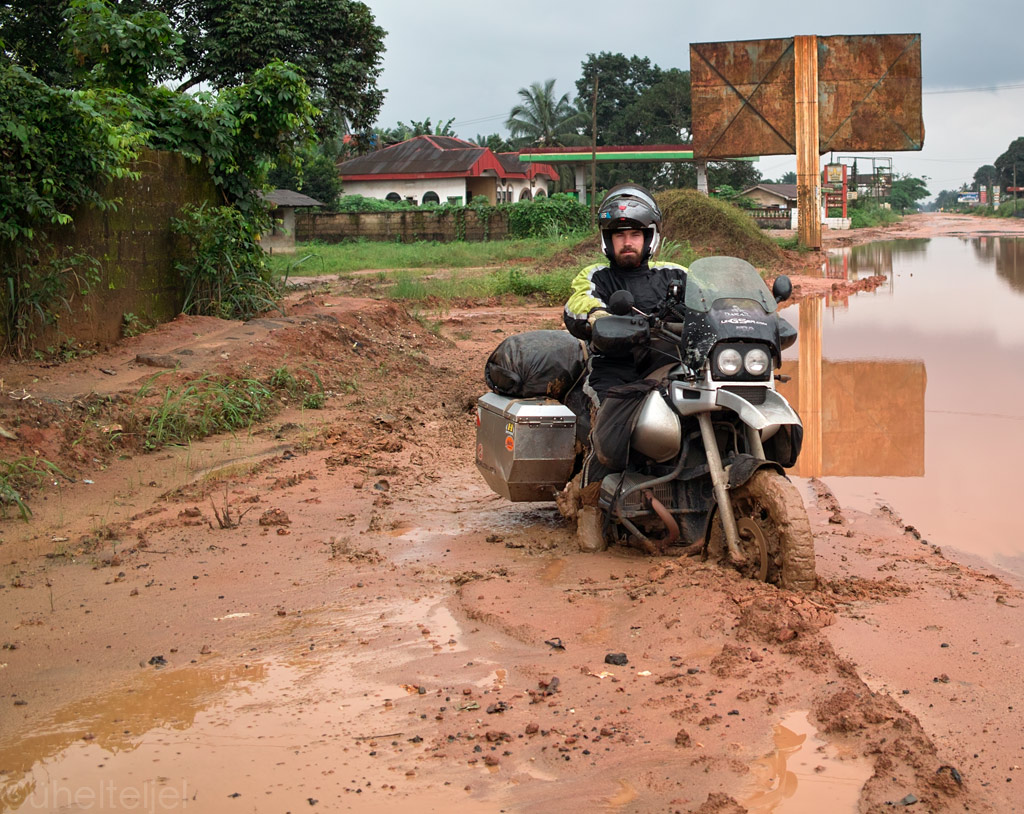
Deep in Nigerian mud.
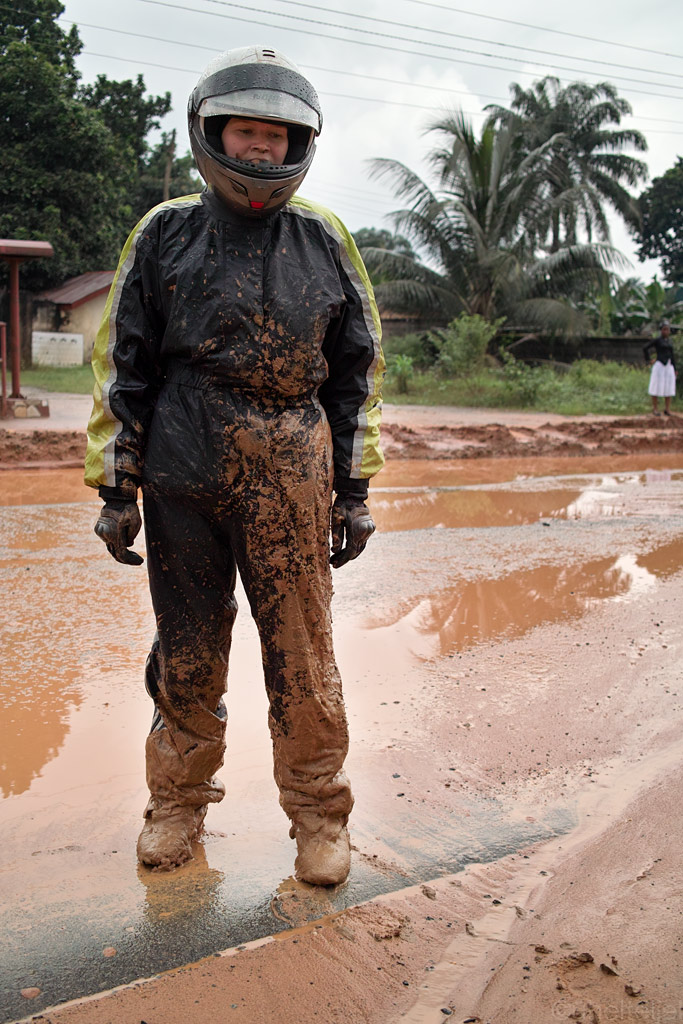
After doing some pushing.
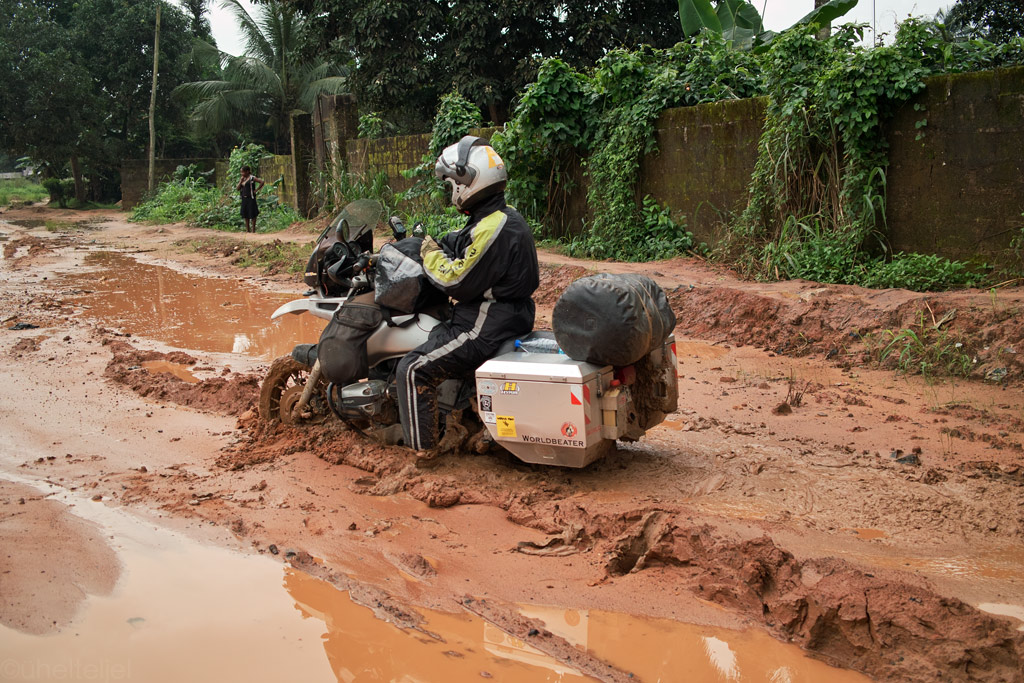
Fun and games.
Our plan was to cross Nigeria in a shortest possible time, and I guess we managed - in just two days! Normally we don't adhere to this tactic, but it is rather expensive as there are not many possibilities for camping (and a reasonable hotel room starts at 25 USD), there is not much to see in the southern part (and due to the traffic we were not very keen on making a detour towadrs the supposedly more interesting north).
As we arrived in the coastal town of Pointe-Noire we were terribly disappointed to find out that contrary to our greatest hopes there was no Gabonese consulate there and we had to undertake the long, bad road to the capital, Brazzaville, as we needed to obtain visas for Gabon. From the good old border post at Luvo it would have been a few hundred kilometers of (reportedly) good tar, but we had no other choice but to tackle some more bumpy dirt and sand.
Since traditions are a good thing, we decided to spend our first night in Congo once again, by the church. Of course there was a Mass and later on a choir practice that night, all African style, with joyous melodies and lifely rhythms. Those same rhythms reminded us of that time in Kenya when our bike was loaded onto a pickup truck and we sat in the front with a young priest at the steering wheel, rocking down the incredibly bumpy road to Nairobi. The same religious songs had been revolving in the CD-player for almost 24 hours in a row, engraving the East-African beats deep into our sculls. And here we were again, hearing those rhythms in Congo! As it comes out, those rhythms actually originate from Congo, which is, according to some books, believed to be the heart of African music. Well, the reality is not so black-and-white of course, but we must admit that the Congolese music does reach across the borders.
...::: LISTEN the live mass at Dolisie Catholic church in Congo :::...

Serving the God - same moment when the sound was recorded.
… and from the rehearsal after the Mass, which was quite extraordinary for us as they also used a synthesizer, a bass guitar and a decent drum set, not just vocals (which were actually pretty professional):
...::: LISTEN live pratice in Dolisie, Congo Republic :::...

Practice in the dark as seen from our tent.

Late night songs.
After the heavy religious charge we could cool down at the more mellow sounds from the local radio which quickly took us to the wavelength of a good sleep - a tough day was behind us.
The next day was even longer and tougher, the road was a lot bumpier, covered in the powdery dust that left it all to the imagination as to what could be underneath - a deep hole, a stumbling stone, or… a nail?

The dusty road to Brazzaville

Hard packed dirt.

Corrugations in the dust.

And that is a major road in the Congo?

Good luck avoiding those ruts with a truck.


A nail.

At the very end, some fifty kilometers of deep sand that made it very tiring and slow.

Then some hard packed dirt through the jungle - here supposed to be the infamous Congo bandits, fortunately we didn't see any around.
Exhausted, we arrived in Brazzaville, one of the smallest capitals in Africa. Luckily there is a place for overlanders to stay for free, but we did not want to stay for too long as the city itself is expensive and the air is terribly polluted. But as it goes, we ended up staying a whole week, just to arrange for some visas so that we could skip a few capitals on our way up the West Coast - we haven't yet found a city in Africa that would appeal to us, they all seem just big, dirty and chaotic with not much to see, so if there is a way around them, we shall use it! All in all we acquired visas for Gabon (70 USD), Cameroon (100 USD) and Nigeria (65 USD), which once again reminded us of the extortionate visa costs in West Africa. Luckily, those did not have any absurd requirements, although Gabon wanted to see a "hotel reservation" and Nigeria invited us for an interview:
- How are you planning to cope in Nigeria? Do you know anybody there?
- No, but if we are in trouble we ask the locals for help.
- You ask strangers for help? How can you trust them?
We still believe that the majority of people in the world only have good intentions, and you really have to be unlucky to stumble upon the bad guys.
While doing our embassy runs we had plenty of time to do some things on the bike. Such as washing, for example. The last time I washed it was in Cape Town, I believe, but now that it had been on the sea, it was essential to get the salt off before it would start working on the bike's life support systems.

How shiny it became!
Also, we tried fixing the rear brake hose that had been leaking for a thousand of kilometers or so, so we'd been riding without the rear brake. No spares available in Brazzaville, of course, but the president's motorcycle escort mechanic by the name of Elvis came up with a half-solution that allowed us to use the rear brake at least a little, until we could find an original part from somewhere. I suspect it was the same rock that damaged the ABS-cable in Namibia that also finished off the brake hose.
Meanwhile, some good music from Brazzaville radio:
...::: LISTEN Radio in Brazzaville playing Congo music (I) :::...
...::: LISTEN Radio in Brazzaville playing Congo music (II) :::...
By the way, Brazzaville and Kinshasa are two capitals that are the closest to each other in the world, only divided by the Congo river.

Our opinion on the subject. Kinshasa in the distance.
From Brazzaville we headed north, first for a couple hundred of kilometers on decent tar which just recently only stretched to Oyo, the Congolese president's home town, but that has been extended to as far as Okoyo (very confusing those place names!). From there it is only some hundred kilometers, but those are the kind of kilometers that you'll remember for the rest of your life.
So what ensued was sand, and a lot of it. Although for the first twenty kilometers or so it was quite easy, making statements from other travellers that it would take us a whole day to cover the distance to the border, sound a little exaggerated.

From Okoyo on it was nothing more than a sand track.

The colour of the sand varies from cream to chocolate.
When we arrived at the customs check point - the first one of four check points on the Congolese side - the extremely talkative customs official insisted that I take a photo of him and his colleague in front of their office. How could I have said no? Afterall, the guys in the uniforms here are normally very skeptical about taking pictures, so it was an opportunity. I guess they don't see many tourists passing through here.

The proud customs officials in front of their bureau.
But after the customs checkpoint and the police checkpoint that came shortly after it, the road became just what we had been warned about - deep, soft sand, sometimes with enormous ruts that would swallow you for good, making it extremely difficult to move on with our heavy load, but did we have another choice? We sweated in the heat, struggled with the sand and pushed on. Sometimes we'd have to ride next to the so-called road, right in the field just to avoid the worst sand pits. Actually, most of that road reminded more of a field than of a road, riding in something barely more than a tractor track…

Riding in the field, where the grass roots protruding from the sand made for some unexpected bumps.

Going uphill was the most difficult.

Still tens of kilometers to the immigration check point.

The road conditions were the worst going through villages.

Locals were mused seeing us struggle with the deep sand.

…but we were not the only ones. In fact, this truck was the only vehicle we saw during the hundred kilometers, and it was stuck. i guess you have to travel with a support crew of a couple of shovel guys at least to make it somewhere..

Villagers.

And deeper it got...
Several hours and just 45 kilometers later, when we arrived at the immigration check point, we were so exhausted that we even failed to be sarcastic when it took another half an hour for the official to write down our details. We were just sitting there like zombies, waiting for him to get over with it and meanwhile, contemplating a huge poster of some well-dressed politician (the president, I guess), a nice tarmac road as a backdrop, with the text "Road to Gabon". If I now remember correctly, that poster dated back to 2002. But as I said, we were too tired to be sarcastic.
Then it was the checkpoint of "gendarmerie". They must have been terribly bored as they just kept asking irrelevant questions which I did not understand as I don't speak any french, but Kariina does, and she was really ready to strangle someone. How long have you been married for? Why don't you have any children? Why, why? Well, you've got to make choices - travelling the way we do would be out of the question if we had small kids.
Then it was some more sand and some more falls…

Good it doesn't really hurt when you fall in sand.

A road or what? Yes, the main road and the only one! The 4x4 guys have created multiple tracks to avoid the deep ruts ridden in by the trucks - both together are a recipe of disaster for bikes.

Yes, that's the main road - Congo style!

This one took us quite a while to pick up as we were totally exhausted.
Video of Congo to Gabon trail:
<iframe width="640" height="390" src="http://www.youtube.com/embed/tfWBOWS_axg" frameborder="0" allowfullscreen></iframe>
And then came Gabon, with smooth new tarmac that quickly revealed a few problems that we'd developed while struggling in the sand. The rear brake solution we'd come up with in Brazzaville had failed, partly blocking the brake, the friction making it smoke (lucky us it didn't put the bike on fire!), and even more sadly, the clutch was giving us clear signs it wouldn't last much longer - going uphill the revs would go up just as if we had an automatic gearbox. No surprise really that it's finally given up, considering it is more that 150 000 kilometers of dubious stuff it has taken us through on this expedition. But it meant that we had to make an unplanned, expensive detour to Gabon's capital Libreville, order some parts and get it all sorted out as we would absolutely not want to start dealing with it somewhere later on the road, in Nigeria for example.
Some pics from the road to the capital:

A panorama of Gabon's landscape.

Road through the jungle (as you can see the tarmac did not last too long for us…).

Huge bamboo.

Decent dirt road through rainforest.

A local who could speak some English (Kariina coming out of a shop with some fresh bread).

Our bushcamping in Gabon.
So it was another African capital on our route. To think about it, regardless of the fact there is not much to see in most African capital cities, we have somehow ended up paying (if even a short) visit to each one en route, with the exception of Maseru (Lesotho). We only rode through Dodoma (Tanzania) and Maputo (Mozambique), but as for the rest, we've at least overnighted in them, and mostly spent a week or more - remember the one and a half month long pit stop in Nairobi (Kenya), or weeks spent in Djibouti City (Djibouti), Lilongwe (Malawi) and Brazzaville (Congo)waiting for some visas?
We'd gladly have gone around Libreville, capital of Gabon, if not for the problems with the clutch - there was no paperwork to be done as we already had visas for both Cameroon and Nigeria in our passports. And, going to Libreville meant quite a detour from our projected route - a couple hundred kilometers there and back. But we'd made some research and there appeared to be a well equipped Western-style workshop - a rare thing in most of Africa, meaning that we could possibly work on the bike without having to go looking around the city for each tool we needed. Owned by a Swiss guy, of course. So having arrived in Libreville, the first thing we did was to look up that workshop by the name of Nitrojets.
The owner was not there, but the guys said we could work on our bike ourselves no problem, and they would not even ask money, so it was cool. The next thing to do was to find out how we could get some parts shipped to us (as there quite naturally isn't anything available in most of Africa for our bike).
We surfed some web stores, but none of them had all the parts we needed in stock (in addition to the clutch plate and the spring I was intending to replace, we also needed a new rear brake cable, and just in case, some suspension bolts and a spare final drive bearing). Ordering parts from different stores would have meant at least double shipping costs (which in the case of express shipping are steep anyway), so we were trying to think of alternatives.
This is when we realised that we hadn't checked the German web stores (because we don't speak any German), and figured that we should send an e-mail to Siggi and Gerdy from Germany whom we had met on many occasions in Africa, and ask if they knew a good one that would be able to send us all the stuff we need, and quick. Before we knew we had an answer from Siggi who was writing to us from the airport (apparently they were on the way back home at that moment!), and before we knew she had arranged with a store in Germany (Siebenrock) to send us all the stuff express, and with a fake bill stating a smaller amount so that we wouldn't have to pay so much taxes when receiving it. Absolutely ingenious!!!
Whle waiting for the parcel to arrive, not to waste time, we still undertook some paperwork, and got the visas for Benin and Burkina Faso sorted - 40 USD and 100 USD respectively each, no hassle whatsoever. The visas here may be expensive but at least they don't give you nonsense if you want one. Also, we got some stuff fixed, such as a fallen off side bag (yeah that good old sandy track), the tank bag and the riding boots that just keep falling apart.
A few pics from the city, and for accompaniement, some parts of a voodoo themed radio program - probably due to a malfunctioning FM emitter or some faulty grounding, there is this buzzing sound for the unique station, but doesn't it add something to the voodoo magic?
...::: LISTEN Voodoo music playing in Gabon radio I :::...
...::: LISTEN Voodoo music playing in Gabon radio II :::...
...::: LISTEN Voodoo music playing in Gabon radio III :::...
...::: LISTEN Voodoo music playing in Gabon radio IV :::...
...::: LISTEN Voodoo music playing in Gabon radio V :::...
...::: LISTEN Voodoo music playing in Gabon radio VI :::...

On Libreville's street.

Panorama from Libreville's street (click to enlarge)

Repairing our tank bag for some tenth time or so that's almost completely disintegrated through wear.

This is what we love about Africa and Asia - on the street you find highly specialized jobs on electronics and micromechanics - someting you don't see in developed world. If something is broken there it'll be returned to warranty or if void then just thrown away.

Voodoo magic, but it works.

On typical Libreville's street.

A Gabonese artist we met in Libreville had a very nice t-shirt.

On Libreville's promenade (see all the rubbish).
A few days later, the parts were there - we were once again amazed by German efficiency! We did not waste any time either, but went to the workshop and took the bike apart.

Parts arrived.
To cut the long story short, we got it over with in one full day. I won't be going into details here as I've described the process somewhere under Preparations, but one thing that was different this time is that I've installed a clutch that is oil proof, due to my paranoia that it might have been an oil leak from the engine or the gearbox into the clutch chamber. But as I disassembled the clutch, it appeared to be perfectly dry, and it wasn't even too worn - according to BMW, a clutch plate is worn when its thickness is about 4,5 mm, but ours was just slightly under 5 mm. I guess the spring was simply tired and under a torquey bike that is loaded bomb heavy, slipping appears earlier. In any case, this new Siebenrock clutch should, in theory, last longer than the original, although I'm afraid I'll have to reopen the bike once we get back home since I got the splines greased with some random grease that is unlikely to last the lifetime of the clutch. The right stuff just isn't available here - it's Africa afterall.

Worn clutch replacing in Libreville. One day job.

Old clutch was dry and nice, but better replace it.

Old plate was still within wear spec...

But the new fancy oil proof special coated Siebenrock version was all too tempting to be installed along with the heavy duty spring...
With the new spring, the new clutch is very "grabby" and I don't like it - it feels like a racing version of wet clutch, way too "sharp biting" for my liking. Hopefully it'll get more "neutral", like a dry clutch is supposed to be, when it wears in.

Some twisted voodoo magic has been done on our swingarm bush - that's why it eats all the suspension bolts on bad roads!
Also we found the cause why our suspension bolts break - on dismantling the swingarm I saw the bushing completely damaged. So a question to any of the knowledgeable BMW guys - do you know where we could buy a new bushing and have it shipped to Africa??? It seems to be very hard part to find in any of the stocks!?
BMW part number supposed to be: 33172312147
Going through the northern part of Gabon it was the fourth, or the last time for us on this trip to cross the equator. It is, of course, nothing more than an imaginary line, but somehow it is that imaginary things (such as all sorts of rules and definitions) seem so important in our civilization. So for us, too, and we could not help but to stop to celebrate our arrival to our home hemisphere, laid out under the skies that we're so acquainted to. Also, looking from our home, it meant the end of us walking (and riding) "upside down".
By the way, due to the centrifugal force created by the Earth's revolution, the gravity is not so strong on the equator, so things weigh less


Loss of weight on the equator is obvious
Passing a village on the road, we happened to witness some sort of a ritual dance around a bunch of plaintains, a carton of table wine and bottles of cooking oil and whisky. The boys behind the big drums carved out of tree trunks were whipping up beats quite far from our Western sense of rhythm (although if you spend a while in the subsaharan Africa, you might start to see a pattern in that apparent chaos), and girls were swaying their hips far quicker than Shakira.
...::: LISTEN voodoo drums and music played and danced live in Gabon :::...

Voodoo dances in Mitzic.

Music and dances around food.

Food seemed to be the centerpiece.
To think of it, our way of thinking is actually quite similar to that of different other peoples and tribes. Back in Estonia we still have a sort of trick-or-treat games (going around your village or town dressed up like a junkie, singing and dancing and begging for sweets, and cursing those that give you nothing) and we do try to leave twelve dishes on the table on the first night of a year for the souls of the deceased ones to come and eat. We might go to church on Sundays, or to mosque on Fridays, but deep inside we all seem to have some animist or ancestral beliefs.
After the chaos of the voodoo rhythms we could enjoy quite a similar chaos of natural sounds of the Gabonese rain forest - Gabon's population is just as small as that of Estonia, but its area is three times bigger, so there is plenty of space to get away from the people. Finding a decent spot to camp can be a little tricky though, as the forest is so dense it is even difficult to walk, let alone slip a tent in, but every now and then there is an opening allowing you to get in with a bike and have the jungle for yourself.
So we fell asleep, accompanied by the pure natural audiophilism - the life itself happening around us, with the diurnal species concluding their talks, the nocturnal species waking up, and everything going in the reverse in the first fresh morning light. The soundscape of the rain forest does have different faces, as you can hear from the recordings at dusk, night and dawn:
...::: LISTEN Gabon's equatorial jungle during twilight :::...
...::: LISTEN Gabon's equatorial jungle during 1AM at night :::...
...::: LISTEN Gabon's equatorial jungle during new day's sunrise :::...

Our bushcamp in the jungle.

Jungle flora.

Gracious plants.
After thousands of kilometers on dry, open lanscapes, it was truly refreshing to ride through the jungle - so green and so abundant. Probably it is also due to the fact that together with crossing the equator we also crossed into the rainy season, which means, at least for a while now, riding under overcast skies, or in the worse case, in torrential rains. But the good thing is that it should be mostly tar roads from here.
<img src="http://yhelteljel.ee/wp-content/uploads/2011/08/Kamerun-3s.jpg" width="1024" height="724" >
Nice smooth road through the south of Cameroon.
In Cameroon, our plan was to ride to the town of Kribi on the shores of the Atlantic Ocean. Coming from the south, there are two possible approaches to Kribi - one is via the main tarmac road through the capital Yaounde, and the other, via a direct dirt road through the jungle. Surely the second option sounded more appealing.
But the problem with dirt roads is that although quite acceptable in dry conditions, they can become terrible, if not impassable during the wet, just as if you were riding in butter. And currently it is the rainy season here… But the weather was telling us something else, with even sun peeking out from behind the clouds just as if it was trying to encourage us to try and get the wheels muddy. And this is what we did.
It all began pretty well, the road being dry and hard as rock, so we could not have slipped if we wanted to. All we had to do was keep the fingers crossed for it to stay that way, because if it was going to rain on the other end of the road - which is 170 kilometers long - it would have been a terribly long way to come back. But it started off nice, with thick jungle and atmospheric villages.

A lunch stop on the way to the Atlantic Ocean.

Through the jungle…

Lush and green.
But then something happened that we'd half expected to happen - there was a thin layer of moisture on the ground in the shade of some trees, and as we rolled onto it, the bike started to wobble and voila! there we were lying on one side. At the same moment, another bike coming our way crashed in the very same spot but on the other side of the road. We all just laughed as it seemed purely absurd.

Before I could get the camera out, the locals had already picked their bike up.
We should not have to though, because this incident wasn't without casualties - the right side pannier on which we had fallen with the full weight of the bike had bent so that there was now a clearance of around a centimeter between the pannier and the lid. With this setup, we had to keep our toes crossed too that there would be no rain as the pannier was very far from being waterproof now.

Not the way to travel in the rainy season - and as you can see, it is drizzling...
But the villages alongside the road were all cute and the jungle was truly mysterious.

A church in a roadside village.

An old bell - broken, but still operational.

Jean-Paul - a local who came to chat to us.

A local rowing his boat on the dark waters flowing through the thick jungle.
When we had covered around 110 kilometers the clutch lever suddenly became loose, and as we stopped to determine the reason, I discovered the clutch arm had broken in two. We were still 60 kilometers from our destination, and we could not change gears, so we had to ride without. Somehow, through a miracle we made it, bumping into, across and through numerous holes in mostly 2nd gear, wondering if at current pace of disintegration we'd ever make it home.
But Kribi is the kind of place where it would be quite OK to live - the palm trees, the ocean…

A panorama from the beach at dusk.

The beach of Kribi.

Rocks on the beach.

Washed by the waves…

The Atlantic Ocean.

Embracing the sunset.

Hypnotizing skies above the ocean at dusk.

Sunset.

On Kribi beach.

Panorama of one of the lagoons on the beach (click to enlarge each panorama)

Panorama of boats on the beach.

A panorama from the beach during sunset.

A panorama from the beach after the sunset.

The night is approaching.

Cooking in the dark.
It wasn't all relaxing and fun in the sun though as we had to start dismantling the bike again - somehow, we had to get the broken clutch arm off the bike, have it welded and try to reinstall it, but without taking off the swingarm (and we were not going to do that unless absolutely necessary) it was going to be a mission. Getting it off was realtively easy, but getting it back in place was so tough we'd though it would be impossible - working in a very confined space (barely enough space for one hand), trying to screw it in at a right angle without dropping it into the swingarm took us countless attempts, but after long hours we managed. Now we only have to hope the African welding holds.

The broken clutch arm.

Working on the bike at our campsite at the beach.

Some rediculously strong beer to calm us down during the stressy times of technical problems...

Welded.

Also, we had to stitch back the tank bag fasteners. Streetside shoe repair.

Stitching the tankbag's fasteners, again. And it's a heavy duty tankbag - all the zippers are replaced and it's been repaired almost from everywhere by now. To look things positively - thank God we don't have soft-luggage panniers - they'd have completely disintegreted by now.
And to beat the pannier straight. There were some tiny cracks in the pannier too, but welding them here could have made things worse, so we'll have to hope they don't become bigger before we can find a decent spot to weld - they're good as they are.
After Kribi we headed straight to Limbe which too is situated on the coast, but the idyllic beaches we'd seen in Kribi were nowhere to be found, and it was pouring rain, all the time, every day. According to some, it is one of the rainiest places on Earth - and even if it happens to be not true, it is definitely the rainiest place in the whole subsaharan Africa - the city of Douala that is just a stone's throw away has a climate chart uncomparable to any other cities in the region, with rainfall averaging more than 400 mm a month from June to September.
So obviously it wasn't for a beach holiday that we went there, but for serious business. The thing is that from Cameroon there are basically two options for continuing north - either to Nigeria, or through Central African Republic and Chad to Niger. And although the second option sounded far more appealing, our recent experience with sand (and on the route around Lake Chad there is A LOT of sand, take or leave it) told us to steer clear of that one and opt for Nigeria. To be honest, we were not particularly excited, or at least not in a positive way, but it was our best bet.
But it wasn't going to be as simple as that. The main bordercrossing from Cameroon to Nigeria is currently very difficult to access due to constant rain, the road leading there, with loads and loads of sticky, slippery mud, deemed very difficult even for fourwheelers. We decided to give the muddy ballet a skip and get onto a ferry to Calabar, Nigeria instead. The ferry leaves from Limbe to Calabar once a week, so we had to endure a few days of rain while waiting.
We were lucky to be allocated some space under the roof of a hotel's open air bar for camping - otherwise we would have been washed away by the massive downpours. But it still felt terribly damp and grey, and Kariina couldn't help herself but to stare at the map we have about North Africa, focussing on the area around Mauritania, and going over and over again that she had a nostalgia for the desert.

Traditional paraphernalia decorating our temporary home.

View from our camping spot - it was simply pouring!

A small lizard.
One afternoon, the skies cleared up a little, and we decided to check out the town of Limbe that we hadn't had chance to get acquainted to yet due to the rain. We found a nice fish market teeming with activity - men sorting their nets while women were grilling the fresh catch, and all the rest of the people enjoying themselves with a couple of beers.

A panorama of the bay as seen from our camping spot (click to enlarge).

…with a drill tower in the middle.

Fishing boats ashore (click to enlarge)

Fishermen working under the stormy skies.

Sorting the nets.

A sunken ship.

Boats with flags in the bay.

The bay as seen from the town.
Then finally the day arrived when the ferry was scheduled to depart. We got to the port by noon to get the bike loaded onto the ferry (best done during the high tide that almost levels the ferry and the dock so that it is relatively easy to squeeze the bike in through a narrow door), and to get over with the formalities. The latter ones were easy, but loading was another story. Well, not so much the loading, but agreeing on the price to get it loaded. After having listened to the talk about the "volatile markets in Europe and the US" that were supposed to justify the ridiculously high cost of it (to be more concrete, it was around USD 40 for a one-minute job of maximum three guys) we bargained hard and finally had it down to half less. Still a lot of money for what was to be done, but who were we to argue? Soon after the bike was loaded, the cargo hold was filled to the brim with boxes of bananas and other stuff so that the bike absolutely disappeared under them. All we could do was to cross our fingers and hope nothing would break under the load.
The ferry was scheduled to leave at 11.30 PM. At around 1 AM they finally let us aboard and we could start the ten-hour journey.

The bike was the first piece of cargo on the ferry - later on you couln't see it from under the rest.
We've been surprised many times over how easily and in which positions the locals here in Africa are able to sleep - while sitting on a bike, or in the back of a truck bouncing on a bumpy road, for example. Also on this ferry - as soon as they'd sit down they'd be asleep, only a few singing along to the Christian songs on the TV, half asleep. Most probably we were the only ones who could not relax on this overloaded ferry making its way across the stormy sea, and duly so as quite soon a young gentleman descended into the cabin, with a Bible in his hand, and started preaching. His first message was that the mobile phones should be kept switched off as the waters we were going to sail in were not safe. His second message was that we all should try and not move around too much in order to maintain the vessel's balance. His third message was mainly addressed to us, the only white people on board, and it was about us not attempting to ascend to the deck "to contemplate the nature" while in Nigerian waters. Not very encouraging, to say the least, but there was no turning back as the ferry was going towards the open water at full throttle. To conclude, the young preacher explained to the sleepy audience that we had nothing to worry about since God would watch over us. Amen!
In the morning we felt the ferry slowing down for a few minutes before continuing at high speed. It is only later, talking to the captain, that we learned that it was because of the pirates that had circled the ferry. This is being exactly the reason for not letting us go to the deck - white people on board could have meant big trouble.
As we arrived in the port of Calabar, it took once again some time to wait for the hight tide to unload the bike (big haggling again!). Meanwhile we were interviewed by the SSS (State Security Service) who asked us questions like how much did the fuel cost in Cameroon etc, just as if there was a reason to believe that we were not who we were pretending to be. It certainly was ironic, as it was us who came there with doubts and preconceptions, and instead we were the ones that were interrogated.
About those doubts and preconceptions - Nigeria really isn't as bad as it is often being depicted, world famous for scammers and in travel literature, for countless checkpoints along the roads manned with greedy officials (or unofficials). But just as many a traveller would tell you, the Nigerians are some of the most friendly and helpful people, and as for the checkpoints - we were only stopped twice, nobody asking for money. The only nuisance was constant pointing of fingers and yelling at us "White man! White man!", and of course, the suicidal traffic. And the roads had a few surprises for us - such as some bottomless mud holes stretching across the whole road that managed to swallow us so it was a real pain to get out.

Deep in Nigerian mud.

After doing some pushing.

Fun and games.
Our plan was to cross Nigeria in a shortest possible time, and I guess we managed - in just two days! Normally we don't adhere to this tactic, but it is rather expensive as there are not many possibilities for camping (and a reasonable hotel room starts at 25 USD), there is not much to see in the southern part (and due to the traffic we were not very keen on making a detour towadrs the supposedly more interesting north).







